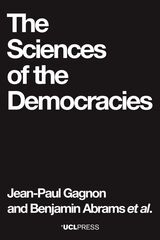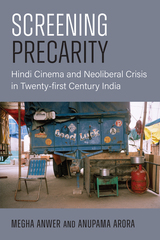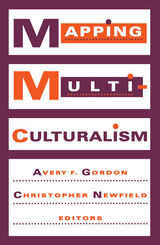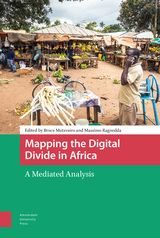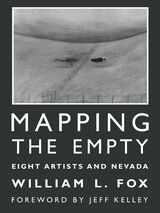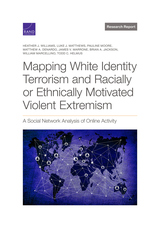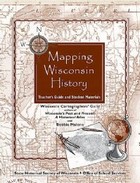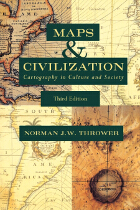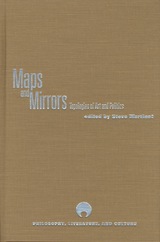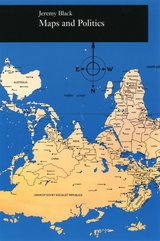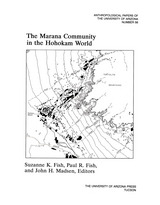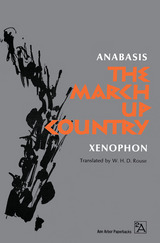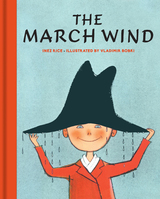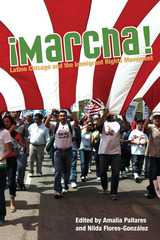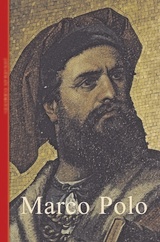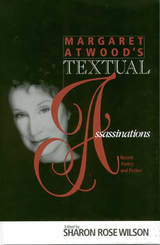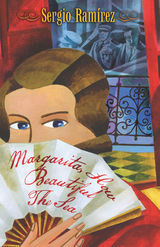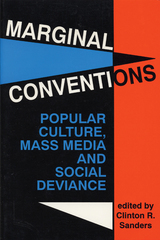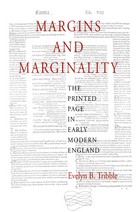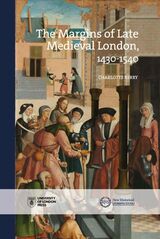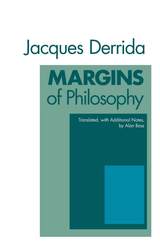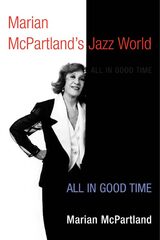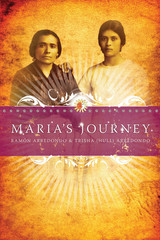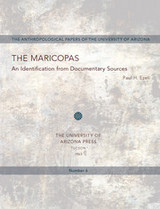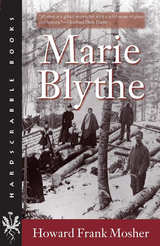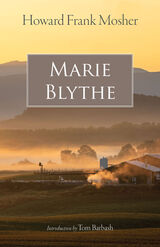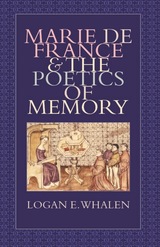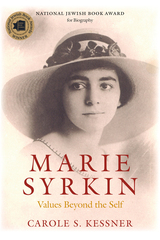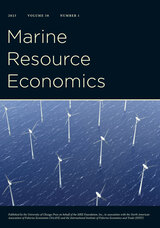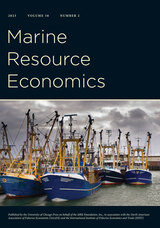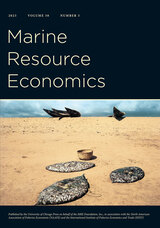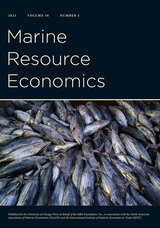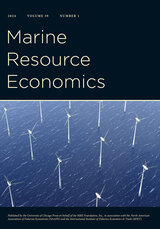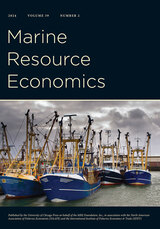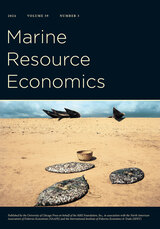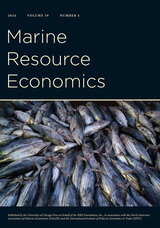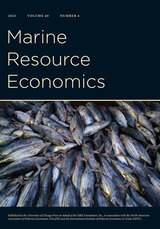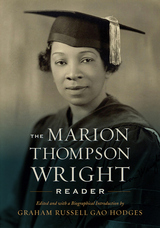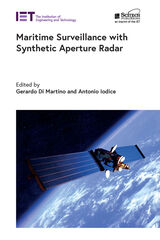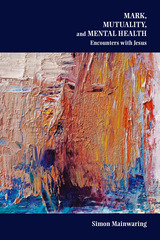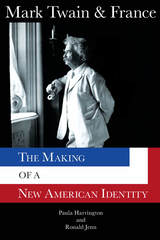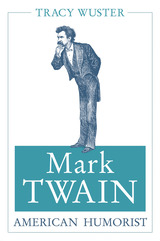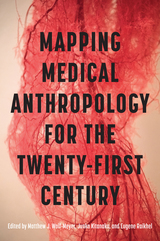 Mapping Medical Anthropology for the Twenty-First Century
Matthew J. Wolf-Meyer
Rutgers University Press, 2026 Mapping Medical Anthropology for the Twenty-First Century provides readers with a comprehensive survey of topics, methodologies, and theories in the discipline, drawing on contributions from leading anthropologists around the world. As a discipline, medical anthropology provides situational analysis of health, disease, and disability to show how the experiences of medical experts, patients, and their broader communities are informed by their social and cultural contexts. Adopting a keywords-driven approach, Mapping Medical Anthropology for the Twenty-First Century provides readers with an introduction to the concepts and approaches that have animated medical anthropology over the course of the twentieth century. Authors put these keywords into dialogue with their ethnographic and archival research to demonstrate how these concepts can be expanded to address contemporary phenomena related to health, disease, and disability. Mapping Medical for the Twenty-First Century provides newcomers to medical anthropology with a robust introduction to the discipline, while providing experienced readers a set of chapters that explore the discipline in novel and exciting ways.
 Mapping Michel Serres
Niran Abbas, Editor
University of Michigan Press, 2005 "Provides an extremely valuable introduction to the work of Michel Serres for an English-speaking audience, as well as offering useful critical approaches for those already familiar with its outlines."
---Robert Harrison, Stanford University [blurb from review pending permission]
The work of Michel Serres---including the books Hermes, The Parasite, The Natural Contract, Genesis, The Troubadour of Knowledge, and Conversations on Science, Culture, and Time---has stimulated readers for years, as it challenges the boundaries of science, literature, culture, language, and epistemology. The essays in Mapping Michel Serres, written by the leading interpreters of his work, offer perspectives from a range of disciplinary positions, including literature, language studies, and cultural theory. Contributors include Maria Assad, Hanjo Berressem, Stephen Clucas, Steven Connor, Andrew Gibson, René Girard, Paul Harris, Marcel Hénaff, William Johnsen, William Paulson, Marjorie Perloff, Philipp Schweighauser, Isabella Winkler, and Julian Yates.
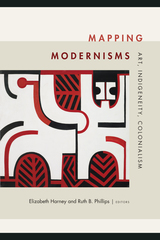 Mapping Modernisms: Art, Indigeneity, Colonialism
Elizabeth Harney and Ruth B. Phillips, editors
Duke University Press, 2018 Mapping Modernisms brings together scholars working around the world to address the modern arts produced by indigenous and colonized artists. Expanding the contours of modernity and its visual products, the contributors illustrate how these artists engaged with ideas of Primitivism through visual forms and philosophical ideas. Although often overlooked in the literature on global modernisms, artists, artworks, and art patrons moved within and across national and imperial borders, carrying, appropriating, or translating objects, images, and ideas. These itineraries made up the dense networks of modern life, contributing to the crafting of modern subjectivities and of local, transnationally inflected modernisms. Addressing the silence on indigeneity in established narratives of modernism, the contributors decenter art history's traditional Western orientation and prompt a re-evaluation of canonical understandings of twentieth-century art history. Mapping Modernisms is the first book in Modernist Exchanges, a multivolume project dedicated to rewriting the history of modernism and modernist art to include artists, theorists, art forms, and movements from around the world.
Contributors. Bill Anthes, Peter Brunt, Karen Duffek, Erin Haney, Elizabeth Harney, Heather Igloliorte, Sandra Klopper, Ian McLean, Anitra Nettleton, Chika Okeke-Agulu, Ruth B. Phillips, W. Jackson Rushing III, Damian Skinner, Nicholas Thomas, Norman Vorano
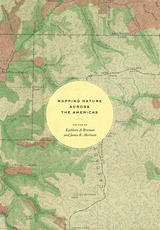 Mapping Nature across the Americas
Edited by Kathleen A. Brosnan & James R. Akerman
University of Chicago Press, 2021 Maps are inherently unnatural. Projecting three-dimensional realities onto two-dimensional surfaces, they are abstractions that capture someone’s idea of what matters within a particular place; they require selections and omissions. These very characteristics, however, give maps their importance for understanding how humans have interacted with the natural world, and give historical maps, especially, the power to provide rich insights into the relationship between humans and nature over time. That is just what is achieved in Mapping Nature across the Americas. Illustrated throughout, the essays in this book argue for greater analysis of historical maps in the field of environmental history, and for greater attention within the field of the history of cartography to the cultural constructions of nature contained within maps. This volume thus provides the first in-depth and interdisciplinary investigation of the relationship between maps and environmental knowledge in the Americas—including, for example, stories of indigenous cartography in Mexico, the allegorical presence of palm trees in maps of Argentina, the systemic mapping of US forests, and the scientific platting of Canada’s remote lands.
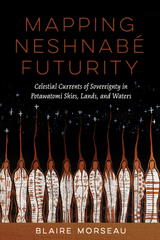 Mapping Neshnabé Futurity: Celestial Currents of Sovereignty in Potawatomi Skies, Lands, and Waters
Blaire Morseau; Foreword by Grace L. Dillon
University of Arizona Press, 2025 In Mapping Neshnabé Futurity Blaire Morseau weaves together on-the-ground insights and Indigenous speculative fiction to illustrate the profound ways in which Anishinaabé/Neshnabé (Potawatomi, Odawa, and Ojibwe) communities are reclaiming their sovereignty and crafting vibrant futures. Morseau lays out how Neshnabék have marshaled dissent to hydrologic fracturing, oil pipelines, and other damaging infrastructures of capitalist settler futurity. The book positions these efforts as vital acts of nation building and visionary reclamation of space, both terrestrial and celestial. Morseau also challenges the hegemonic narratives of settler futurism found in mainstream science fiction, which often perpetuate colonial fantasies and exclude marginalized voices. By fusing ethnography of tribal nation-building projects and analysis of Indigenous speculative fiction, Morseau provides a path to Indigenous futurisms and its role in imagining decolonization. Morseau’s analysis underscores the potency of Indigenous knowledge systems and ceremonial practices in imagining and actualizing alternative futures. Mapping Neshnabé Futurity is an essential read for scholars and activists alike, urging a rethinking of how we conceive of futurity and sovereignty. This work shows how counter-mapping projects both on the ground and in the skies reclaim space in the Great Lakes region—Neshnabé homelands—and are part of larger constellations of Indigenous futurities and stories of survivance.
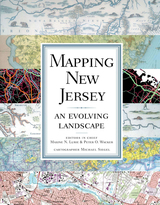 Mapping New Jersey: An Evolving Landscape
Maxine N. Lurie (Editor in Chief), and Peter O. Wacker (Editor in Chief), Michael Siegel (Cartographer)
Rutgers University Press, 2009 Mapping New Jersey is the first interpretive atlas of the state in more than one hundred years. New Jersey, small in size with only 4.8 million acres, has a long and complex background. Its past is filled with paradoxes and contradictionsùan agricultural economy for most of its history, New Jersey was also one of the earliest states to turn to manufacturing and chemical research. Today, still championing itself as the "Garden State," New Jersey claims both the highest population density in the country and the largest number of hazardous waste sites. Many see an asphalt oasis, from the New Jersey Turnpike to the Garden State Parkway, with cities that sprawl into adjacent suburbs. Yet, after hundreds of years, large areas of New Jersey remain home to horse farms, cornfields, orchards, nurseries, blueberry bushes, and cranberry bogs. Tracing the changes in environment, land use patterns, demography, transportation, economy, and politics over the course of many centuries, Mapping New Jerseyilluminates the state's transformation from a simple agricultural society to a post-industrial and culturally diverse place inhabited by more people per acre than anywhere else in the country. An innovator in transportation, from railroads to traffic circles to aviation, New Jersey from its beginnings was a "corridor" state, with a dense Native American trail system once crisscrossed on foot, country roads traveled by armies of the American Revolution, and, lately, the rolling wheels of many sedans, SUVs, hybrids, public and commercial vehicles, and freight. Early to industrialize, it also served as the headquarters for Thomas Edison and the development of the modern American economy. Small in territory and crowded with people, the state works to recycle garbage and, at the same time, best utilize and preserve its land. New Jersey has been depicted in useful and quite stunning historical maps, many of the best included in Mapping New Jerseyùcrude maps drawn by sixteenth-century navigators; complex and beautifully decorated pieces created by early Dutch cartographers; land maps plotted by seventeenth-century English settlement surveyors; examples of the nineteenth century's scientific revolution in map making that helped locate topography and important mineral resources; detailed insurance maps that correct London map maker William Faden's 1777-78 classic rendering of the state; and aerial photos, remote sensing, and global positioning system maps generated through twenty-first-century technology breakthroughs in cartography. Integrating new maps, graphs, and diagrams unavailable through ordinary research or Internet searches, Mapping New Jersey is divided into six topical chapters, each accompanied by an introduction and overview telling the story of the state's past and detailing its diversity. Mapping New Jersey, dramatically bold and in full color, travels where New Jersey has gone and the rest of the nation is likely to follow.
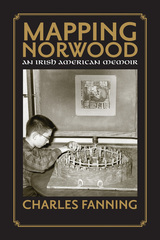 Mapping Norwood: An Irish-American Memoir
Charles Fanning
University of Massachusetts Press, 2010 As the title indicates, this memoir is an act of map making, of plotting out overlapping territories—topographical, temporal, and psychological. Centered on family life in a Massachusetts town from the 1920s to the 1960s, the author's investigation extends outward to include the Boston area from colonial times to the recent past, encounters with Boston's Museum of Fine Arts and with Harvard College, the American Civil War, and Ireland and Germany in the nineteenth century.Charles Fanning re-creates the landscape of childhood and adolescence in a place and time both ordinary and rich with possibility. An expert on Irish immigration, he was born and raised in Norwood, Massachusetts, twelve miles outside of Boston, where Yankee and Irish cultures bumped against each other. The narrative traces his personal growth, shaped by family, school, baseball, radio drama, and art. He was the first in his family to attend college, and the book ends with his undergraduate experience at Harvard, class of 1964.Along with this coming-of-age story, Mapping Norwood features forays back in time, including chapters on each of Fanning's parents and historical excavations and meditations on three ancestors. Guided by his own experience as a scholar, the pressure of these chapters is epistemological—the thrill of the hunt toward knowing. Fanning's great-grandfather, John Fanning, disappeared from the family in the late 1880s, and a chapter chronicles the discovery of "Walking John's" fifty years of hidden later life in East St. Louis, Illinois, where he died alone in 1946. Fanning's great-great-grandfather, Winslow Radcliffe, was a veteran of the 35th Massachusetts Infantry in the Civil War, and the author traces this regiment through the horrors of Antietam and Fredericksburg, by means of diaries and letters by four men from Winslow's company. The evidence gleaned helps explain Winslow's suicide after the war. An Irish immigrant ancestor, Phillip Fanning, came to Boston from County Monaghan just after the Great Famine of the late 1840s. Relying on historical research, Fanning imagines vividly the lives led by Phillip's family and thousands like them in the wake of Ireland's nineteenth-century catastrophe.
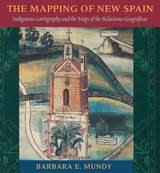 The Mapping of New Spain: Indigenous Cartography and the Maps of the Relaciones Geograficas
Barbara E. Mundy
University of Chicago Press, 1996 To learn about its territories in the New World, Spain commissioned a survey of Spanish officials in Mexico between 1578 and 1584, asking for local maps as well as descriptions of local resources, history, and geography. In The Mapping of New Spain, Barbara Mundy illuminates both the Amerindian (Aztec, Mixtec, and Zapotec) and the Spanish traditions represented in these maps and traces the reshaping of indigene world views in the wake of colonization.
"Its contribution to its specific field is both significant and original. . . . It is a pure pleasure to read." —Sabine MacCormack, Isis
"Mundy has done a fine job of balancing the artistic interpretation of the maps with the larger historical context within which they were drawn. . . . This is an important work." —John F. Schwaller, Sixteenth Century Journal
"This beautiful book opens a Pandora's box in the most positive sense, for it provokes the reconsideration of several long-held opinions about Spanish colonialism and its effects on Native American culture." —Susan Schroeder, American Historical Review
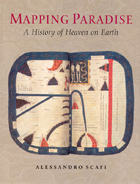 Mapping Paradise: A History of Heaven on Earth
Alessandro Scafi
University of Chicago Press, 2006 Throughout history, humans have searched for paradise. When early Christians adopted the Hebrew Bible, and with it the story of Genesis, the Garden of Eden became an idyllic habitat for all mankind. Medieval Christians believed this paradise was a place on earth, different from this world and yet part of it, situated in real geography and indicated on maps. From the Renaissance through the Enlightenment, the mapping of paradise validated the authority of holy scripture and supported Christian faith. But from the early nineteenth century onwards, the question of the exact location of paradise was left not to theologians but to the layman. And at the beginning of the twenty-first century, there is still no end to the stream of theories on the location of the former Garden of Eden.
Mapping Paradise is a history of the cartography of paradise that journeys from the beginning of Christianity to the present day. Instead of dismissing the medieval belief in a paradise on earth as a picturesque legend and the cartography of paradise as an example of the period’s many superstitions, Alessandro Scafi explores the intellectual conditions that made the medieval mapping of paradise possible. The challenge for mapmakers, Scafi argues, was to make visible a place that was geographically inaccessible and yet real, remote in time and yet still the scene of an essential episode of the history of salvation. Mapping Paradise also accounts for the transformations, in both theological doctrine and cartographical practice, that brought about the decline of the belief in a terrestrial paradise and the emergence of the new historical and regional mapping of the Garden of Eden that began at the time of the Reformation and still continues today.
The first book to show how paradise has been expressed in cartographic form throughout two millennia, Mapping Paradise reveals how the most deeply reflective thoughts about the ultimate destiny of all human life have been molded and remolded, generation by generation.
 Mapping Post-War Italian Literature: Boom and Aftermath (1956–1979)
Giulia Brecciaroli
University of London Press, 2024 An investigation of the effects of the Reconstruction period on Italian writers’ literary tellings of the social and economic metamorphosis of Italy.
In the aftermath of the Reconstruction era, immediately after the Second World War, Italy experienced an unprecedented phase of economic development, which transformed it from a traditionally agricultural and impoverished country into one of Europe’s most industrialized nations. The idea, treasured to this day by many Italians, that this period represents a golden age has been increasingly called into question by historical research that has unveiled the evident contradictions of Italian society at the time.
Mapping Post-War Italian Literature examines the “boom years” and their legacy to explore the long-lasting impact of post-war Italy’s urbanization and modernization on the imagination of Italian writers. Brecciaroli looks at how transformations affecting Italy’s leading industrial cities of the North, specifically Milan and Turin, as well as the provinces have been conceptualized in contemporary novels and travel accounts. The selected texts cross genre boundaries and reflect an array of literary perspectives, giving a compelling and multifaceted account of the post-war historical transition.
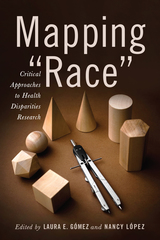 Mapping "Race": Critical Approaches to Health Disparities Research
Gómez, Laura E
Rutgers University Press, 2013 Researchers commonly ask subjects to self-identify their race from a menu of preestablished options. Yet if race is a multidimensional, multilevel social construction, this has profound methodological implications for the sciences and social sciences. Race must inform how we design large-scale data collection and how scientists utilize race in the context of specific research questions. This landmark collection argues for the recognition of those implications for research and suggests ways in which they may be integrated into future scientific endeavors. It concludes on a prescriptive note, providing an arsenal of multidisciplinary, conceptual, and methodological tools for studying race specifically within the context of health inequalities. Contributors: John A. Garcia, Arline T. Geronimus, Laura E. Gómez, Joseph L. Graves Jr., Janet E. Helms, Derek Kenji Iwamoto, Jonathan Kahn, Jay S. Kaufman, Mai M. Kindaichi, Simon J. Craddock Lee, Nancy López, Ethan H. Mereish, Matthew Miller, Gabriel R. Sanchez, Aliya Saperstein, R. Burciaga Valdez, Vicki D. Ybarra
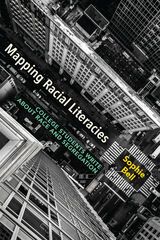 Mapping Racial Literacies: College Students Write about Race and Segregation
Sophie R. Bell
Utah State University Press, 2020 Early college classrooms provide essential opportunities for students to grapple and contend with the racial geographies that shape their lives. Based on a mixed methods study of students’ writing in a first-year-writing course themed around racial identities and language varieties at St. John’s University, Mapping Racial Literacies shows college student writing that directly confronts lived experiences of segregation—and, overwhelmingly, of resegregation.
This textual ethnography embeds early college students’ writing in deep historical and theoretical contexts and looks for new ways that their writing contributes to and reshapes contemporary understandings of how US and global citizens are thinking about race. The book is a teaching narrative, tracing a teaching journey that considers student writing not only in the moments it is assigned but also in continual revisions of the course, making it a useful tool in helping college-age students see, explore, and articulate the role of race in determining their life experiences and opportunities.
Sophie Bell’s work narrates the experiences of a white teacher making mistakes in teaching about race and moving forward through those mistakes, considering that process valuable and, in fact, necessary. Providing a model for future scholars on how to carve out a pedagogically responsive identity as a teacher, Mapping Racial Literacies contributes to the scholarship on race and writing pedagogy and encourages teachers of early college classes to bring these issues front and center on the page, in the classroom, and on campus.
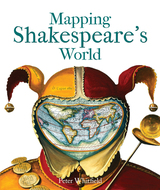 Mapping Shakespeare's World
Peter Whitfield
Bodleian Library Publishing, 2015 Shakespeare never set a play in his own Elizabethan London. From the castle in Elsinore where Hamlet avenges his father’s death to Cleopatra’s Alexandria at the height of the Roman Empire to the seaport town in Cyprus where we await the arrival of Othello, each of Shakespeare’s plays is set in a time or space remote from his primary audience. Why is this? How much did the Bard and his contemporaries know about the foreign lands his characters often inhabit? What expectations did an audience have if the curtains rose on a play which claimed to take place in ancient Troy or the Pyrenean kingdom of Navarre in northern Spain?
Mapping Shakespeare’s World explores these questions with surprising results. It has often been said that setting is irrelevant to Shakespeare’s plays—that, wherever they are set, their enduring appeal lies in their ability to speak to broad questions of human nature. Peter Whitfield shows that, on the contrary, many of Shakespeare’s locations were carefully chosen for their ability to convey subtle meanings an Elizabethan audience would have picked up on and understood. Through the use of paintings, drawings, contemporary maps and geographical texts, Whitfield suggests answers to such questions as where Illyria was located, why The Merry Wives of Windsor could only have taken place in Windsor, and how two utterly different comedies—The Comedy of Errors and Pericles, Prince of Tyre—both came to take place in ancient Ephesus.
Just when one might think there was nothing more to be said about Shakespeare, with Mapping Shakespeare’s World, Whitfield offers a fascinating new point of view.
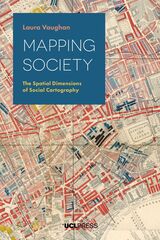 Mapping Society: The Spatial Dimensions of Social Cartography
Laura Vaughan
University College London, 2018 From a rare map of yellow fever in eighteenth-century New York to Charles Booth’s famous maps of poverty in nineteenth-century London, an Italian racial zoning map of early twentieth-century Asmara, and a map of wealth disparities in the banlieues of twenty-first-century Paris, Mapping Society traces the evolution of social cartography over the past two centuries. In this richly illustrated book, Laura Vaughan examines maps of ethnic or religious difference, poverty, and health inequalities, demonstrating how they not only serve as historical records of social enquiry but also constitute inscriptions of social patterns that have been etched deeply on the surface of cities. The book covers themes such as the use of visual rhetoric to change public opinion, the evolution of sociology as an academic practice, changing attitudes to physical disorder, and the complexity of segregation as an urban phenomenon. While the focus is on historical maps, the narrative carries the discussion of the spatial dimensions of social cartography forward to the present day, showing how disciplines such as public health, criminology, and urban planning chart spatial data in their current practice.
Mapping the Digital Divide in Africa: A Mediated Analysis
Bruce Mutsvairo
Amsterdam University Press, 2019 Despite issues associated with the digital divide, mobile telephony is growing on the continent and the rise of smartphones has given citizens easy access to social networking sites. But the digital divide, which mostly reflects on one's race, gender, socioeconomic status or geographical location, stands in the way of digital progress. What opportunities are available to tame digital disparities? How are different societies in Africa handling digital problems? What innovative methods are being used to provide citizens with access to critical information that can help improve their lives? Experiences from various locations in several sub-Saharan African countries have been carefully selected in this collection with the aim of providing an updated account on the digital divide and its impact in Africa.
Mapping The Empty: Eight Artists And Nevada
William L. Fox
University of Nevada Press, 1999 Foreword by Jeff Kelley. Nevada's open spaces have long inspired complex responses from a population largely shaped by European sensibilities toward land and its uses. In Mapping the Empty Fox considers how eight of the state's most distinguished and innovative contemporary artists have responded to the harsh, enigmatic landscapes of the Great Basin and how, through their work, they have expressed and helped to define our attitudes toward the space we call the West. The artists are Jim McCormick, Rita Deanin Abbey, Dennis Parks, Walter McNamara, Robert Beckmann, Michael Heizer, Bill Barker, and Mary Ann Bonjorni.
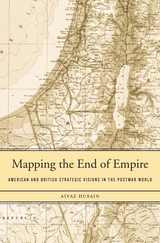 Mapping the End of Empire: American and British Strategic Visions in the Postwar World
Aiyaz Husain
Harvard University Press, 2014 By the end of World War II, strategists in Washington and London looked ahead to a new era in which the United States shouldered global responsibilities and Britain concentrated its regional interests more narrowly. The two powers also viewed the Muslim world through very different lenses. Mapping the End of Empire reveals how Anglo–American perceptions of geography shaped postcolonial futures from the Middle East to South Asia.
Aiyaz Husain shows that American and British postwar strategy drew on popular notions of geography as well as academic and military knowledge. Once codified in maps and memoranda, these perspectives became foundations of foreign policy. In South Asia, American officials envisioned an independent Pakistan blocking Soviet influence, an objective that outweighed other considerations in the contested Kashmir region. Shoring up Pakistan meshed perfectly with British hopes for a quiescent Indian subcontinent once partition became inevitable. But serious differences with Britain arose over America’s support for the new state of Israel. Viewing the Mediterranean as a European lake of sorts, U.S. officials—even in parts of the State Department—linked Palestine with Europe, deeming it a perfectly logical destination for Jewish refugees. But British strategists feared that the installation of a Jewish state in Palestine could incite Muslim ire from one corner of the Islamic world to the other.
As Husain makes clear, these perspectives also influenced the Dumbarton Oaks Conference and blueprints for the UN Security Council and shaped French and Dutch colonial fortunes in the Levant and the East Indies.
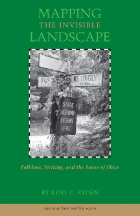 Mapping the Invisible Landscape: Folklore, Writing, and the Sense of Place
Kent C. Ryden
University of Iowa Press, 1993 Any landscape has an unseen component: a subjective component of experience, memory, and narrative which people familiar with the place understand to be an integral part of its geography but which outsiders may not suspect the existence of—unless they listen and read carefully. This invisible landscape is make visible though stories, and these stories are the focus of this engrossing book. Traveling across the invisible landscape in which we imaginatively dwell, Kent Ryden—himself a most careful listener and reader—asks the following questions. What categories of meaning do we read into our surroundings? What forms of expression serve as the most reliable maps to understanding those meanings? Our sense of any place, he argues, consists of a deeply ingrained experiential knowledge of its physical makeup; an awareness of its communal and personal history; a sense of our identity as being inextricably bound up with its events and ways of life; and an emotional reaction, positive or negative, to its meanings and memories. Ryden demonstrates that both folk and literary narratives about place bear a striking thematic and stylistic resemblance. Accordingly, Mapping the Invisible Landscape examines both kinds of narratives. For his oral materials, Ryden provides an in-depth analysis of narratives collected in the Coeur d'Alene mining district in the Idaho panhandle; for his consideration of written works, he explores the “essay of place,” the personal essay which takes as its subject a particular place and a writer's relationship to that place. Drawing on methods and materials from geography, folklore, and literature, Mapping the Invisible Landscape offers a broadly interdisciplinary analysis of the way we situate ourselves imaginatively in the landscape, the way we inscribe its surface with stories. Written in an extremely engaging style, this book will lead its readers to an awareness of the vital role that a sense of place plays in the formation of local cultures, to an understanding of the many-layered ways in which place interacts with individual lives, and to renewed appreciation of the places in their own lives and landscapes.
Mapping the Moral Domain: A Contribution of Women’s Thinking to Psychological Theory and Education
Carol Gilligan
Harvard University Press, 1988 In the fourteen articles collected in this volume, Carol Gilligan and her colleagues expand the theoretical base of In a Different Voice and apply their research methods to a variety of life situations. The contrasting voices of justice and care clarify different ways in which women and men speak about relationships and lend different meanings to connection, dependence, autonomy, responsibility loyalty, peer pressure, and violence. By examining the moral dilemmas and self-descriptions of children, high school students, urban youth, medical students, mothers, lawyers, and others, the authors chart a new terrain: a mapping of the moral domain that includes the voices of women. In this new terrain the authors trace far-reaching implications of the inclusion of women’s voices for developmental psychology, for education, for women, and for men.
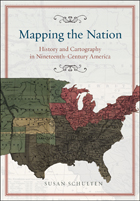 Mapping the Nation: History and Cartography in Nineteenth-Century America
Susan Schulten
University of Chicago Press, 2012 In the nineteenth century, Americans began to use maps in radically new ways. For the first time, medical men mapped diseases to understand and prevent epidemics, natural scientists mapped climate and rainfall to uncover weather patterns, educators mapped the past to foster national loyalty among students, and Northerners mapped slavery to assess the power of the South. After the Civil War, federal agencies embraced statistical and thematic mapping in order to profile the ethnic, racial, economic, moral, and physical attributes of a reunified nation. By the end of the century, Congress had authorized a national archive of maps, an explicit recognition that old maps were not relics to be discarded but unique records of the nation’s past. All of these experiments involved the realization that maps were not just illustrations of data, but visual tools that were uniquely equipped to convey complex ideas and information. In Mapping the Nation, Susan Schulten charts how maps of epidemic disease, slavery, census statistics, the environment, and the past demonstrated the analytical potential of cartography, and in the process transformed the very meaning of a map. Today, statistical and thematic maps are so ubiquitous that we take for granted that data will be arranged cartographically. Whether for urban planning, public health, marketing, or political strategy, maps have become everyday tools of social organization, governance, and economics. The world we inhabit—saturated with maps and graphic information—grew out of this sea change in spatial thought and representation in the nineteenth century, when Americans learned to see themselves and their nation in new dimensions.
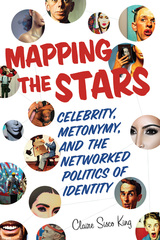 Mapping the Stars: Celebrity, Metonymy, and the Networked Politics of Identity
Claire Sisco King
Ohio State University Press, 2023 Often dismissed as trivial or even “trash,” celebrity culture offers a unique way of considering what it means to be human. In Mapping the Stars, Claire Sisco King shows how close analysis of the complex and sometimes contradictory forms of celebrity culture can challenge dominant ideas about selfhood. In particular, as a formation that develops across time, mediums, and texts, celebrity is useful for demonstrating how humanness is defined by relationality, contingency, and even vulnerability. King considers three stars with popular and controversial personas: Norman Rockwell, Will Smith, and Kim Kardashian. Working in very different contexts and with very different public images, these figures nonetheless share a consistent, if not conspicuous, interest in celebrity as a construct. Offering intertextual readings of their public images across such sites as movie posters, magazines, cinema, and social media—and deploying rhetorical theories of metonymy (a linguistic device linking signifiers by shared associations)—King argues that these stars’ self-reflexive attention to the processes by which celebrity is created and constrained creates opportunities for reframing public discourse about what it means to be famous and what it means to be a person.
 Mapping the State: English Boundaries and the 1832 Reform Act
Martin Spychal
University of London Press, 2024 A study of the 1832 Reform Act and its significance to the modern British state.
The 1832 Reform Act was a landmark moment in the development of modern British politics. By overhauling the country’s ancient representative system, the legislation reshaped constitutional arrangements at Westminster, reinvigorated political relationships between the center and the provinces, and established the political structures and precedents that both shaped and hindered Britain’s slow lurch towards democracy by 1928.
Mapping the State leads to a fundamental rethinking of the 1832 Reform Act by demonstrating how boundary reform and the reconstruction of England’s electoral map by the little-known 1831–1832 boundary commission underpinned this turning point in the development of the British political nation. Eschewing traditional approaches to the 1832 Reform Act, it draws from a significant new archival discovery—the working papers of the boundary commission—and a range of innovative quantitative techniques to provide a major reassessment of why and how the 1832 Reform Act passed, its impact on reformed politics both at Westminster and in the constituencies, and its significance to the expansion of the modern British state.
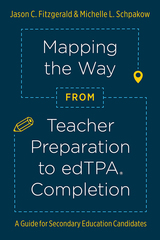 Mapping the Way from Teacher Preparation to edTPA® Completion: A Guide for Secondary Education Candidates
Jason C. Fitzgerald
Rutgers University Press, 2021 As nationwide calls for educational rigor and accountability continue across the U.S., many states have made the edTPA®, a teacher performance assessment, a requirement for teacher certification. The edTPA® is a subject-specific performance assessment that requires aspiring teachers to plan, implement, assess, and reflect upon a learning segment, while demonstrating pedagogical skills related to their disciplines. While it is designed to promote teaching excellence, the edTPA® can drive already-stressed teacher candidates to their breaking point, as it places them in an unfamiliar classroom and asks them to quickly display their knowledge and savvy.
This book is here to help teacher candidates not only survive the challenge of the edTPA®, but also thrive. It maps out precisely what steps aspiring secondary education teachers should take to ensure successful completion of the edTPA®. Demystifying the language used in the assessment, it uniquely connects edTPA® requirements with what teacher candidates learn within their teacher preparation programs, showing them how the assessment relates to what they are already doing in their classrooms. The strategies in this book draw on both academic research and practical experience to guide student teachers as they plan for their edTPA® portfolios and for their teaching careers beyond.
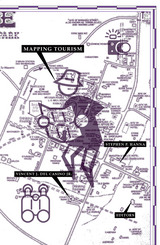 Mapping Tourism
Stephen P. Hanna
University of Minnesota Press, 2003 Looks at tourism maps to offer new insights into the social construction of place At first glance, the relationships among tourists, tourism maps, and the spaces of tourism seem straightforward enough: tourists use maps to find their way to and through the sites of history, culture, nature, or recreation represented there. Less apparent is how tourism maps and those using them construct such spaces and identities. As the essays in Mapping Tourism clearly demonstrate, the extraordinary interactions of work with leisure and the everyday with the exotic make tourism maps ideal sites for exploring the contested construction of place and identity. Construction sites in the “New Berlin,” Alabama’s civil rights trail, Québec City, a California ghost town, and Bangkok’s sex trade are among the spaces the essays examine. Taken together, these essays allow us to see tourist space as it truly is: contested, ever changing, and replete with issues of power.Contributors: Mary Curran, Eastern Connecticut State U; Dydia DeLyser, Louisiana State U; Owen J. Dwyer, Indiana U; John R. Gold, Oxford Brookes U; Margaret M. Gold, U of North London; Rob Shields; Karen E. Till, U of Minnesota.
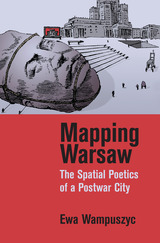 Mapping Warsaw: The Spatial Poetics of a Postwar City
Ewa Wampuszyc
Northwestern University Press, 2018 Inspired by the spatial turn in the humanities and social sciences, Mapping Warsaw is an interdisciplinary study that combines urban studies, cinema studies, cultural studies, history, literature, and photography. It examines Warsaw's post-World War II reconstruction through images and language.
Juxtaposing close readings of photo books, socialist-era newsreels called the Polska Kronika Filmowa, the comedies of Leonard Buczkowski and Jan Fethke, the writing and films of Tadeusz Konwicki, and a case study on the Palace of Culture and Science—a "gift" from none other than Stalin—this study investigates the rhetorical and visual, rather than physical, reconstruction of Warsaw in various medias and genres.
Ewa Wampuszyc roots her analysis in the historical context of the postwar decade and shows how and why Poland's capital became an essential part of a propaganda program inspired by communist ideology and the needs of a newly established socialist People's Republic. Mapping Warsaw demonstrates how physical space manifests itself in culture, and how culture, history, and politics leave an indelible mark on places. It points out ways in which we take for granted our perception of space and the meanings we assign to it.
Mapping Wisconsin History: Teacher's Guide and Student Materials
Wisconsin Cartographers' Guild
Wisconsin Historical Society Press, 2000 The joy of maps abounds in this set of exciting classroom materials from the Wisconsin Historical Society's Office of School Services and the Wisconsin Cartographers' Guild, creators of the best-selling book, Wisconsin's Past and Present: A Historical Atlas. For use either independently or as a companion to the Atlas, this publication includes seven color transparencies depicting: landscape and glaciation; American Indians; migration and ethnic settlement; cities and counties; mining; timber; agriculture; and industry and transportation. Background information and classroom activities, as well as reproducible worksheets and blackline transparencies, give educators the opportunity to explore and integrate Wisconsin history and geography with students from grades four and up.
 Mapping Wonderlands: Illustrated Cartography of Arizona, 1912–1962
Dori Griffin
University of Arizona Press, 2013 Though tourism now plays a recognized role in historical research and regional studies, the study of popular touristic images remains sidelined by chronological histories and objective statistics. Further, Arizona remains underexplored as an early twentieth-century tourism destination when compared with nearby California and New Mexico. With the notable exception of the Grand Canyon, little has been written about tourism in the early days of Arizona’s statehood.
Mapping Wonderlands fills part of this gap in existing regional studies by looking at early popular pictorial maps of Arizona. These cartographic representations of the state utilize formal mapmaking conventions to create a place-based state history. They introduce illustrations, unique naming conventions, and written narratives to create carefully visualized landscapes that emphasize the touristic aspects of Arizona.
Analyzing the visual culture of tourism in illuminating detail, this book documents how Arizona came to be identified as an appealing tourism destination. Providing a historically situated analysis, Dori Griffin draws on samples from a comprehensive collection of materials generated to promote tourism during Arizona’s first half-century of statehood. She investigates the relationship between natural and constructed landscapes, visual culture, and narratives of place. Featuring sixty-six examples of these aesthetically appealing maps, the book details how such maps offered tourists and other users a cohesive and storied image of the state. Using historical documentation and rhetorical analysis, this book combines visual design and historical narrative to reveal how early-twentieth-century mapmakers and map users collaborated to imagine Arizona as a tourist’s paradise.
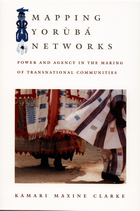 Mapping Yorùbá Networks: Power and Agency in the Making of Transnational Communities
Kamari Maxine Clarke
Duke University Press, 2004 Three flags fly in the palace courtyard of Òyótúnjí African Village. One represents black American emancipation from slavery, one black nationalism, and the third the establishment of an ancient Yorùbá Empire in the state of South Carolina. Located sixty-five miles southwest of Charleston, Òyótúnjí is a Yorùbá revivalist community founded in 1970. Mapping Yorùbá Networks is an innovative ethnography of Òyótúnjí and a theoretically sophisticated exploration of how Yorùbá òrìsà voodoo religious practices are reworked as expressions of transnational racial politics. Drawing on several years of multisited fieldwork in the United States and Nigeria, Kamari Maxine Clarke describes Òyótúnjí in vivid detail—the physical space, government, rituals, language, and marriage and kinship practices—and explores how ideas of what constitutes the Yorùbá past are constructed. She highlights the connections between contemporary Yorùbá transatlantic religious networks and the post-1970s institutionalization of roots heritage in American social life. Examining how the development of a deterritorialized network of black cultural nationalists became aligned with a lucrative late-twentieth-century roots heritage market, Clarke explores the dynamics of Òyótúnjí Village’s religious and tourist economy. She discusses how the community generates income through the sale of prophetic divinatory consultations, African market souvenirs—such as cloth, books, candles, and carvings—and fees for community-based tours and dining services. Clarke accompanied Òyótúnjí villagers to Nigeria, and she describes how these heritage travelers often returned home feeling that despite the separation of their ancestors from Africa as a result of transatlantic slavery, they—more than the Nigerian Yorùbá—are the true claimants to the ancestral history of the Great Òyó Empire of the Yorùbá people. Mapping Yorùbá Networks is a unique look at the political economy of homeland identification and the transnational construction and legitimization of ideas such as authenticity, ancestry, blackness, and tradition.
Maps and Civilization: Cartography in Culture and Society, Third Edition
Norman J. W. Thrower
University of Chicago Press, 2008 In this concise introduction to the history of cartography, Norman J. W. Thrower charts the intimate links between maps and history from antiquity to the present day. A wealth of illustrations, including the oldest known map and contemporary examples made using Geographical Information Systems (GIS), illuminate the many ways in which various human cultures have interpreted spatial relationships.
The third edition of Maps and Civilization incorporates numerous revisions, features new material throughout the book, and includes a new alphabetized bibliography.
Praise for previous editions of Maps and Civilization:
“A marvelous compendium of map lore. Anyone truly interested in the development of cartography will want to have his or her own copy to annotate, underline, and index for handy referencing.”—L. M. Sebert, Geomatica
Maps And History In South-West England
Edited by Roger Kain and Katherine Barker
University of Exeter Press, 1991
This volume of essays considers the practical and political purposes for which maps were used, the symbolic and ideological roles of maps in the history of South-Western England and the ways in which map evidence can be used to recover facts about the past for use in the writing of history. The text is accompanied by 43 pages of maps and illustrations.
Maps and Mirrors: Topologies of Art and Politics
Steve Martinot
Northwestern University Press, 2001 Maps and Mirrors explores the links and gaps between the aesthetic and the political at the intersection of philosophy and literature. Testing the major voices of aesthetic and literary theory, it raises important questions about the implicit political contexts and commitments of thinkers from Kant to de Man. Taken together the essays provide a tour of the complexities and richness of contemporary modes of critique.
Maps and Politics
Jeremy Black
University of Chicago Press, 1997 Do maps accurately and objectively present the information we expect them to portray, or are they instead colored by the political purposes of their makers? In this lively and well-illustrated book, Jeremy Black investigates this dangerous territory, arguing persuasively that the supposed "objectivity" of the map-making and map-using process cannot be divorced from aspects of the politics of representation.
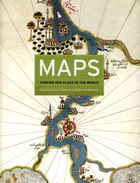 Maps: Finding Our Place in the World
Edited by James R. Akerman and Robert W. Karrow Jr.
University of Chicago Press, 2007 Maps are universal forms of communication, easily understood and appreciated regardless of culture or language. This truly magisterial book introduces readers to the widest range of maps ever considered in one volume: maps from different time periods and a variety of cultures; maps made for divergent purposes and depicting a range of environments; and maps that embody the famous, the important, the beautiful, the groundbreaking, or the amusing. Built around the functions of maps—the kinds of things maps do and have done—Maps confirms the vital role of maps throughout history in commerce, art, literature, and national identity.
The book begins by examining the use of maps for wayfinding, revealing that even maps as common and widely used as these are the product of historical circumstances and cultural differences. The second chapter considers maps whose makers employed the smallest of scales to envision the broadest of human stages—the world, the heavens, even the act of creation itself. The next chapter looks at maps that are, literally, at the opposite end of the scale from cosmological and world maps—maps that represent specific parts of the world and provide a close-up view of areas in which their makers lived, worked, and moved.
Having shown how maps help us get around and make sense of our greater and lesser worlds, Maps then turns to the ways in which certain maps can be linked to particular events in history, exploring how they have helped Americans, for instance, to understand their past, cope with current events, and plan their national future. The fifth chapter considers maps that represent data from scientific instruments, population censuses, and historical records. These maps illustrate, for example, how diseases spread, what the ocean floor looks like, and how the weather is tracked and predicted. Next comes a turn to the imaginary, featuring maps that depict entire fictional worlds, from Hell to Utopia and from Middle Earth to the fantasy game World of Warcraft. The final chapter traces the origins of map consumption throughout history and ponders the impact of cartography on modern society.
A companion volume to the most ambitious exhibition on the history of maps ever mounted in North America, Maps will challenge readers to stretch conventional thought about what constitutes a map and how many different ways we can understand graphically the environment in which we live. Collectors, historians, mapmakers and users, and anyone who has ever “gotten lost” in the lines and symbols of a map will find much to love and learn from in this book.
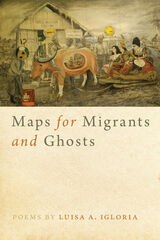 Maps for Migrants and Ghosts
Luisa A. Igloria
Southern Illinois University Press, 2020 Language as key and map to places, people, and histories lost
For immigrants and migrants, the wounds of colonization, displacement, and exile remain unhealed. Crossing oceans and generations, from her childhood home in Baguio City, the Philippines, to her immigrant home in Virginia, poet Luisa A. Igloria demonstrates how even our most personal and intimate experiences are linked to the larger collective histories that came before.
In this poetry collection, Igloria brings together personal and family histories, ruminates on the waxing and waning of family fortunes, and reminds us how immigration necessitates and compels transformations. Simultaneously at home and displaced in two different worlds, the speaker lives in the past and the present, and the return to her origins is fraught with disappointment, familiarity, and alienation.
Language serves as a key and a map to the places and people that have been lost. This collection folds memories, encounters, portraits, and vignettes, familiar and alien, into both an individual history and a shared collective history—a grandfather’s ghost stubbornly refusing to come in out of the rain, an elderly mother casually dropping YOLO into conversation, and the speaker’s abandonment of her childhood home for a second time.
The poems in this collection spring out of a deep longing for place, for the past, for the selves we used to be before we traveled to where we are now, before we became who we are now. A stunning addition to the work of immigrant and migrant women poets on their diasporas, Maps for Migrants and Ghosts reveals a dream landscape at the edge of this world that is always moving, not moving, changing, and not changing.
 Maps in Tudor England
P. D. A. Harvey
University of Chicago Press, 1993 In the England of 1500 maps were rare objects, little used or understood. By 1600 they had become a familiar part of everyday life, created and used for practical purposes, woven into tapestries, illustrating bibles, and even printed on playing cards.
In Maps in Tudor England, P. D. A. Harvey traces this revolution of production, understanding, and use of maps in England from 1485 to 1603. By the mid-sixteenth century, mapmapers had begun to draw maps to a consistent scale, reproducing the results of measured survey. By the end of the century, maps drawn to scale and showing features by conventional signs were commonly used throughout England.
In this survey Harvey focuses on maps of small areas, up to the size of a county, exploring their impact on the political and social life of England in the spheres of the military, government, towns, landed estates, buildings, and the law. Richly illustrated with thirty color and fifty black and white reproductions of rare maps, his account is an informative and accessible introduction to this revolutionary period in the history of cartography, as well as a unique visual history of Tudor England.
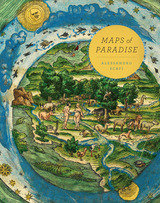 Maps of Paradise
Alessandro Scafi
University of Chicago Press, 2013 Where is paradise? It always seems to be elsewhere, inaccessible, outside of time. Either it existed yesterday or it will return tomorrow; it may be just around the corner, on a remote island, beyond the sea. Across a wide range of cultures, paradise is located in the distant past, in a longed-for future, in remote places or within each of us. In particular, people everywhere in the world share some kind of nostalgia for an innocence experienced at the beginning of history. For two millennia, learned Christians have wondered where on earth the primal paradise could have been located. Where was the idyllic Garden of Eden that is described in the Bible? In the Far East? In equatorial Africa? In Mesopotamia? Under the sea? Where were Adam and Eve created in their unspoiled perfection?
Maps of Paradise charts the diverse ways in which scholars and mapmakers from the eighth to the twenty-first century rose to the challenge of identifying the location of paradise on a map, despite the certain knowledge that it was beyond human reach. Over one hundred illustrations celebrate this history of a paradox: the mapping of the unmappable. It is also a mirror to the universal dream of perfection and happiness, and the yearning to discover heaven on earth.
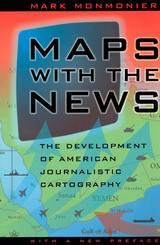 Maps with the News: The Development of American Journalistic Cartography
Mark Monmonier
University of Chicago Press, 1989 Maps with the News is a lively assessment of the role of cartography in American journalism. Tracing the use of maps in American news reporting from the eighteenth century to the 1980s, Mark Monmonier explores why and how journalistic maps have achieved such importance.
"A most welcome and thorough investigation of a neglected aspect of both the history of cartography and modern cartographic practice."—Mapline
"A well-written, scholarly treatment of journalistic cartography. . . . It is well researched, thoroughly indexed and referenced . . . amply illustrated."—Judith A. Tyner, Imago Mundi
"There is little doubt that Maps with the News should be part of the training and on the desks of all those concerned with producing maps for mass consumption, and also on the bookshelves of all journalists, graphic artists, historians of cartography, and geographic educators."—W. G. V. Balchin, Geographical Journal
"A definitive work on journalistic cartography."—Virginia Chipperfield, Society of University Cartographers Bulletin
The Marana Community in the Hohokam World
Suzanne K. Fish
University of Arizona Press, 1992 This account of Classic Period settlement in the Tucson Basin between A.D. 1100 and 1300 is the first comprehensive description of the organization of territory, subsistence, and society in a Hohokam community of an outlying region. Broad recovery of settlement patterns reveals in unique detail the developmental history of the Marana Community and its hierarchical structure about a central site with a platform mound. Remains of diverse agricultural technologies demonstrate the means for supporting populations of previously unrecognized size.
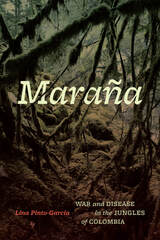 Maraña: War and Disease in the Jungles of Colombia
Lina Pinto-García
University of Chicago Press, 2025 Delves into the relationship between war and disease, focusing on Colombian armed conflict and the skin disease known as cutaneous leishmaniasis.
Cutaneous leishmaniasis, transmitted by female sandflies, produces skin lesions of varying size and shape. In Colombia, the insect vector of the disease is native to the same forested environments that have served as the main stage for one of the longest and most violent wars in Latin American history. As a result, the populations most affected by leishmaniasis in Colombia are members of the state army and nonstate armed groups.
Lina Pinto-García explores how leishmaniasis and the armed conflict are inextricably connected and mutually reinforcing. Maraña means “tangle” in Spanish but is also commonly used in Colombia to name the entangled greenery, braided lianas, and dense foliage that characterize the tropical forests where leishmaniasis transmission typically occurs. Pinto-García argues that leishmaniasis and the war are not merely linked but enmarañadas to each other through narratives, technologies, and practices produced by the state, medicine, biomedical research, and the armed conflict itself. All told, Maraña is a passionate study of how war has shaped the production of scientific knowledge about leishmaniasis and access to its treatments in Colombia.
Maranatha Road
Heather Bell Adams
West Virginia University Press, 2017 After Sadie’s son, Mark, is gone, she doesn’t have much use for other people, including her husband. The last person she wants to see is Tinley Greene, who shows up claiming she’s pregnant with Mark’s baby.
Sadie knows Tinley must be lying because Mark was engaged and never would have betrayed his fiancée. So she refuses to help, and she doesn’t breathe a word about it to anybody. But in a small, southern town like Garnet, nothing stays secret for long.
Once Sadie starts piecing together what happened to Mark, she discovers she was wrong about Tinley. And when her husband is rushed to the hospital, Sadie must hurry to undo her mistake before he runs out of time to meet their grandchild.
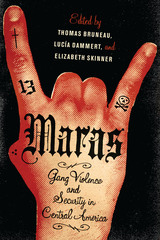 Maras: Gang Violence and Security in Central America
Edited by Thomas C. Bruneau, Lucía Dammert, and Elizabeth Skinner
University of Texas Press, 2011 Sensational headlines have publicized the drug trafficking, brutal violence, and other organized crime elements associated with Central America's mara gangs, but there have been few clear-eyed analyses of the history, hierarchies, and future of the mara phenomenon. The first book to look specifically at the Central American gang problem by drawing on the perspectives of researchers from different disciplinary backgrounds, Maras: Gang Violence and Security in Central America provides much-needed insight. These essays trace the development of the gangs, from Mara Salvatrucha to the 18th Street Gang, in Los Angeles and their spread to El Salvador, Honduras, Guatemala, and Nicaragua as the result of members' deportation to Central America; there, they account for high homicide rates and threaten the democratic stability of the region. With expertise in areas ranging from political science to law enforcement and human rights, the contributors also explore the spread of mara violence in the United States. Their findings comprise a complete documentation that spans sexualized violence, case studies of individual gangs, economic factors, varied responses to gang violence, the use of intelligence gathering, the limits of state power, and the role of policy makers. Raising crucial questions for a wide readership, these essays are sure to spark productive international dialogues.
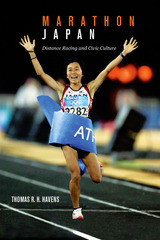 Marathon Japan: Distance Racing and Civic Culture
Thomas R. H. Havens
University of Hawaii Press, 2015 Japanese have been fervid long-distance runners for many centuries. Today, on a per capita basis, at least as many Japanese residents complete marathons each year as do those in the United States or any other country. Marathon Japan traces the development of distance racing beginning with the Stockholm Olympics of 1912, when the Japanese government used athletics as part of its project to win the respect of Western countries and achieve parity with the world powers. The marathon soon became the first Western- derived sports event in which Japanese proved consistently superior to athletes from other countries. During the 1920s and 1930s, Japanese runners regularly produced the fastest times in the world, and in the 1960s and late 1970s–1980s, Japanese men again dominated world marathoning. Japanese women likewise emerged as some of the world’s fastest in the 1990s and early 2000s. Meanwhile the general public took up distance running with enthusiasm, starting in the 1960s and continuing unabated today, symbolized most recently by massive open-entry marathons in Tokyo, Osaka, and other Japanese cities comparable in scale and challenge to major world races in Boston, New York, Chicago, London, and Berlin. In this book, Thomas Havens analyzes the origins, development, and significance of Japan’s excellence in marathons and long-distance relays (ekiden), as well as the explosive growth of distance racing among ordinary citizens. He reveals the key role of commercial media companies in promoting sports, especially marathons and ekiden, and explains how running became a consumer commodity beginning in the 1970s as Japanese society matured into an age of capitalist affluence. What comes to light as well are the relentlessly nationalistic goals underlying government policies toward sports throughout the modern era. The public craze for distance racing, both watching and running, has created a shared citizenship of civic participation among young and old, male and female, and persons of every social background and level of education. Marathon Japan will appeal to Japan specialists of cultural and social history, recreational runners in Japan and abroad, as well as anyone interested in the history of sports.
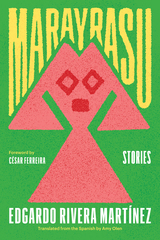 Marayrasu: Stories
Edgardo Rivera Martínez, Amy Olen
Northwestern University Press, 2026 The first English-language collection of short stories by award-winning Peruvian author Edgardo Rivera Martínez
The stories in Marayrasu stage fantastical, mysterious encounters that belie the characters’ often harsh economic and political realities as they seek belonging in modern Peru through art, music, and relationships. Depicted in poetic prose, these characters are loners, orphans, and outcasts experiencing quiet, tender encounters with other people and animals, the creative arts, and the land they find themselves depending on. Living vibrantly within these stories, the leviathan of Inca lore considers its own form, a young boy moves to a mining town and gets involved with a local union leader’s fight for worker rights while feeling the powerful pull of a large mountain overlooking the town, and a Persian cat captures the attention of a family down on its luck. Amy Olen’s translation smoothly captures Rivera Martínez’s impressive stories, offering a unique lens into the region at the heart of this canonical author’s inimitable work.
The Marble Faun
Nathaniel Hawthorne
Harvard University Press, 2013 Nathaniel Hawthorne’s The Marble Faun mingles fable with fact in a mysterious tale of American artists liberated from New England mores in Rome. In his introduction, Andrew Delbanco remarks that Hawthorne’s novel is ultimately less about freedom than its costs. It is a book “that invites us to observe people in the grip of guilt, passion, or a naïve faith in God or art, and to watch them seek escape from their fears and doubts as their creed—whatever it is—fails them.” The John Harvard Library edition reproduces the authoritative text of The Marble Faun in The Centenary Edition of the Works of Nathaniel Hawthorne.
Since 1959 The John Harvard Library has been instrumental in publishing essential American writings in authoritative editions.
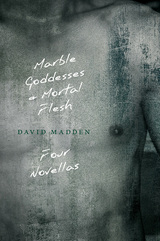 Marble Goddesses and Mortal Flesh
David Madden
University of Tennessee Press, 2017 “In his thirteenth book, David Madden returns to Lucius Hutchfield, protagonist of Bijou, his early masterpiece, and one of the most unforgettable characters I’ve had the pleasure to meet in fiction. Over the course of these novellas, Madden delivers four distinct episodes from Lucius’s life, spanning late youth to middle age. Marble Goddesses and Mortal Flesh is equal parts comic, heartbreaking, suspenseful, meditative, erotic, romantic, nostalgic, always rich in character and sense of place and masterfully rendered end to end. Just read it. You’ll see what I mean.” —Michael Knight, author of The Typist: A Novel
The Hero and the Witness is a harrowing and comic story of nineteen-year-old Lucius’s ordeal as a merchant seaman caught in the crossfire between an enigmatic scapegoat and a violent crew en route to Chile. In To Play the Con, Lucius, now a teacher and a first-time novelist, cons his little brother’s six small-town victims into accepting restitution for passing bad checks, a scam their older brother taught him and that may send him to the chain gang. Lucius works another con in Nothing Dies, but Something Mourns by persuading an ancient lady in a mountain town to tell him the romantic story of her brief love affair with Jesse James. In the innovative novella Marble Goddesses and Mortal Flesh, Lucius, now middle-aged and a successful novelist, buys the derelict Bijou Theater where he was a very young usher and becomes immersed to the brink of psychosis in memories of the immortal movie goddesses of the 40s and the mortal girls of his youth.
The novella is the perfect medium for this wide-ranging author to explore the power of the imagination and of oral storytelling in the lives of his characters. Madden’s unmatched scope in this collection could draw comparisons to Joseph Conrad, Henry James, Thomas Wolfe, and James M. Cain equally well.
Like Lucius, a native of Knoxville, DAVID MADDEN was an adolescent usher in the 1940s, a Merchant Mariner in the 1950s, and his two brothers were con men in their youth. He became a teacher in 1957, retiring in 2008 as LSU’s Robert Penn Warren Professor of Creative Writing, emeritus. Living now in Black Mountain, North Carolina, he has nearly finished a memoir recounting his youthful experiences in the U.S. Army.
 Marble Goddesses and Mortal Flesh
David Madden
University of Tennessee Press The Hero and the Witness is a harrowing and comic story of nineteen-year-old Lucius’s ordeal as a merchant seaman caught in the crossfire between an enigmatic scapegoat and a violent crew en route to Chile. In To Play the Con, Lucius, now a teacher and a first-time novelist, cons his little brother’s six small-town victims into accepting restitution for passing bad checks, a scam their older brother taught him and that may send him to the chain gang. Lucius works another con in Nothing Dies, but Something Mourns by persuading an ancient lady in a mountain town to tell him the romantic story of her brief love affair with Jesse James. In the innovative novella Marble Goddesses and Mortal Flesh, Lucius, now middle-aged and a successful novelist, buys the derelict Bijou Theater where he was a very young usher and becomes immersed to the brink of psychosis in memories of the immortal movie goddesses of the 40s and the mortal girls of his youth.
The novella is the perfect medium for this wide-ranging author to explore the power of the imagination and of oral storytelling in the lives of his characters. Madden’s unmatched scope in this collection could draw comparisons to Joseph Conrad, Henry James, Thomas Wolfe, and James M. Cain equally well.
Like Lucius, a native of Knoxville, DAVID MADDEN was an adolescent usher in the
1940s, a Merchant Mariner in the 1950s, and his two brothers were con men in their youth. He became a teacher in 1957, retiring in 2008 as LSU’s Robert Penn Warren Professor of Creative Writing, emeritus. Living now in Black Mountain, North Carolina, he has nearly finished a memoir recounting his youthful experiences in the U.S. Army.
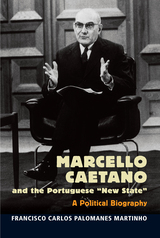 Marcello Caetano and the Portuguese "New State": A Political Biography
Francisco Martinho
Sussex Academic Press, 2022 Prime Minister Marcello Caetano was the successor of Antonio de Oliveira Salazar. Considered the second most important figure of the Portuguese dictatorship (the Estado Novo regime, 1933-1974), Caetano has generated considerable disagreement amongst scholars with regard to his persona and politics. The author explains Caetanos growing activism in the Integralismo Lusitano and in the Catholic Church, and his monarchist and nationalist ideology. Caetanos decision to support the Salazar Regime coincided with publications in the mainstream media on corporatism, colonialism, European politics, and the relationship between Brazil and Portugal. His role in the office of General Secretary of Mocidade Portuguesa (MP) was at odds with his neutrality policy in the Second World War. The leadership of Uniao Nacional and the presidency of the Camara Corportiva led to national recognition at a time when the Portuguese regime had to reform its colonial policy. Caetanos Presidency (beginning in September 1968) reflected the tense relationship between the government and the liberal wing on the colonial crisis. Ultimately this led to the final crisis of the New State regime; the fragmentation of the armed forces; and the Carnation Revolution on April 25, 1974. During his exile in Brazil between 1974 and 1980, Caetano maintained correspondence with his Portuguese friends. These correspondences, introduced and explained by Francisco Martinho, are of exceptional importance in understanding Portugals contemporary political history.
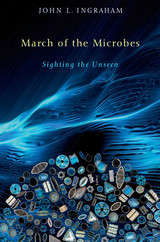 March of the Microbes: Sighting the Unseen
John L. Ingraham
Harvard University Press, 2012 Though nothing in the natural world would be quite the same without them, microbes go mostly unnoticed. They are the tiny, mighty force behind the pop in Champagne and the holes in Swiss cheese, the granite walls of Yosemite and the white cliffs of Dover, the workings of snowmaking machines, Botox, and gunpowder; and yet we tend to regard them as peripheral, disease-causing, food-spoiling troublemakers. In this book renowned microbiologist John Ingraham rescues these supremely important and ubiquitous microorganisms from their unwonted obscurity by showing us how we can, in fact, see them—and appreciate their vast and varied role in nature and our lives.
Though we might not be able to see microbes firsthand, the consequences of their activities are readily apparent to our unaided senses. March of the Microbes shows us how to examine, study, and appreciate microbes in the manner of a birdwatcher, by making sightings of microbial activities and thereby identifying particular microbes as well as understanding what they do and how they do it. The sightings are as different as a smelly rock cod, a bottle of Chateau d’Yquem, a moment in the Salem witch trials, and white clouds over the ocean. Together they summarize the impact of microbes on our planet, its atmosphere, geology, weather, and other organisms including ourselves, to whom they dole out fatal illnesses and vital nutrients alike.
In the end, Ingraham leaves us marveling at the power and persistence of microbes on our planet and gives credence to Louis Pasteur’s famous assertion that “microbes will have the last word.”
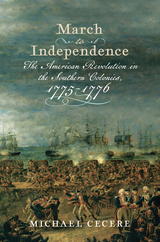 March to Independence: The Revolutionary War in the Southern Colonies, 1775–1776
Michael Cecere
Westholme Publishing, 2021 The Independence Trilogy
The American Revolutionary War began when Massachusetts militiamen and British troops clashed at Lexington and Concord on April 19, 1775. Two months later, a much larger engagement occurred at Bunker Hill in Boston. The conflict then expanded into a continent-wide war for independence from Great Britain. Or so we are taught. A closer look at events in the South in the eighteen months following Lexington and Concord tells different story. The practice of teaching the Revolutionary War as one generalized conflict between the American colonies and Great Britain assumes the South’s support for the Revolutionary War was a foregone conclusion. However, once shots were fired, it was not certain that the southern colonies would support the independence movement. What is clear is that both the fledgling American republic and the British knew that the southern colonies were critical to any successful prosecution of the war by either side.
In March to Independence: The American Revolution in the Southern Colonies, 1775–1776, historian Michael Cecere, consulting primary source documents, examines how Virginia, North Carolina, South Carolina, and Georgia ended up supporting the colonies to the north, while East Florida remained within the British sphere. South Carolina, Georgia, and East Florida all retained their royal governors through the summer of 1775, and no military engagements occurred in any of the southern colonies in the six months following the battles in Massachusetts. The situation changed significantly in the fall, however, with armed clashes in Virginia and South Carolina; by early 1776 the war had spread to all of the southern colonies except East Florida. Although their march to independence did not follow the exact route as the colonies to the north, events in the South pulled the southern colonists in the same direction, culminating with a united Declaration of Independence on July 4, 1776. This book explores the crucial events in the southern colonies that led all but East Florida to support the American cause.
March Up Country: a translation of Xenophon's Anabasis
W. H. D. Rouse
University of Michigan Press, 1958 In 401 B.C. the Middle East was as much the center of the world attention as it is today. Ten thousand Greeks joined the army of Cyros marching on Babylon to overthrow the great King of the Persians, Artaxerxes. Among the Greeks was an Athenian gentleman, Xenophon, who went along as a sightseer but soon found himself cast in the main role. At Cunaxa, Cyros' forces met and resoundingly defeated the tremendous army of the King, but Cyros was killed while leading the attack. Stranded a thousand miles from home, the Greeks chose Xenophon as their new leader. The wealthy Athenian squire rose to the challenge. Using every trick of the pioneer in hostile territory, he brought his men back to safety. The March Up Country is a classic of courage and adventure.
The March Wind
Inez Rice
Bodleian Library Publishing, 2017 Every child knows that costumes are magical. Put on the right hat, add some imagination, and you can be anyone.
That's what happens to a little boy in The March Wind. Finding a large black hat lying in the street, he tries it on . . . and instantly becomes a host of exciting characters: a soldier marching proudly through puddles, a cowboy galloping on his steed, a bandit fleeing the law under cover of night, a circus ringleader entertaining the crowd. But then the owner of the hat returns, and the boy finds himself face to face with the March Wind. Is this part of his imagination, too, or is something bigger happening?
This charming children’s book, first published in 1957, is brought to life by the timeless illustrations of Vladimir Bobri, whose wonderfully imaginative renderings of the boy’s flights of fancy are endearing and captivating. It will charm parents and children alike.
Marcha: Latino Chicago and the Immigrant Rights Movement
Edited by Amalia Pallares and Nilda Flores-Gonzalez
University of Illinois Press, 2010 Marcha is a multidisciplinary survey of the individuals, organizations, and institutions that have given shape and power to the contemporary immigrant rights movement in Chicago. A city with longstanding historic ties to immigrant activism, Chicago has been the scene of a precedent-setting immigrant rights mobilization in 2006 and subsequent mobilizations in 2007 and 2008. Positing Chicago as a microcosm of the immigrant rights movement on national level, these essays plumb an extraordinarily rich set of data regarding recent immigrant rights activities, defining the cause as not just a local quest for citizenship rights, but a panethnic, transnational movement. The result is a timely volume likely to provoke debate and advance the national conversation about immigration in innovative ways.
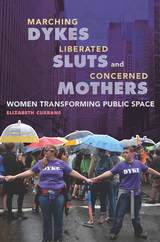 Marching Dykes, Liberated Sluts, and Concerned Mothers: Women Transforming Public Space
Elizabeth Currans
University of Illinois Press, 2017 From the Women in Black vigils and Dyke marches to the Million Mom March, women have seized a dynamic role in early twenty-first century protest. The varied demonstrations--whether about gender, sexuality, war, or other issues--share significant characteristics as space-claiming performances in and of themselves beyond their place in any broader movement. Elizabeth Currans blends feminist, queer, and critical race theory with performance studies, political theory, and geography to explore the outcomes and cultural relevance of public protest. Drawing on observation, interviews, and archival and published sources, Currans shows why and how women utilize public protest as a method of participating in contemporary political and cultural dialogues. She also examines how groups treat public space as an important resource and explains the tactics different women protesters use to claim, transform, and hold it. The result is a passionate and pertinent argument that women-organized demonstrations can offer scholars a path to study the relationship of gender and public space in today's political culture.
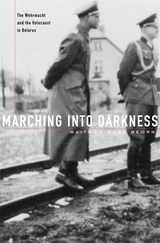 Marching into Darkness: The Wehrmacht and the Holocaust in Belarus
Waitman Wade Beorn
Harvard University Press, 2014 On October 10, 1941, the entire Jewish population of the Belarusian village of Krucha was rounded up and shot. While Nazi death squads routinely carried out mass executions on the Eastern Front, this particular atrocity was not the work of the SS but was committed by a regular German army unit acting on its own initiative. Marching into Darkness is a bone-chilling exposé of the ordinary footsoldiers who participated in the Final Solution on a daily basis.
Although scholars have exploded the myth that the Wehrmacht played no significant part in the Holocaust, a concrete picture of its involvement at the local level has been lacking. Among the crimes Waitman Wade Beorn unearths are forced labor, sexual violence, and graverobbing, though a few soldiers refused to participate and even helped Jews. By meticulously reconstructing the German army's activities in Belarus in 1941, Marching into Darkness reveals in stark detail how the army willingly fulfilled its role as an agent of murder on a massive scale. Early efforts at improvised extermination progressively became much more methodical, with some army units going so far as to organize "Jew hunts." Beorn also demonstrates how the Wehrmacht used the pretense of anti-partisan warfare as a subterfuge by reporting murdered Jews as partisans.
Through archival research into military and legal records, survivor testimonies, and eyewitness interviews, Beorn paints a searing portrait of a professional army's descent into ever more intimate participation in genocide.
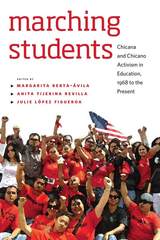 Marching Students: Chicana and Chicano Activism in Education, 1968 to the Present
Margarita Berta-Avila
University of Nevada Press, 2011 In 1968 over 10,000 Chicana/o high school students in East Los Angeles walked out of their schools in the first major protest against racism and educational inequality staged by Mexican Americans in the United States. They ignited the Mexican-American civil rights movement, which opened the doors to higher education and equal opportunity in employment for Mexican Americans and other Latinos previously excluded. Marching Students is a collaborative effort by Chicana/o scholars in several fields to place the 1968 walkouts and Chicana and Chicano Civil Rights Movement in historical context, highlighting the contribution of Chicana/o educators, students, and community activists to minority education.
Contributors: Alejandro Covarrubias, Xico González, Eracleo Guevara, Adriana Katzew, Lilia R. De Katzew, Rita Kohli, Edward M. Olivos, Alejo Padilla, Carmen E. Quintana, Evelyn M. Rangel-Medina, Marianna Rivera, Daniel G. Solórzano, Carlos Tejeda
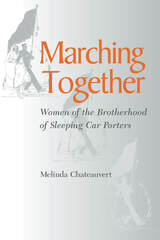 Marching Together: Women of the Brotherhood of Sleeping Car Porters
Melinda Chateauvert
University of Illinois Press, 1998 The Brotherhood of Sleeping Car Porters (BSCP) was the first national trade union for African Americans. Standard BSCP histories focus on the men who built the union. Yet the union's Ladies' Auxiliary played an essential role in shaping public debates over black manhood and unionization, setting political agendas for the black community, and crafting effective strategies to win racial and economic justice. Melinda Chateauvert explores the history of the Ladies' Auxiliary and the wives, daughters, and sisters of Pullman porters who made up its membership and used the union to claim respectability and citizenship. As she shows, the Auxiliary actively educated other women and children about the labor movement, staged consumer protests, and organized local and national civil rights campaigns ranging from the 1941 March on Washington to school integration to the Montgomery Bus Boycott. Chateauvert also sheds light on the plight of Pullman maids, who—relegated to the Auxiliary—found their problems as working women neglected in favor of the rhetoric of racial solidarity.
Marco Polo
Jonathan Clements
Haus Publishing, 2006 The records of the Chinese Yuan dynasty do not mention a Marco Polo at all (and they should), and there aer some suspicious omissions from Polo's text - no tea, no foot-binding, no mention of Chinese printing, or even of the Great Wall. Did Polo even go to China?
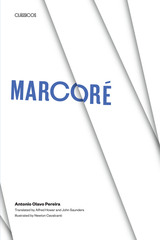 Marcoré
By Antonio Olavo Pereira
University of Texas Press, 1970 Marcoré, first published in Rio de Janeiro in 1957, won the coveted prize for fiction awarded by the Brazilian Academy of Letters and has been praised by leading critics and writers in Brazil. The novel has maintained favor with the Brazilian public and has also been published and received with enthusiasm in Portugal. Adopting the intimist, introspective approach characteristic of such writers as Machado de Assis and Graciliano Ramos, Pereira tells a moving, bittersweet tale of personal problems and family relationships. The central character of Marcoré is the narrator, a modest, introverted individual who, aware of his own human condition, tends to view life with pessimism tempered with compassion. As the narrator reflects on his life and relationships in a small town in the state of São Paulo, an unobtrusive document of Brazilian family life unfolds. The novel contains several highly dramatic scenes as well as many tender and entertaining ones and introduces a set of very human, very credible characters, including a most irascible mother-in-law and a wife who makes a strange vow. The reactions, thoughts, and hidden motivations of the characters are revealed in precise and economical language—evidence of the author's powers of observation and knowledge of human nature. Rachel de Queiroz has described Marcoré as "a beautiful and tormented book." It has become a modern Brazilian classic.
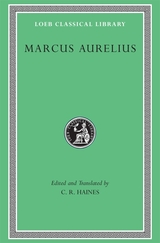 Marcus Aurelius
Marcus Aurelius
Harvard University Press, 1930 Stoic musings of a philosopher-emperor at war.
Marcus Aurelius (AD 121–180), Roman emperor and Stoic philosopher, born at Rome, received training under his guardian and uncle emperor Antoninus Pius (reigned 138–161), who adopted him. He was converted to Stoicism and henceforward studied and practiced philosophy and law. A gentle man, he lived in agreement and collaboration with Antoninus Pius. He married Pius’ daughter and succeeded him as emperor in March 161, sharing some of the burdens with Lucius Verus.
Marcus’ reign soon saw fearful national disasters from flood, earthquakes, epidemics, threatened revolt (in Britain), a Parthian war, and pressure of barbarians north of the Alps. From 169 onwards he had to struggle hard against the German Quadi, Marcomani, Vandals, and others until success came in 174. In 175 (when Faustina died) he pacified affairs in Asia after a revolt by Avidius. War with Germans was renewed during which he caught some disease and died by the Danube in March 180.
The famous Meditations of Marcus Aurelius (not his title; he simply calls them “The matters addressed to himself”) are reflections written in periods of solitude during the emperor’s military campaigns. Originally intended for his private guidance and self-admonition, the Meditations have endured as a potent expression of Stoic belief. It is a central text for students of Stoicism as well as a unique personal guide to the moral life.
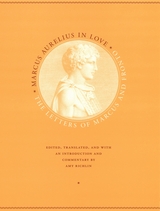 Marcus Aurelius in Love
Marcus Aurelius and Marcus Cornelius Fronto
University of Chicago Press, 2007 In 1815 a manuscript containing one of the long-lost treasures of antiquity was discovered—the letters of Marcus Cornelius Fronto, reputed to have been one of the greatest Roman orators. But this find disappointed many nineteenth-century readers, who had hoped for the letters to convey all of the political drama of Cicero’s. That the collection included passionate love letters between Fronto and the future emperor Marcus Aurelius was politely ignored—or concealed. And for almost two hundred years these letters have lain hidden in plain sight.
Marcus Aurelius in Love rescues these letters from obscurity and returns them to the public eye. The story of Marcus and Fronto began in 139 CE, when Fronto was selected to instruct Marcus in rhetoric. Marcus was eighteen then and by all appearances the pupil and teacher fell in love. Spanning the years in which the relationship flowered and died, these are the only love letters to survive from antiquity—homoerotic or otherwise. With a translation that reproduces the effusive, slangy style of the young prince and the rhetorical flourishes of his master, the letters between Marcus and Fronto will rightfully be reconsidered as key documents in the study of the history of sexuality and classics.
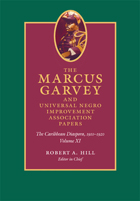 The Marcus Garvey and Universal Negro Improvement Association Papers, Volume XI: The Caribbean Diaspora, 1910–1920
Marcus Garvey
Duke University Press, 2011 With Volume XI: The Caribbean Diaspora, 1910–1920, Duke University Press proudly assumes publication of the final volumes of The Marcus Garvey and Universal Negro Improvement Association Papers. This invaluable archival project documents the impact and spread of the Universal Negro Improvement Association (UNIA), the organization founded by Marcus Garvey in 1914 and led by him until his death in 1940. Volume XI is the first to focus on the Caribbean, where the UNIA was represented by more than 170 divisions and chapters. Revealing the connections between the major African-American mass movement of the interwar era and the struggle of the Caribbean people for independence, this volume includes the letters, speeches, and writings of Caribbean Garveyites and their opponents, as well as documents and speeches by Garvey, newspaper articles, colonial correspondence and memoranda, and government investigative records. Volume XI covers the period from 1911, when a controversy was ignited in Limon, Costa Rica, in response to a letter that Garvey sent to the Limon Times, until 1920, when workers on the Panama Canal undertook a strike sponsored in part by the UNIA. The primary documents are extensively annotated, and the volume includes twenty-two critical commentaries on the territories covered in the book, from the Bahamas to Guatemala, and Haiti to Brazil. A trove of scholarly resources, Volume XI: The Caribbean Diaspora, 1910–1920 illuminates another chapter in the history of one the world’s most important social movements. Praise for the Previous Volumes:
“The Marcus Garvey and Universal Negro Improvement Association Papers will take its place among the most important records of the Afro-American experience. . . . ‘The Marcus Garvey Papers’ lays the groundwork for a long overdue reassessment of Marcus Garvey and the legacy of racial pride, nationalism and concern with Africa he bequeathed to today’s black community.”—Eric Foner, the New York Times Book Review
“Until the publication of The Marcus Garvey and Universal Negro Improvement Association Papers, many of the documents necessary for a full assessment of Garvey’s thought or of his movement’s significance have not been easily accessible. Robert A. Hill and his staff . . . have gathered over 30,000 documents from libraries and other sources in many countries. . . . The Garvey papers will reshape our understanding of the history of black nationalism and perhaps increase our understanding of contemporary black politics.”—Clayborne Carson, the Nation “Now is our chance, through these important volumes, to finally begin to come to terms with the significance of Garvey’s complex, fascinating career and the meaning of the movement he built.”—Lawrence W. Levine, the New Republic
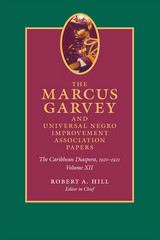 The Marcus Garvey and Universal Negro Improvement Association Papers, Volume XII: The Caribbean Diaspora, 1920-1921
Marcus Garvey
Duke University Press, 2014 Volume XII of the Marcus Garvey and Universal Negro Improvement Association Papers covers a period of twelve months, from the opening of the UNIA's historic first international convention in New York, in August 1920, to Marcus Garvey's return to the United States in July 1921 after an extended tour of Cuba, Jamaica, Panama, Costa Rica, and Belize. In many ways the 1920 convention marked the high-point of the Garvey movement in the United States, while Garvey's tour of the Caribbean, in the winter and spring of 1921, registered the greatest outpouring of popular support for the UNIA in its history. The period covered in the present volume was the moment of the movement's political apotheosis, as well as the moment when the finances of Garvey's Black Star Line went into free fall.
Volume XII highlights the centrality of the Caribbean people not only to the convention, but also to the movement. The reports to the convention discussed the range of social and economic conditions obtaining in the Caribbean, particularly their impact on racial conditions. The quality of the discussions and debates were impressive. Contained in these reports are some of the earliest and most clearly enunciated statements in defense of social and political freedom in the Caribbean. These documents form an underappreciated and still underutilized record of the political awakening of Caribbean people of African descent.
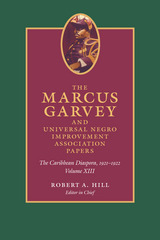 The Marcus Garvey and Universal Negro Improvement Association Papers, Volume XIII: The Caribbean Diaspora, 1921-1922, Volume 13
Marcus Garvey
Duke University Press, 2016 Volume XIII of The Marcus Garvey and Universal Negro Improvement Association Papers covers the twelve months between the UNIA's second international convention in New York in August 1921 and the third convention in August 1922. It was a particularly tumultuous time for Garvey and the UNIA: Garvey’s relationship with the UNIA's top leadership began to fracture, the U.S. federal government charged Garvey with mail fraud, and his Black Star Line operation suffered massive financial losses. This period also witnessed a marked shift in Garvey's rhetoric and stance, as he retreated from his previously radical anticolonial positions, sought to court European governments as well as the leadership of the Ku Klux Klan, and moved against his political rivals. Despite these difficult and uncertain times, Garveyism expanded its reach throughout the Caribbean archipelago, which, as Volume XIII confirms, became the UNIA's de facto home in the early 1920s. The volume's numerous reports from the UNIA's Caribbean divisions and chapters describe what it was like for UNIA activists living and working under extremely repressive circumstances. The volume's major highlight covers the U.S. military's crackdown on the UNIA in the Dominican Republic, as documented in the correspondence between John Sydney de Bourg—whom Garvey had dispatched to monitor the situation—and U.S. and British government officials. In addition to UNIA divisional reports and de Bourg's extensive correspondence, Volume XIII contains a wealth of newspaper articles, political tracts, official documents, and other sources that outline the complex responses to Garveyism throughout the United States, the Caribbean, and Europe, all the while documenting this watershed moment for Garvey and the UNIA.
 Mardi and a Voyage Thither: Volume Three
Herman Melville
Northwestern University Press, 1998 Presented as narratives of his own South Sea experiences, Melville's first two books had roused incredulity in many readers. Their disbelief, he declared, had been "the main inducement" in altering his plan for his third book, Mardi: and a Voyage Thither (1849). Melville wanted to exploit the "rich poetical material" of Polynesia and also to escape feeling "irked, cramped, & fettered" by a narrative of facts. "I began to feel . . . a longing to plume my pinions for a flight," he told his English publisher.
This scholarly edition aims to present a text as close to the author's intention as surviving evidence permits. Based on collations of all editions publishing during Melville's lifetime, it incorporates author corrections and many emendations made by the present editors. This edition of Mardi is an Approved Text of the Center for Editions of American Authors (Modern Language Association of America).
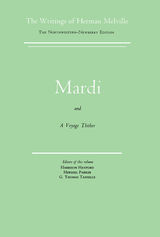 Mardi and a Voyage Thither: Volume Three, Scholarly Edition
Herman Melville
Northwestern University Press, 1970 Presented as narratives of his own South Sea experiences, Melville's first two books had roused incredulity in many readers. Their disbelief, he declared, had been "the main inducement" in altering his plan for his third book, Mardi: and a Voyage Thither (1849). Melville wanted to exploit the "rich poetical material" of Polynesia and also to escape feeling "irked, cramped, & fettered" by a narrative of facts. "I began to feel . . . a longing to plume my pinions for a flight," he told his English publisher.
This scholarly edition aims to present a text as close to the author's intention as surviving evidence permits. Based on collations of all editions publishing during Melville's lifetime, it incorporates author corrections and many emendations made by the present editors. This edition of Mardi is an Approved Text of the Center for Editions of American Authors (Modern Language Association of America).
 The Marengo Jake Stories: The Tales of Jake Mitchell and Robert Wilton Burton
Jake Mitchell and Robert Wilton Burton, collected by Kathryn Sport and Bert Hitchcock
University of Alabama Press, 2007 Between 1885 and 1894 The Montgomery Advertiser, The Birmingham-Age Herald, and The New Orleans Times Democrat featured a series of about 80 humorous black-dialect sketches by Robert Wilton Burton, a bookseller and writer from Auburn, Alabama. According to Burton, these tales were based on various characters in the black community of Auburn, and 36 of them were devoted exclusively to a character called "Marengo Jake." Probably originally from Virginia, Jake Mitchell was brought to the Drake Plantation in Marengo county as a boy in the 1850's. After the Civil War, the Drake family moved to Auburn and many former slaves followed, forming a fairly large expatriate Marengo County community. The theme of the stories, usually related by Jake, centers on the superiority of all things from Marengo County, especially over those in Lee County, in which Auburn is located.
 Marfa: The Transformation of a West Texas Town
By Kathleen Shafer
University of Texas Press, 2019 A small town in the vast desert of West Texas, Marfa attracts visitors from around the world to its art foundations and galleries, film and music festivals, and design and architecture symposiums. While newcomers sometimes see it as “another Santa Fe,” long-time residents often take a bemused, even disapproving attitude toward the changes that Marfa has undergone since artist Donald Judd came to town in the 1970s and began creating spaces for his own and other artists’ work. They remember when ranching and the military formed the basis of the town’s economy, even as they acknowledge that tourist dollars are now essential to Marfa’s sustainability Marfa tells an engaging story of how this isolated place became a beacon in the art world, like the famous Marfa Lights that draw curious spectators into the West Texas night. As Kathleen Shafer delves into the town’s early history, the impact of Donald Judd, the expansion of arts programming, and the increase in tourism, she unlocks the complex interplay between the particularities of the place, the forces of commerce and growth, the textures of local culture and tradition, and the transformative role of artists and creative work. Bookending her story between two iconic artworks—the whimsical Prada Marfa and the crass Playboy Marfa—Shafer illuminates the shifting cultural landscape of Marfa, showing why this place has become a mecca for so many and how the influx of newcomers has transformed its character.
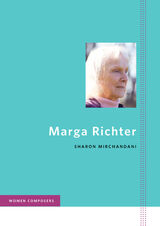 Marga Richter
Sharon Mirchandani
University of Illinois Press, 2012 This is the first full-length introduction to the life and works of significant American composer Marga Richter (born 1926), who has written more than one hundred works for orchestra, chamber ensemble, dance, opera, voice, chorus, piano, organ, and harpsichord. Still actively composing in her eighties, Richter is particularly known for her large-scale works performed by ensembles such as the London Philharmonic Orchestra and the Civic Orchestra of Chicago and for other pieces performed by prominent artists including pianist Menahem Pressler, conductor Izler Solomon, and violinist Daniel Heifetz. Interspersing consideration of Richter's musical works with discussion of her life, her musical style, and the origins and performances of her works, Sharon Mirchandani documents a successful composer's professional and private life throughout the twentieth century. Covering Richter's formative years, her influences, and the phases of her career from the 1950s to the present, Mirchandani closely examines Richter's many interesting, attractive musical works that draw inspiration from distinctly American, Irish/English, and Asian sources. Drawing extensively on interviews with the composer, Mirchandani also provides detailed descriptions of Richter's scores and uses reviews and other secondary sources to provide contexts for her work, including their relationship to modern dance, to other musical styles, and to 1970s feminism.
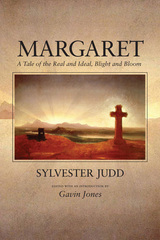 Margaret: A Tale of the Real and Ideal, Blight and Bloom
Sylvester Judd
University of Massachusetts Press, 2009 Praised at the time as the most emphatically "American" book ever written, Margaret is a breathtaking combination of female bildungsroman, utopian novel, and historical romance. First published in 1845, Sylvester Judd's novel centers on the fictional New England village of Livingston, where the young Margaret Hart strives to escape the poverty and vice of her surroundings by learning from a mysterious teacher, the "Master," and by entwining herself with the powers of nature. But when Margaret's brother is tried and hanged for murder, this rural community collapses, forcing Margaret to face the temptations of an urban underworld and to confront the intrigue of her family history. Margaret is the story of a young woman's attempt to create a new social order, founded on beauty and truth, in a land plagued by violence, debauchery, and political instability.
As Gavin Jones points out in his new introduction, Margaret perhaps stands alone in its creation of a female character who grows in social rather than domestic power. The novel also remains unique in its exploration of transcendental philosophy in novelistic form. Part eco-criticism, part seduction novel, part temperance tract, and part social history, Margaret is a virtual handbook for understanding the literary culture of mid-nineteenth-century America, the missing piece in puzzling out connections between writers such as Hawthorne, Melville, Whitman, and Thoreau.
Margaret was widely read and deeply influential on both British and American writers throughout the nineteenth century but controversial for its representations of alcoholism and capital punishment. Judd's novel remains resonant for today's readers as it overturns conventional views of the literary representation of women and the origins of the American Renaissance.
 Margaret Atwood: Vision and Forms
Edited by Kathryn Van Spanckeren and Jan Garden Castro. Foreword by Margaret Atwood
Southern Illinois University Press, 1988
A prolific writer and versatile social critic, Canadian novelist and poet Margaret Atwood has recently published Bluebeard’s Egg (short stories), Interlunar (poetry), and The Handmaid’s Tale a critically acclaimed best-selling novel.
This international collection of essays evaluates the complete body of her work—both the acclaimed fiction and the innovative poetry. The critics represented here—American, Australian, and Canadian—address Atwood’s handling of such themes as feminism, ecology, the gothic novel, and the political relationship between Canada and the United States.
The essays on Atwood’s novels introduce the general reader to her development as a writer, as she matures from a basically subjective, poetic vision, seen in Surfacing and The Edible Woman, to an increasingly engaged, political stance, exemplified by The Handmaid’s Tale. Other essays examine Atwood’s poetry, from her transformation of the Homeric model to her criticisms of the United States’ relationship with Canada. The last two critical essays offer a unique view of Atwood through an investigation of her use of the concept of shamanism and through a presentation of eight of her vivid watercolors.
The volume ends with Atwood presenting her own views in an interview with Jan Garden Castro and in a conversation between Atwood and students at the University of Tampa, Florida.
Margaret Fuller and Her Circles
Brigitte Bailey
University of New Hampshire Press, 2013 These essays mark the maturation of scholarship on Margaret Fuller (1810–1850), one of the most important public intellectuals of the nineteenth century and a writer whose works have been much revived in recent decades. The authors—leading scholars of Fuller, Transcendentalism, and the antebellum period—consider anew Fuller the critic, the journalist, the reformer, the traveler, and the social and cultural observer, and make fresh contributions to the study of her life and work. Drawing on developments in gender theory, transatlantic studies, and archival excavations of the networks of reform, this volume defines Fuller as a significant intellectual precursor, a critic who analyzed and challenged the dominant interpretive paradigms of her own time and who remains strikingly relevant for ours.
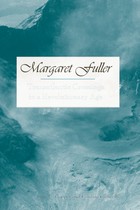 Margaret Fuller: Transatlantic Crossings in a Revolutionary Age
Edited by Charles Capper and Cristina Giorcelli
University of Wisconsin Press, 2007 Margaret Fuller (1810–1850), a pioneering gender theorist, transcendentalist, journalist, and literary critic, was one of the most well-known and highly regarded feminist intellectuals of nineteenth-century America. With her contemporaries Ralph Waldo Emerson and Henry David Thoreau, she was one of the predominant writers of the Transcendentalist movement, and she aligned herself in both her public and private life with the European revolutionary fervor of the 1840s. She traveled to Italy as a foreign correspondent for the New York Tribune to cover the nascent revolutions, pursuing the transnational ideal awakened in her youth by a classical education in European languages and a Romantic curiosity about other cultures, traditions, and identities.
This volume is a collaboration of international scholars who, from varied fields and approaches, assess Fuller’s genius and character. Treating the last several years of Margaret Fuller’s short life, these essays offer a truly international discussion of Fuller’s unique cultural, political, and personal achievements. From the origins and articulations of Fuller’s cosmopolitanism to her examination of “the woman question,” and from her fascination with the European “other” to her candid perception of imperial America from abroad, they ponder what such an extraordinary woman meant to America, and also to Italy and Europe, during her lifetime and continuing to the present.
 Margaret Mead and Ruth Benedict: The Kinship of Women
Hilary Lapsley
University of Massachusetts Press, 2001 This book tells the story of the extraordinary friendship between renowned anthropologists Margaret Mead and Ruth Benedict. First as mentor and protégé, later as colleagues and lovers, these two remarkable yet temperamentally different women forged a bond that endured for twenty-five years, defying convention as well as easy categorization. Drawing on a broad range of sources, including recently released correspondence between Mead and Benedict, Hilary Lapsley reconstructs this complex relationship and situates it in the context of its time. She explores the ways in which Mead's and Benedict's professional work grew out of concerns in their own lives—about sexuality and friendship, identity and difference. Lapsley also shows how Mead and Benedict used their anthropological studies to call attention to the cultural foundations of American life, Benedict seeking to make the world more tolerant of deviance and Mead to liberate the individual from the artificial constraints of gender and race. Overall, the book charts the course of a relationship that persisted in the face of numerous obstacles, including separations of long duration, the competing claims of other partners, secrecy about lesbianism, the tensions of professional rivalry, and the clash of different personalities.
 Margaret Mead, Gregory Bateson, and Highland Bali: Fieldwork Photographs of Bayung Gede, 1936-1939
Gerald Sullivan
University of Chicago Press, 1999 In 1936 anthropologist Margaret Mead and her husband, Gregory Bateson, retreated from lowland Bali, which was the focal point of much scholarly and tourist activity, to the remote village of Bayung Gedé in the island's central highlands. Although they wrote relatively little about their work in this place, which Mead called "our village, way up in the mountains, a lovely self-contained village," they did leave behind a remarkably rich and extensive photographic record of their time there.
Margaret Mead, Gregory Bateson, and Highland Bali includes 200 photographs that the couple took between 1936 and 1939, the vast majority of which have never before been published. They vividly capture the everyday lives of the men, women, and children of Bayung Gedé, their homes and their temples, and many other fascinating details of village life not featured in Mead and Bateson's publications.
In a substantial introductory essay, Gerald Sullivan, who selected the photographs, uses excerpts from fieldnotes and correspondence to illuminate Mead and Bateson's ethnographic work. Tracing the project from its inception in their proposals to the publication of their work, Sullivan shows how they used the photographs both as fieldnotes and as elements in their theoretical argument. Finally, he explores what the photographs reveal—independently of Mead and Bateson's project—about the Balinese character to the contemporary viewer.
The result is a both a substantial contribution to visual anthropology and an invaluable supplement to the published works of Margaret Mead and Gregory Bateson.
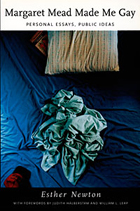 Margaret Mead Made Me Gay: Personal Essays, Public Ideas
Esther Newton
Duke University Press, 2000 Margaret Mead Made Me Gay is the intellectual autobiography of cultural anthropologist Esther Newton, a pioneer in gay and lesbian studies. Chronicling the development of her ideas from the excitement of early feminism in the 1960s to friendly critiques of queer theory in the 1990s, this collection covers a range of topics such as why we need more precise sexual vocabularies, why there have been fewer women doing drag than men, and how academia can make itself more hospitable to queers. It brings together such classics as “The Mythic Mannish Lesbian” and “Dick(less) Tracy and the Homecoming Queen” with entirely new work such as “Theater: Gay Anti-Church.”
Newton’s provocative essays detail a queer academic career while offering a behind-the-scenes view of academic homophobia. In four sections that correspond to major periods and interests in her life—”Drag and Camp,” “Lesbian-Feminism,” “Butch,” and “Queer Anthropology”—the volume reflects her successful struggle to create a body of work that uses cultural anthropology to better understand gender oppression, early feminism, theatricality and performance, and the sexual and erotic dimensions of fieldwork. Combining personal, theoretical, and ethnographic perspectives, Margaret Mead Made Me Gay also includes photographs from Newton’s personal and professional life.
With wise and revealing discussions of the complex relations between experience and philosophy, the personal and the political, and identities and practices, Margaret Mead Made Me Gay is important for anyone interested in the birth and growth of gay and lesbian studies.
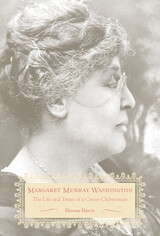 Margaret Murray Washington: The Life and Times of a Career Clubwoman
Sheena Harris
University of Tennessee Press, 2021 Born enslaved in 1861, by 1892 Margaret Murray Washington of Macon, Mississippi, married the twice-widowed race leader Booker T. Washington and joined the ranks of the rising black middle class. While one cannot discount the accomplishments of her storied husband, Washington’s own successes warrant further exploration. In this first biography of Margaret Murray Washington, author Sheena Harris discusses Washington’s importance as an active clubwoman, educational reformer, and integral partner to her husband and his success with the Tuskegee Institute.
Individual black, female leadership continues to be a blind spot in much scholarly historical literature. Washington was an important educator and clubwoman whose influence emanated from her own planning and actions. As Lady Principal, Washington was sincere and earnest in her campaign to improve Tuskegee Institute. She also transformed her community through her local club organizations. In addition, Washington cofounded the National Federation of Afro-American Women (1895) and the National Association of Colored Women (NACW) (1896). Harris illustrates how Washington improved race relations as a whole through local and national organizations such as the Tuskegee Woman’s Club, the NACW, and 1922 creation of the International Council of Women of the Darker Races (ICWDR). Harris explains clearly that Washington took her leadership positions seriously and strategically worked to expand opportunities for blacks through such organizations.
Washington’s life provides a glimpse into the inner workings of the Black Women’s Club Movement and illuminates the experiences of a race woman who came of age during the Jim Crow South. Harris’s biography is a convincing portrait of an under-studied black woman in the early civil rights movement and places Washington within the pantheon of other important women of the era.
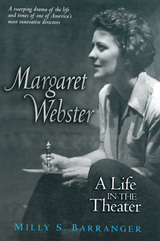 Margaret Webster: A Life in the Theater
Milly S. Barranger
University of Michigan Press, 2004 "In Milly Barranger, Margaret Webster has found the perfect biographer. In Margaret Webster, Milly Barranger has found her perfect subject. She brings to vivid life a fascinating and important theater figure whose public and private lives were of equal interest. In this carefully researched book, Webster's colleagues, lovers, and friends shine as brightly as she did. I wish she were here to read it."
-Marian Seldes
"Margaret Webster is a highly welcome addition to our knowledge of the first important female director in American theater. Remembered now especially for her staging of Othello with Paul Robeson, Uta Hagen, and Jose Ferrer, Margaret Webster was probably the best-known, in-demand, and admired director of Shakespeare in America in the 1940s and 1950s. Fascinating throughout, the book's discussions of working with Robeson, and of HUAC, which targeted her just as her career was reaching a peak, make for especially engrossing reading."
-Oscar Brockett
Margaret Webster: A Life in the Theater is an engrossing backstage account of the life of pioneering director Margaret Webster (1905-72).
This is the first book-length biography of Webster, a groundbreaking stage and opera director whose career challenged not only stage tradition but also mainstream attitudes toward professional women.
Often credited with first having brought Shakespeare to Broadway, and renowned for her bold casting of an African American (Paul Robeson) in the role of Othello, Webster was a creative force in modern American and British theater.
Her story reveals the independent-minded artist undeterred by stage tradition and unmindful of rules about a woman's place in the professional theater. In addition to providing fascinating glimpses into Webster's personal and family life, Margaret Webster: A Life in the Theater also offers a who's-who list of the biggest names in New York and London theater of the time, as well as Hollywood: John Gielgud, Noël Coward, George Bernard Shaw, Uta Hagen, Sybil Thorndike, Eva LeGallienne, and John Barrymore, among others, all of whom crossed paths with Webster. Capping Webster's amazing story is her investigation by Senator Joseph McCarthy and HUAC, which left her unable to work for a year, and from which she never fully recovered.
Margarita, How Beautiful the Sea
Sergio Ramírez
Northwestern University Press, 2007 León, Nicaragua, 1907. During a tribute he delivers during his triumphal return to his native city, Rubén Darío writes on the fan of a little girl one of his most famous poems, "Margarita, How Beautiful the Sea." In 1956 in a cafe in León, a group of literati gather, dedicated, among other things, to the rigorous reconstruction of the legend surrounding Darío—but also to conspire. There will be an attempt against dictator Somoza's life, and that little girl with the fan a half-century before will not be a disinterested party. In Margarita, How Beautiful the Sea, Sergio Ramírez encompasses, in a complete metaphor of reality and legend, the entire history of his country. The narrative moves along paths fifty years apart, which inevitably converge. The story becomes a fascinating exercise on the power of memory, on the influence of the past, fictitious or not, in the finality of reality.
Marginal Conventions: Popular Culture, Mass Media, and Social Deviance
Clinton R. Sanders
University of Wisconsin Press, 1990 Marginal Conventions contains twelve essays by social scientists centering around the general connections between popular culture and deviant behavior. In addition to speaking to the commonsensical view that exposure to representations of misbehavior makes people misbehave, this collection focuses on media presentations of crime, violence, and villainy; the utility of deviance theme for societal elites; and the "taste publics" centered around disreputable products and rituals.
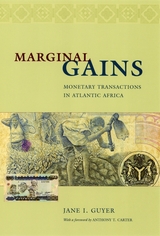 Marginal Gains: Monetary Transactions in Atlantic Africa
Jane I. Guyer
University of Chicago Press, 2004 In America, almost all the money in circulation passes through financial institutions every day. But in Nigeria's "cash and carry" system, 90 percent of the currency never comes back to a bank after it's issued. What happens when two such radically different economies meet and mingle, as they have for centuries in Atlantic Africa?
The answer is a rich diversity of economic practices responsive to both local and global circumstances. In Marginal Gains, Jane I. Guyer explores and explains these often bewildering practices, including trade with coastal capitalism and across indigenous currency zones, and within the modern popular economy. Drawing on a wide range of evidence, Guyer demonstrates that the region shares a coherent, if loosely knit, commercial culture. She shows how that culture actually works in daily practice, addressing both its differing scales of value and the many settings in which it operates, from crisis conditions to ordinary household budgets. The result is a landmark study that reveals not just how popular economic systems work in Africa, but possibly elsewhere in the Third World.
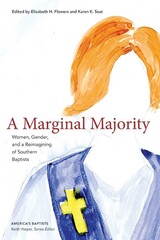 A Marginal Majority: Women, Gender, and a Reimagining of Southern Baptists
Elizabeth Flowers
University of Tennessee Press, 2020 In step with the #MeToo movement and third wave feminism, women’s roles provoke lively debate in today’s evangelical sphere. The Southern Baptist Convention (SBC) has a complicated past regarding this issue, and determining what exactly women’s roles in home, church, and society should be, or even what these roles should be called, has been a contentious subject. In A Marginal Majority: Women, Gender, and a Reimagining of Southern Baptists, editors Elizabeth H. Flowers and Karen K. Seat and eight other contributors examine the SBC’s complex history regarding women and how that history reshapes our understanding of the denomination and its contemporary debates.
This comprehensive volume starts with women as SBC fundraisers, moves to the ways they served Southern Baptist missions, and considers their struggles to find a place at Southern Baptist seminaries as well as their launching of “teaching” or “women’s” ministries. Along the way, it introduces new personalities, offers fresh considerations of familiar figures, and examines the power dynamics of race and class in a denomination that dominated the South and grew into a national behemoth.
Additionally, the essay collection provides insights into why the SBC has often politically aligned with the right. Not only did the denomination become increasingly oriented toward authoritarianism as it clamped down on evangelical feminism, but, as several contributors reveal, even as Southern Baptist women sought agency, they often took it from others. Read together, the chapters strike a somber tone, challenging any triumphal historiography of the past.
By providing a history of contentious issues from the nineteenth century to the present day, A Marginal Majority provides invaluable context for the recurrent struggles women have faced within the United States’ largest Protestant denomination. Moreover, it points to new directions in the study of American denominational life and culture.
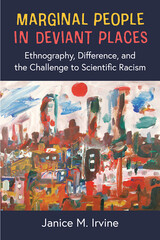 Marginal People in Deviant Places: Ethnography, Difference, and the Challenge to Scientific Racism
Janice M. Irvine
University of Michigan Press, 2022 Marginal People in Deviant Places revisits twentieth-century ethnographic studies of deviance, arguing that ethnographies that focus on marginal subcultures—ranging from Los Angeles hoboes to men who have sex with other men in St. Louis bathrooms, to taxi dancers in Chicago, to elderly Jews in Venice, California—produce new ways of thinking about social difference more broadly in the United States. Irvine demonstrates how the social scientists who told the stories of these marginalized groups offered an early challenge to then-dominant narratives of scientific racism and then offers a social history of certain American outsiders and a prehistory of the academic fields of ethnic studies and sexuality studies. Through the stories Irvine recounts in this book, she identifies an American paradox represented in a simultaneous desire for and rejection of outsiders and describes the rise of an outsider capitalism that integrates difference into American society by marketing it.
Place plays a crucial role in this work as Irvine examines its role in shaping ethnographies about outsiders and therefore understandings of social difference. Irvine has visited the sites of each of the ethnographies about which she writes, collecting photos, videos, and archival materials that will help readers understand the importance of place in the generation of particular ethnographic stories. The open-access online edition of this book is richly illustrated to help convey the deep sense of emplacement of the ethnographies discussed in this book and includes a series of interviews with sociologists about how they conduct their work and understand their forebears.
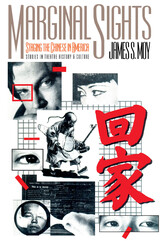 Marginal Sights: Staging the Chinese in America
James S. Moy
University of Iowa Press, 1994 Since the beginning of the Western tradition in drama, dominant cultures have theatrically represented marginal or foreign racial groups as other—different form "normal" people, not completely human, uncivilized, quaint, exotic, comic. Playwrights and audiences alike have been fascinated with racial difference, and this fascination has depended upon a process of fetishization. By the time Asians appeared in the United States, the framework for their constructed Lotus Blossom and Charlie Chan stereotypes had preceded them. InMarginal Sights, James Moy dismantles these stereotypes in an unrelenting attack on Anglo American institutions of racial representation. Reading the Chinese stereotype through several media, Moy notes the consistency of Anglo America's construction of what he terms Chineseness. He rejects the dominant cultural assertion that stereotypes contain a germ of truth, arguing instead that this so-called germ of truth is itself a construction the serves the evolving social and material concerns of an often sinophobic white America. Through time the stereotypes have taken on a life of their own, and those who sought to overturn them have often failed, thus seemingly validating them. Moy, on the other hand, spotlights the constructed Orientals so brilliantly that the real Asian Americans behind them can become visible at last. Consisting of ten readings of Chineseness in America, this sophisticated text reveals the source of representational racial oppression in America. Moy examines diverse sites of representation from museum displays, cartoons, and plays to early photographs, films, circus acts, performance art, and pornography. His persuasive assault on the responsible institutions is uncompromising. However, with surprising insouciance, Moy juxtaposes wit with the often grim details of America's representational legacy. While Marginal Sights focuses on Chineseness in America, Moy makes explicit its applicability to all institutionally managed representations, racial and otherwise. Anyone interested in Anglo-American and Asian American studies, cultural and film studies, theatre history, communication, and psychology will need to read this book.
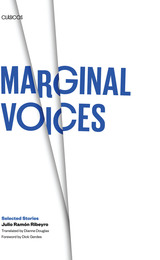 Marginal Voices: Selected Stories
By Julio Ramón Ribeyro
University of Texas Press, 1993 Julio Ramón Ribeyro has been widely acclaimed Peru's master storyteller. Until now, however, few of his stories have been translated into English. This volume brings together fifteen stories written during the period 1952-1975, which were collected in the three volumes of La palabra del mudo.
Ribeyro's stories treat the social problems brought about by urban expansion, including poverty, racial and sexual discrimination, class struggles, alienation, and violence. At the same time, elements of the fantastic playfully interrupt some of the stories. As Ribeyro's characters become swept up in circumstances beyond their understanding, we see that the only freedom or dignity left them comes from their own imaginations.
The fifteen stories included here are "Terra Incognita," "Barbara," "The Featherless Buzzards," "Of Modest Color," "The Substitute Teacher," "The Insignia," "The Banquet," "Alienation (An Instructive Story with a Footnote)," "The Little Laid Cow," "The Jacaranda Trees," "Bottles and Men," "Nothing to Do, Monsieur Baruch," "The Captives," "The Spanish," and "Painted Papers."
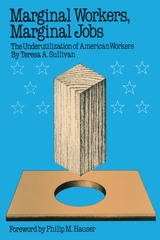 Marginal Workers, Marginal Jobs: The Underutilization of American Workers
By Teresa A. Sullivan
University of Texas Press, 1978 Unemployment levels have received a great deal of attention and discussion in recent years. However, another labor category—underemployment—has virtually been ignored. Underutilized or underemployed workers are those who are experiencing inadequate hours of work, insufficient levels of income, and mismatch of occupation and skills. Marginal Workers, Marginal Jobs addresses two principal issues: how can we measure underemployment, and how can we explain its prevalence?
To answer the first question, Teresa Sullivan examines yardsticks in use, demonstrates their inadequacy, and develops a different measure that is easy to interpret and is usable by both demographers and economists. In answering the second, she analyzes 1960 and 1970 census data to determine the relative effects of population composition and job structure on levels of employment.
One of the important contributions of Sullivan's study is to distinguish between marginal workers and marginal jobs in explaining underutilization. Previous explanations, including the widely used dual market theory, have not stressed this analytic distinction. In addition, her work accounts separately for the various types of marginality and seeks to show the condition of workers who are marginal on more than one count—for example, those who are both young and black, or old and female.
A provocative study based on large samples of the U.S. population, this book raises important questions about a critical subject and makes a significant contribution to the theory of underutilization.
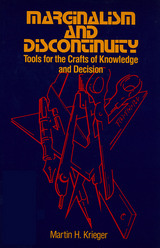 Marginalism and Discontinuity: Tools for the Crafts of Knowledge and Decision
Martin H. Krieger
Russell Sage Foundation, 1989 Marginalism and Discontinuity is an account of the culture of models employed in the natural and social sciences, showing how such models are instruments for getting hold of the world, tools for the crafts of knowing and deciding. Like other tools, these models are interpretable cultural objects, objects that embody traditional themes of smoothness and discontinuity, exchange and incommensurability, parts and wholes. Martin Krieger interprets the calculus and neoclassical economics, for example, as tools for adding up a smoothed world, a world of marginal changes identified by those tools. In contrast, other models suggest that economies might be sticky and ratchety or perverted and fetishistic. There are as well models that posit discontinuity or discreteness. In every city, for example, some location has been marked as distinctive and optimal; around this created differentiation, a city center and a city periphery eventually develop. Sometimes more than one model is applicable—the possibility of doom may be seen both as the consequence of a series of mundane events and as a transcendent moment. We might model big decisions or entrepreneurial endeavors as sums of several marginal decisions, or as sudden, marked transitions, changes of state like freezing or religious conversion. Once we take models and theory as tools, we find that analogy is destiny. Our experiences make sense because of the analogies or tools used to interpret them, and our intellectual disciplines are justified and made meaningful through the employment of characteristic toolkits—a physicist's toolkit, for example, is equipped with a certain set of mathematical and rhetorical models. Marginalism and Discontinuity offers a provocative and wide-ranging consideration of the technologies by which we attempt to apprehend the world. It will appeal to social and natural scientists, mathematicians and philosophers, and thoughtful educators, policymakers, and planners.
 Marginalized in the Middle
Alan Wolfe
University of Chicago Press, 1996 Addressing volatile social issues such as gender, pornography, race, welfare, immigration, and schooling, Alan Wolfe examines the ills of American society in the 1990s. He shows that it is possible to be critical and fair at the same time, and concludes that social criticism does not lie within the boundaries of either left-wing or right-wing ideas, but rather is connected to a broad understanding of liberalism. This immensely readable book illustrates the power of social criticism to enlarge discussion of issues at the heart of democracy today.
"In applying a realist approach to controversies over immigration, pornography, race relations, and the apparent communications gap between the genders, Wolfe seeks to demonstrate the advantages of combining the insights of criticism and the tools of social science."—Library Journal
"A plea for a return to liberal thinking, an insistence on the value of 'social criticism beyond politics.' "—Washington Post Book World
"[Wolfe] surveys contemporary public discourse on racial and sexual relations, welfare policy, immigration, pornography, education and cultural politics . . . he manages to bring some fresh thinking to most of these stale debates."—T. J. Jackson Lears, New York Times Book Review
 Margins in the Classroom: Teaching Literature
Kostas Myrsiades and Linda S. Myrsiades, Editors
University of Minnesota Press, 1994 Margins in the Classroom was first published in 1994. Minnesota Archive Editions uses digital technology to make long-unavailable books once again accessible, and are published unaltered from the original University of Minnesota Press editions. For today's teacher of literature, facing a minefield of politics and theory, this book arrives as a much needed guide through the multiplying cultural anxieties of the college classroom. Margins in the Classroom brings together established scholars and emerging voices from diverse backgrounds to show how politics and theory can and do affect the most pressing problems confronting the contemporary teacher of literature. The essays in this volume go beyond questioning and examining existing practices to suggest fresh approaches to teaching the expanding literary canon within the context of the politics of the educational institution. Grounded in literary criticism, psychoanalysis, feminist theory, political economy, sociology, and philosophy, these essays apply new theoretical models to the traditional canon, identify new bodies of literature, and show how theory can be used to analyze these new literatures. Focusing on the politics of teaching and theory in the classroom, the authors explore the present practice and future implications of changing textual analysis, literary theory, and pedagogy. Their essays address the politics of literature as it affects the classroom, the design of courses, and the creation of new courses. They mold theory to the variety of classroom populations and materials the teacher of literature encounters today. The resulting volume bridges the differences between the languages of the classroom instructor and the contemporary theorist. Margins in the Classroom is unique in both the breadth and the depth of its concern over the disturbing, if electric, impact of changes in criticism, theory, and pedagogy in college literature classes as we approach the next century of academic instruction. Kostas Myrsiades is professor of comparative literature, and Linda S. Myrsiades is professor of English, both at West Chester University. Kostas Myrsiades is editor of College Literature, where Linda S. Myrsiades is an associate editor.
The Margins of Late Medieval London, 1430–1540
Charlotte Berry
University of London Press, 2022 A powerful study of medieval London’s urban fringe.
The Margins of Late Medieval London seeks to unpack the complexity of urban life in the medieval age, offering a detailed and novel approach to understanding London beyond its grand institutions and social bodies. Using a combination of experimental digital, quantitative, and qualitative methodologies, the volume casts new light on urban life at the level of the neighborhood and considers the differences in economy, society, and sociability which existed in different areas of a vibrant premodern city. This book focuses on the dynamism and mobility that shaped city life, integrating the experiences of London’s poor and migrant communities and how they found their place within urban life. It describes how people found themselves marginalized in the city, and the strategies they would employ to mitigate that precarious position.
Margins of Philosophy
Jacques Derrida
University of Chicago Press, 1982 "In this densely imbricated volume Derrida pursues his devoted, relentless dismantling of the philosophical tradition, the tradition of Plato, Kant, Hegel, Nietzsche, Husserl, Heidegger—each dealt with in one or more of the essays. There are essays too on linguistics (Saussure, Benveniste, Austin) and on the nature of metaphor ("White Mythology"), the latter with important implications for literary theory. Derrida is fully in control of a dazzling stylistic register in this book—a source of true illumination for those prepared to follow his arduous path. Bass is a superb translator and annotator. His notes on the multilingual allusions and puns are a great service."—Alexander Gelley, Library Journal
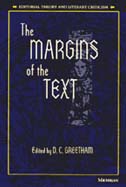 The Margins of the Text
D. C. Greetham, Editor
University of Michigan Press, 1997 These days, the margins have become a powerful position from which to mount a critique of contemporary society, culture, and text. From gay and lesbian studies to postcolonial or "subaltern" criticism, formerly marginalized perspectives have brought provocative new insights into many fields of inquiry. But until comparatively recently, the extremely powerful, even culture-defining, discourse of textual editing has been immune to such influences.
The Margins of the Text is the first attempt to collect a body of essays concerned with specific aspects of the marginal as they relate to text. The volume is divided into two sections. The first part assembles essays concerned with the margins of textual discourse and explores the function of discourses not previously recognized as significant to scholarly editing, such as those of class, race, gender, and sexual orientation. The second section attends to the textual margins in the bibliographical sense--the margins of the book, in which there has been so much recent interest. The two parts of the collection are clearly interrelated, since both study the effects of margins as a form of cultural discourse.
As a whole, the collection spans several periods (medieval, Renaissance, eighteenth-century to modern), several disciplines (drama, literature, art history, politics, and philosophy), and offers a wide-ranging consideration of a single topic as it is manifested in various genres, formats, and media. The contributors are among the most respected textual/critical theorists in their fields.
The Margins of the Text will become a standard reference in the field, and will be read profitably by culture critics and social historians as well as textual critics and editors.
D. C. Greetham is Professor of English and Medieval Studies, City University of New York Graduate School.
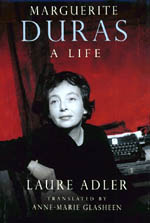 Marguerite Duras: A Life
Laure Adler
University of Chicago Press, 2000 When Marguerite Duras was published in France in 1998, it reached the top of the bestseller lists immediately, and Duras, who had led an unapologetically controversial life, was propelled once again into the headlines. The author of The Lover, Hiroshima Mon Amour, and The War: A Memoir, Duras has long been a symbol of France's complex role in World War II and the country's troubled colonial relations in Asia, as well as a fascinating embodiment of the tensions between autobiography and fiction. Now available in English, Marguerite Duras confronts the truths and falsehoods in the life of the enigmatic author.
Adler, through her exploration of the events central to Duras's career, including her affair with and eventual denunciation of a Nazi collaborator and her childhood in Indochina, reveals Duras as the consummate pragmatist. She has combed through archives, unearthed letters, studied unpublished manuscripts, and interviewed scores of Duras's friends, lovers, enemies, and colleagues—as well as Duras herself—and she emerges with the richest portrait we have of Duras's life: her upbringing, her student days at the Sorbonne, her career as a novelist and filmmaker, and her involvement in French politics through the most complex decades of the twentieth century. "The masks and the truth" was the headline of a French review of Marguerite Duras, and Adler explores both, probing the line between fiction and selfhood and between political activities and personal responsibility.
 Marguerite Yourcenar: Inventing a Life
Josyane Savigneau
University of Chicago Press, 1993 Marguerite Yourcenar was born Marguerite de Crayencour in Brussels in 1903. She lost her mother at birth, her native Belgium at the age of six, and was forced to flee her adopted France at twelve. It is little wonder that Yourcenar, whose own early past receded so quickly into personal legend, would one day describe her writing as the "passionate reconstitution , at once detailed and free, of a moment or a man out of the past." One of the most respected writers in the French language, best known as the author of Memoirs of Hadrian and The Abyss, she was awarded countless literary honors, culminating with her election in 1980 to the Académie Française (she was the first woman ever to be so honored). As complex, erudite, and intriguing as her work, Yourcenar's life has resisted its own passionate reconstitution until now, in part because of the writer's deliberate elusiveness, even in her autobiographical trilogy.
Here, in its intricate and often contradictory detail, is Marguerite Yourcenar's story, one in which loss and learning intertwined almost from the first and in which love assumed a strangely paradoxical place. Drawing on letters, diaries, and interviews with Yourcenar's friends, colleagues, and lovers, Josyane Savigneau's biography paints an intimate portrait of an artist who lived according to her own, occasionally contrary, terms: a Frenchwoman ardently in love with her native tongue, yet who lived half her life in New England; an avid seductress of women, who spent nearly forty years with one woman, yet fell in love early and late in her life with two young men; a powerful female writer whose most memorable protagonists were male, from Alexis of her first novel to the later historical characters Hadrian and Zeno. Savigneau weaves these and other contraries of Yourcenar's life into a vibrant and engrossing pattern.
Editor of "Le Monde des Livres," the literary pages of France's most influential newspaper, Savigneau first met Marguerite Yourcenar on assignment in 1984. What began as a professional relationship gradually turned into a friendship. Her personal insights into that life enrich this exhaustively documented text. Following the lead set by Yourcenar in her memoir Dear Departed, the biographer found herself "searching for a truth that is multiple, unstable, evasive, sometimes saddening, and at first glance scandalous but that one cannot approach without often feeling for human beings in all their frailty a certain measure of kinship and, always, a sense of pity." Yourcenar's profound intelligence and sympathy, her foibles and obsessions, her accomplishments and trials: all are revealed here in an uncompromising portrait of an incomparable artist.
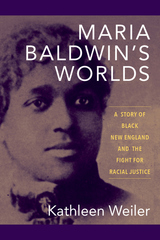 Maria Baldwin's Worlds: A Story of Black New England and the Fight for Racial Justice
Kathleen Weiler
University of Massachusetts Press, 2019 Maria Baldwin (1856–1922) held a special place in the racially divided society of her time, as a highly respected educator at a largely white New England school and an activist who carried on the radical spirit of the Boston area's internationally renowned abolitionists from a generation earlier.
African American sociologist Adelaide Cromwell called Baldwin “the lone symbol of Negro progress in education in the greater Boston area” during her lifetime. Baldwin used her respectable position to fight alongside more radical activists like William Monroe Trotter for full citizenship for fellow members of the black community. And, in her professional and personal life, she negotiated and challenged dominant white ideas about black womanhood. In Maria Baldwin's Worlds, Kathleen Weiler reveals both Baldwin's victories and what fellow activist W. E. B. Du Bois called her “quiet courage” in everyday life, in the context of the wider black freedom struggle in New England.
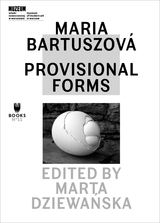 Maria Bartuszová: Provisional Forms
Edited by Marta Dziewanska
Museum of Modern Art in Warsaw, 2015 The work of Slovak sculptor Maria Bartuszová (1936–96) was first presented to international audiences in Kassel in 2007. Although her art has appeared in influential exhibitions and been included in prestigious contemporary art collections, up until now, she has yet to receive the widespread recognition she deserves. Dziewanska’s book offers distinct perspectives on Bartuszová’s work from renowned international critics in an effort to increase our awareness of her sculptures.
Working alone behind the Iron Curtain, Bartuszová was one of a number of female artists who not only experimented formally and embarked intuitively on new themes, but who, because they were at odds with mainstream modernist trends, remained in isolation or in a marginalized position. Revealing her dynamic treatment of plaster—a material that, from a sculptor’s point of view, is both primitive and common—the book deftly reveals how Bartuszová experimented with materials, never hesitating to treat tradition, accepted norms, and trusted techniques as simply transitory and provisional. Offering a much-needed history of a vibrant body of work, Maria Bartuszová: Provisional Forms is an important contribution to the literature on great female artists.
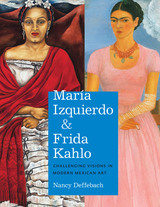 María Izquierdo and Frida Kahlo: Challenging Visions in Modern Mexican Art
By Nancy Deffebach
University of Texas Press, 2015 María Izquierdo (1902–1955) and Frida Kahlo (1907–1954) were the first two Mexican women artists to achieve international recognition. During the height of the Mexican muralist movement, they established successful careers as easel painters and created work that has become an integral part of Mexican modernism. Although the iconic Kahlo is now more famous, the two artists had comparable reputations during their lives. Both were regularly included in major exhibitions of Mexican art, and they were invariably the only women chosen for the most important professional activities and honors. In a deeply informed study that prioritizes critical analysis over biographical interpretation, Nancy Deffebach places Kahlo’s and Izquierdo’s oeuvres in their cultural context, examining the ways in which the artists participated in the national and artistic discourses of postrevolutionary Mexico. Through iconographic analysis of paintings and themes within each artist’s oeuvre, Deffebach discusses how the artists engaged intellectually with the issues and ideas of their era, especially Mexican national identity and the role of women in society. In a time when Mexican artistic and national discourses associated the nation with masculinity, Izquierdo and Kahlo created images of women that deconstructed gender roles, critiqued the status quo, and presented more empowering alternatives for women. Deffebach demonstrates that, paradoxically, Kahlo and Izquierdo became the most successful Mexican women artists of the modernist period while most directly challenging the prevailing ideas about gender and what constitutes important art.
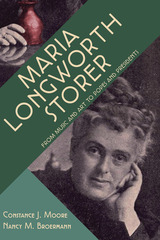 Maria Longworth Storer: From Music and Art to Popes and Presidents
Constance J. Moore; Nancy M. Broermann
Ohio University Press, 2019 Published by the University of Cincinnati Press While the adage may go, “Behind every great man is a great woman,” the story of Maria Longworth Storer necessitates a new adage—at the front of every great city is a great woman. After being shunted into the biographies and history books of other people, Longworth Storer is now finally given center stage on the one hundred and seventieth anniversary of her birth. Maria Longworth Storer: From Music and Art to Popes and Presidents is the most comprehensive biography of this one of a kind Cincinnatian. Known as the founder of the first female-run manufacturing company in the United States, Rookwood Pottery, Longworth Storer was passionate about women’s rights, her city, and issues of poverty and the arts. She owned Rookwood pottery for nine years, and then transferred ownership after earning recognition at the Exhibition of American Art Industry in Philadelphia and receiving a gold medal at the Exposition Universelle in Paris. Aside from her success with Rookwood, Longworth Storer was central to making the Queen City the major cultural landmark it is today. Although the rest of her life was no less remarkable as the wife of notorious diplomat Bellamy Storer, later embroiled in the famous Roosevelt-Storer scandal, little has been written about her contributions and exploits in diplomatic relations and her powerful influence on turn-of-the-twentieth-century political leaders. Featuring new archival research, and never before seen photos of the Storer family, authors Constance J. Moore and Nancy M. Broermann have compiled a portrait of Maria Longworth Storer that is rich in detail, fitting to both the wide, often eclectic, breadth of Longworth Storer’s projects, and to the depth of her impact on leaders from Washington D.C. to Europe. Moving through major moments in both American and Cincinnati history, and intersecting with significant historical figures including Teddy Roosevelt and William Howard Taft, Moore and Broermann expose the broader historical narrative of Longworth Storer’s life without letting her unique spirit and individual accomplishments become overshadowed by them. Through thoughtful, balanced narrative, readers get to know a remarkable woman whose fascinating and dramatic life as a political figure, women’s rights advocate, and patron of the arts has had a long lasting legacy on the Queen City and the Shaping of our nation’s diplomatic policies.
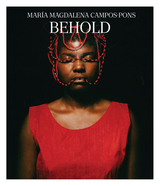 María Magdalena Campos-Pons: Behold
Carmen Hermo
J. Paul Getty Trust, The, 2023 This vibrantly illustrated survey of the career of contemporary artist María Magdalena Campos-Pons delves into her diverse oeuvre of painting, drawing, photography, sculpture, film, and performance.
María Magdalena Campos-Pons (b. 1959) makes powerful work that holds and beholds the stories of historically silenced peoples and urges societal change. Her journey as an artist, teacher, and activist has taken her from Cuba through the United States, and her autobiographical compositions honor her Nigerian and Chinese ancestors while also facing the future. With an artistic practice that crosses boundaries, intertwines media—from photography to sculpture, film to performance—and references traditions and beliefs ranging from feminism to Santería, Campos-Pons’s work is deeply layered and complex.
This volume, the first critical look at the artist’s oeuvre in nearly two decades, surveys the concerns, materials, and places invoked throughout her forty-year career. Thoughtful essays explore her vibrant, arresting artwork, which confronts issues of agency and the construction of race and belonging and challenges us to reckon with these issues in our own lives.
This volume, copublished with the Brooklyn Museum, accompanies an exhibition on view at the Brooklyn Museum from September 15, 2023, to January 14, 2024, the Nasher Museum of Art at Duke University from February 15 to June 9, 2024, the Frist Art Museum from September 27, 2024, to January 5, 2025, and the J. Paul Getty Museum at the Getty Center from February 11 to May 4, 2025.
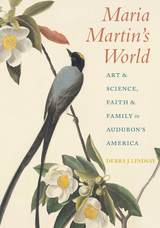 Maria Martin's World: Art and Science, Faith and Family in Audubon’s America
Debra J. Lindsay
University of Alabama Press, 2018 The first book-length treatment of one of John James Audubon’s background painters.
Maria Martin (1796–1863) was an evangelical Lutheran from Charleston, South Carolina, who became an accomplished painter within months of meeting John James Audubon. Martin met Audubon through her brother-in-law, Reverend John Bachman, who befriended Audubon while passing through Charleston on route to Florida where he expected to find new avian species. Martin was an amateur artist, but by the time Audubon left, she had familiarized herself with his style of drawing. Six months after their initial meeting, her background botanicals were deemed good enough to embellish Audubon’s exquisite bird paintings.
Martin’s botanicals and insects appeared in volumes two and four of The Birds of America (1830–1838). She painted snakes for John Edwards Holbrook’s North American Herpetology (1842) and assisted in drafting the descriptive taxonomies prepared by John Bachman—who later became her husband in 1848 following the death of her older sister—for The Viviparous Quadrupeds of North America (1846–1854). Until now, her contributions have been unknown to all but the most astute students of natural history and art history and a close circle of family and friends.
Maria Martin’s World is a heavily illustrated volume examining how Maria Martin learned to paint aesthetically beautiful botanicals with exacting accuracy. Drawing on deep research into archival documents and family-held artifacts, Debra Lindsay brings Maria Martin out from behind the curtain of obscurity and disinformation that has previously shrouded her and places her centrally in her own time and milieu. In the telling of Maria Martin’s story, Lindsay also uncovers many nuances of the behavior and actions of the two prominent men in her life that readers interested in Audubon and Bachman will find noteworthy.
Martin was a gifted artist recognized for having contributed beautiful paintings to a natural history. But beyond the natural world this is a biography of an evangelical Lutheran steeped in the faith of her German ancestors and raised to respect the patriarchal norms of her time. Maria Martin pursued her scientific and artistic interests only when they did not conflict with her religious and familial responsibilities.
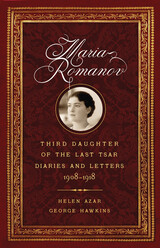 Maria Romanov: Third Daughter of the Last Tsar, Diaries and Letters, 1908–1918
Helen Azar
Westholme Publishing, 2019 The First English Translation of the Intimate Writings of a Member of the Last Russian Imperial Family
In the twilight of the nineteenth century, a third daughter was born to Tsar Nicholas II and his wife Alexandra. Grand Duchess Maria Nikolaevna—known to her family and friends simply as “Mashka”—grew into an empathetic, down-to-earth girl, unaffected by her imperial status. Often overshadowed by her two older sisters, Olga and Tatiana, and later, her brother Alexei and younger sister Anastasia, Maria ultimately proved to have a uniquely strong and solid personality.
In Maria Romanov: Third Daughter of the Last Tsar, Diaries and Letters, 1908–1918, by translator and researcher Helen Azar with George Hawkins, Mashka’s voice is heard again through her intimate writings, presented for the first time in English. The Grand Duchess was much more than a pretty princess wearing white dresses in hundreds of faded sepia photographs; Maria’s surviving diaries and letters offer a fascinating insight into the private life of a loving family—from festivals and faith, to Rasputin and the coming Revolution; it is clear why this middle child ultimately became a pillar of strength and hope for them all. Maria’s gentle character belied her incredible courage, which emerged in the darkest hours of her brief life. “The incarnation of modesty elevated by suffering,” as Maria was described during the last weeks of her life, she was able to maintain her kindness and optimism, even in the midst of violence and degradation.
On a stuffy summer night in 1918, only a few weeks after her nineteenth birthday, Maria was murdered along with the rest of her family in a cellar of a house chosen for this “special purpose.” Two sets of charred remains, confirmed to be Maria’s and her brother Alexei’s, were not discovered until almost ninety years later, separately from those of the other victims of the massacre. As the authors relate, it is still unknown if these remains will ever be allowed to be laid to rest.
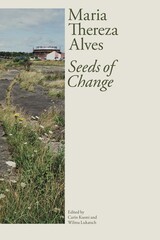 Maria Thereza Alves: Seeds of Change
edited by Carin Kuoni and Wilma Lukatsch
Amherst College Press, 2022 In an era of climate change, extractivist economies, and forced mobility, who and what belongs? Throughout her prolific career, Brazilian artist Maria Thereza Alves has focused precisely on this question. Perhaps her most iconic, generative, and expansive work is Seeds of Change, a twenty-year investigation into the hidden history of ballast flora—displaced plant seeds found in the soil used to balance shipping vessels during the colonial period. The project examines the influx and significance of imported plants, materializing at port cities across several continents: Marseille, Reposaari, Liverpool, Exeter and Topsham, Dunkerque, Bristol, Antwerp, and most recently New York, where it was awarded the Jane Lombard Prize for Art and Social Justice by the Vera List Center for Art and Politics at The New School. In each city, Seeds of Change has revealed the entangled relationship between “alien” plant species and the colonial maritime trade of goods and enslaved peoples, contrasting their seemingly innocuous beauty with the violent history associated with their arrival. By focusing on ballast flora, Alves invites us to de-border postcolonial historical narratives and consider a “borderless history.” The first monograph of Alves’s historic project, Seeds of Change is edited by Carin Kuoni and Wilma Lukatsch and features essays by the artist as well as Katayoun Chamany, Seth Denizen, Jean Fisher, Yrjö Haila, Richard William Hill, Heli M. Jutila, J. Kēhaulani Kauanui, Lara Khaldi, Tomaž Mastnak, Marisa Prefer, and Radhika Subramaniam.
 Marian Anderson: A Singer's Journey
Allan Keiler
University of Illinois Press, 2002 Marian Anderson was a woman with two disparate voices. The first--a powerful, majestic contralto spanning four octaves--catapulted her from Philadelphia poverty to international fame. A second, softer voice emanated from her mere presence: an unwavering refrain of opportunity and accomplishment in the face of racial prejudice. Allan Keiler chronicles the life of the legendary singer and activist from the childhood manifestation of her musical genius to her worldwide celebrity. As he shows, community and familial support could not shield her from the economic hardship and bigotry she encountered in her early performing days. Early successes in London and Berlin set the stage for her American breakthrough while the triumphant 1939 Lincoln Memorial concert established her immediately as an icon in the struggle against discrimination. Keiler reveals a woman more comfortable as artist than activist. But if Anderson's intense privacy and devotion to her work distanced her from a direct role in the civil rights movement, she remained a powerful symbol of possibility. Drawing on rare archives and meetings with Anderson before her death, Marian Anderson is a magnificent study of a groundbreaking American artist.
Marian McPartland's Jazz World: All in Good Time
Marian McPartland
University of Illinois Press, 1987 In this collection of musical portraits, jazz pianist and radio host Marian McPartland pays tribute to such beloved and legendary figures as Benny Goodman, Bill Evans, Joe Morello, Paul Desmond, Alec Wilder, Mary Lou Williams, and others. McPartland’s reminiscences and anecdotes about these jazz greats are informed by her encyclopedic knowledge of their music, making this richly detailed collection an important addition to the literature of jazz. In a preface to this edition, McPartland extends her commentary to include details of her long-running National Public Radio show “Marian McPartland’s Piano Jazz” and memories of her late husband, famed Chicago trumpeter Jimmy McPartland.
Mariana Mesa: Seven Prehistoric Settlements in West-Central New Mexico
Charles R. McGimsey III
Harvard University Press, 1980 A detailed report on the excavations of, and a comprehensive account and analysis of artifacts and materials from, seven settlements that varied in size from units of one or two families to small communities of several dozen individual houses.
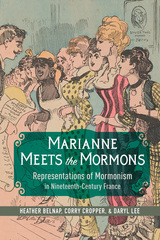 Marianne Meets the Mormons: Representations of Mormonism in Nineteenth-Century France
Heather Belnap, Corry Cropper, and Daryl Lee
University of Illinois Press, 2022 In the nineteenth century, a fascination with the Church of Jesus Christ of Latter-day Saints made Mormons and Mormonism a common trope in French journalism, art, literature, politics, and popular culture. Heather Belnap, Corry Cropper, and Daryl Lee bring to light French representations of Mormonism from the 1830s to 1914, arguing that these portrayals often critiqued and parodied French society. Mormonism became a pretext for reconsidering issues such as gender, colonialism, the family, and church-state relations while providing artists and authors with a means for working through the possibilities of their own evolving national identity. Surprising and innovative, Marianne Meets the Mormons looks at how nineteenth-century French observers engaged with the idea of Mormonism in order to reframe their own cultural preoccupations.
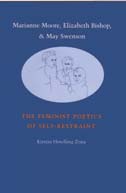 Marianne Moore, Elizabeth Bishop, and May Swenson: The Feminist Poetics of Self-Restraint
Kirstin Hotelling Zona
University of Michigan Press, 2002 This book examines the strategic possibilities of poetic self-restraint. Marianne Moore,Elizabeth Bishop, and May Swenson all wrote poetry that is marked by a certain reserve--precisely the motive against which most feminist poets and critics of the last thirty years have established themselves. Kirstin Hotelling Zona complicates this dichotomy by examining the conceptions of selfhood upon which it depends. She argues that Moore, Bishop, and Swenson expressed their commitment to feminism by exposing its most treasured assumptions: they not only challenge the ideal of autonomous self-definition, but also contest the integrity of a bodily or sexual authenticity by which that ideal is often measured.
In recent years critical studies of Bishop and Moore have flourished, a large percentage of them devoted to explorations of sexuality and gender. A gap is growing, however, between feminist repossessions of Moore and Bishop and recent readings of their antiessentialist poetics. On the one hand, these poets are appearing more frequently in the feminist canon, but the price of this inclusion is usually the suppression of their strategies of self-restraint. While Zona questions the poetic privileging of self-expression, she establishes contiguity between feminist poetry and developments in American poetry at large. In doing so she asserts the centrality of feminist poetry within discussions of contemporary American poetry, thereby challenging the common perception of feminist poetry as an "alternative" (which often means auxiliary) genre.
Kirstin Hotelling Zona is Assistant Professor of Poetry and Poetics, Illinois State University.
 Marianne Moore: Questions of Authority
Cristanne Miller
Harvard University Press, 1995 Not confessional or autobiographical, not openly political or gender-conscious: all that Marianne Moore’s poetry is not has masked what it actually is. Cristanne Miller’s aim is to lift this mask and reveal the radically oppositional, aesthetic, and political nature of the poet’s work. A new Moore emerges from Miller’s persuasive book—one whose political engagement and artistic experiments, though not cut to the fashion of her time, point the way to an ambitious new poetic.
Miller locates Moore within the historical, literary, and family environments that shaped her life and work, particularly her sense and deployment of poetic authority. She shows how feminist notions of gender prevalent during Moore’s youth are reflected in her early poetry, and tracks a shift in later poems when Moore becomes more openly didactic, more personal, and more willing to experiment with language typically regarded as feminine. Distinguishing the lack of explicit focus on gender from a lack of gender-consciousness, Miller identifies Moore as distinctly feminist in her own conception of her work, and as significantly expanding the possibilities for indirect political discourse in the lyric poem. Miller’s readings also reveal Moore’s frequent and pointed critiques of culturally determined power relationships, those involving race and nationality as well as gender.
Making new use of unpublished correspondence and employing close interpretive readings of important poems, Miller revises and expands our understanding of Marianne Moore. And her work links Moore—in her radically innovative reactions to dominant constructions of authority—with a surprisingly wide range of late twentieth-century women poets.
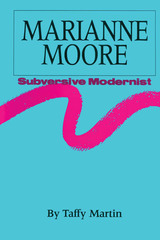 Marianne Moore, Subversive Modernist
By Taffy Martin
University of Texas Press, 1986 Myth and misconception have obstructed a clear understanding of the poetry and person of Marianne Moore. In this groundbreaking study, Taffy Martin delves beneath the layers of myth and recaptures the excitement that Moore's contemporaries, particularly William Carlos Williams, felt when they encountered her poetry. She reveals that, far from being a stanch upholder of Modernist order and stasis, Moore continually undermines the stability of her own medium, language. Unlike the writings of other Modernist poets, such as T. S. Eliot, who tried to create islands of order in the seas of twentieth-century fragmentation, Moore's work shows surprising awareness of that fragmentation. In this way, she anticipates the thematic preoccupation of Postmodernist writers and critics. In Marianne Moore, Subversive Modernist, Taffy Martin combines traditional scholarship and contemporary critical theory to create a feminist reading of one of the twentieth century's most difficult poets. In so doing, she places Moore in the tradition of Modernism, defines Moore's quarrels with it, and thus produces a broader understanding of both the poet and the movement. Drawing on Moore's unpublished correspondence, her reading notebooks, and her workbooks, as well as feminist criticism's attention to writers who elude traditional critical approaches, this excellent study provides much-needed insights into the Modernism, life, and art of Marianne Moore.
Maria's Journey
Ramon Arredondo and Trisha (Hull) Arredondo
Indiana Historical Society Press, 2010 Born into the Mexican Revolution, Maria Perez entered an arranged marriage at age fourteen to Miguel Arredondo. The couple and their tiny daughter immigrated to the United States in the 1920s, living in a boxcar while Miguel worked for a Texas railroad and eventually settling in East Chicago, Indiana, where Miguel worked for Inland Steel. Their story includes much of early-twentieth-century America: the rise of unions, the plunge into the Great Depression, the patriotism of World War II, and the starkness of McCarthyism. It is flavored by delivery men hawking fruit and ice, street sports, and Saturday matinees that began with newsreels. Immigration status colors every scene, adding to their story deportation and citizenship, generational problems unique to new immigrants, and a miraculous message of hope.
 Mariátegui and Latin American Marxist Theory
Marc Becker
Ohio University Press, 1993 José Carlos Mariátegui, the Peruvian political theorist of the 1920s, was instrumental in developing an indigenous Latin American revolutionary Marxist theory. He rejected a rigid, orthodox interpretation of Marxism and applied his own creative elements, which he believed could move a society to revolutionary action without the society having to depend upon more traditional economic factors. His interpretation of Peruvian history had a profound effect upon subsequent social movements throughout Latin America.
This volume reviews the essential elements of Mariátegui's thought and important influences on his intellectual development. It demonstrates the role he played in defining a Latin american identity, the nature of his intellectual contribution to the development of indigenous revolutionary movements in Latin America, and the inflluence he had on successful revolutionary movements in Cuba and Nicaragua. An understanding of Mariátegui's thought is fundamental to understanding the nature of revolutionary changes in Latin America.
The Maricopas: An Identification from Documentary Sources
Paul H. Ezell
University of Arizona Press, 1963 The Anthropological Papers of the University of Arizona is a peer-reviewed monograph series sponsored by the School of Anthropology. Established in 1959, the series publishes archaeological and ethnographic papers that use contemporary method and theory to investigate problems of anthropological importance in the southwestern United States, Mexico, and related areas.
Marie Blythe
Howard Frank Mosher
University Press of New England, 2012 Howard Frank Mosher is one of the best-loved writers of northern New England, one who has “created a literary landscape as textured as anything produced by the U. S. Geological Survey,” according to USA Today. His “greatest gift,” says the Washington Post, is “his talent for creating lively, living characters.” One of his most vivid and memorable characters is Marie Blythe. At the dawn of the twentieth century, a young girl with a felicitous name immigrates to Vermont from French Canada. She grows up confronting the grim realities of life with an indomitable spirit—nursing victims of a tuberculosis epidemic, enduring a miscarriage alone in the wilderness, and coping with the uncertainties of love. In Marie Blythe, Mosher has created a strong-minded, passionate, and truly memorable heroine.
Marie Blythe
Howard Frank Mosher
Brandeis University Press, 2022 A new edition of a classic novel with a strong female lead.
Howard Frank Mosher is one of the best-loved writers of northern New England. One of his most vivid and memorable characters is Marie Blythe. At the dawn of the twentieth century, a young girl with a felicitous name immigrates to Vermont from French Canada. She grows up confronting the grim realities of life with an indomitable spirit—nursing victims of a tuberculosis epidemic, enduring a miscarriage alone in the wilderness, and coping with the uncertainties of love. In Marie Blythe, Mosher has created a strong-minded, passionate, and truly memorable heroine. This edition features a new introduction by novelist Tom Barbash.
Marie de France and the Poetics of Memory
Logan E. Whalen
Catholic University of America Press, 2008 Marie de France and the Poetics of Memory presents the first exhaustive treatment of the rhetorical use of description and memory in all the narrative works of the late 12th-century poet, Marie de France--the first woman to compose literary texts in French.
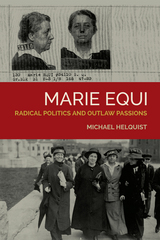 Marie Equi: Radical Politics and Outlaw Passions
Michael Helquist
Oregon State University Press, 2015 Marie Equi explores the fiercely independent life of an extraordinary woman. Born of Italian-Irish parents in 1872, Marie Equi endured childhood labor in a gritty Massachusetts textile mill before fleeing to an Oregon homestead with her first longtime woman companion, who described her as impulsive, earnest, and kind-hearted. These traits, along with courage, stubborn resolve, and a passion for justice, propelled Equi through an unparalleled life journey.
Equi self-studied her way into a San Francisco medical school and then obtained her license in Portland to become one of the first practicing woman physicians in the Pacific Northwest. From Pendleton, Portland, Seattle and beyond to Boston and San Francisco, she leveraged her professional status to fight for woman suffrage, labor rights, and reproductive freedom. She mounted soapboxes, fought with police, and spent a night in jail with birth control advocate Margaret Sanger. Equi marched so often with unemployed men that the media referred to them as her army. She battled for economic justice at every turn and protested the U.S. entry into World War I, leading to a conviction for sedition and a three-year sentence in San Quentin. Breaking boundaries in all facets of life, she became the first well-known lesbian in Oregon, and her same-sex affairs figured prominently in two U.S. Supreme Court cases.
Marie Equi is a finely written, rigorously researched account of a woman of consequence, who one fellow-activist considered “the most interesting woman that ever lived in this state, certainly the most fascinating, colorful, and flamboyant.” This much anticipated biography will engage anyone interested in Pacific Northwest history, women’s studies, the history of lesbian and gay rights, and the personal demands of political activism. It is the inspiring story of a singular woman who was not afraid to take risks, who refused to compromise her principles in the face of enormous opposition and adversity, and who paid a steep personal price for living by her convictions.
Marie Syrkin: Values Beyond the Self
Carole S. Kessner
Brandeis University Press, 2008 A compelling biography of an important eyewitness to the twentieth century.
Marie Syrkin’s life spanned ninety years of the twentieth century, 1899–1989. As a polemical journalist, socialist Zionist, poet, educator, literary critic, translator, and idiosyncratic feminist, she was an eyewitness to and reporter on most of the major events in America, Israel, and Europe. Beautiful as well as brilliant, she had a rich personal life as a lover, wife, mother, and friend. During her lifetime Syrkin’s name was widely recognized in the world of Jewish life and letters. Yet, since Syrkin’s death, recognition of her name is no longer quite so immediate. Carole S. Kessner’s biography restores Syrkin’s fascinating life and legacy for a new generation.
 Marie-Antoinette’s Legacy: The Politics of French Garden Patronage and Picturesque Design, 1775-1867
Susan Taylor-Leduc
Amsterdam University Press, 2023 Challenging the established historiography that frames the French picturesque garden movement as an international style, this book contends that the French picturesque gardens from 1775 until 1867 functioned as liminal zones at the epicenter of court patronage systems. Four French consorts—queen Marie-Antoinette and empresses Joséphine Bonaparte, Marie-Louise and Eugénie—constructed their gardens betwixt and between court ritual and personal agency, where they transgressed sociopolitical boundaries in order to perform gender and identity politics. Each patron endorsed embodied strolling, promoting an awareness of the sentient body in artfully contrived sensoria at the Petit Trianon and Malmaison, transforming these places into spaces of shared affectivity. The gardens became living legacies, where female agency, excluded from the garden history canon, created a forum for spatial politics. Beyond the garden gates, the spatial experience of the picturesque influenced the development of cultural fields dedicated to performances of subjectivity, including landscape design, cultural geography and the origination of landscape aesthetics in France.
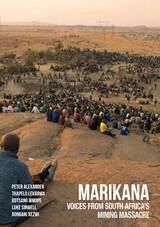 Marikana: Voices from South Africa’s Mining Massacre
Peter Alexander
Ohio University Press, 2013 The Marikana Massacre of August 16, 2012, was the single most lethal use of force by South African security forces against civilians since the end of apartheid. Those killed were mineworkers in support of a pay raise. Through a series of interviews conducted with workers who survived the attack, this account documents and examines the controversial shootings in great detail, beginning with a valuable history of the events leading up to the killing of workers, and including eyewitness accounts of the violence and interviews with family members of those who perished. While the official Farlam Commission investigation of the massacre is still ongoing, many South Africans do not hold much confidence in the government’s ability to examine its own complicity in these events. Marikana, on the other hand, examines the various roles played by the African National Congress, the mine company, and the National Union of Mineworkers in creating the conditions that led to the massacre. While the commission’s investigations take place in a courtroom setting tilted toward those in power, Marikana documents testimony from the mineworkers in the days before official statements were even gathered, offering an unusually immediate and unfiltered look at the reality from the perspective of those most directly affected. Enhanced by vivid maps that make clear the setting and situation of the events, Marikana is an invaluable work of history, journalism, sociology, and activism.
Marin Mersenne and the Study of Harmony: From Sound to Music
Leendert van der Miesen
Amsterdam University Press, 2025 Marin Mersenne and the Study of Harmony delves into the central role of music among the early modern sciences by focusing on the work of the French polymath Marin Mersenne (1588–1648). Although now regarded more as an art than a science, music was for many early modern scholars a universal science for studying the harmonies present in all beings. For Mersenne, music’s ability to be quantified while being experienced aesthetically meant that it was the central science to approximate the sounding and inaudible harmonies present in the world and universe at large. Bringing together Mersenne’s interests in the physics of sound and hearing, musical composition, instruments, curiosities, and music from outside Europe, this book shows why so many scholars were drawn to music and how music was at the center of the early modern debate on the foundations of knowledge.
 Marina Tsvetaeva: The Double Beat of Heaven and Hell
Lily Feiler
Duke University Press, 1994 "No more passionate voice ever sounded in Russian poetry of the 20th century," Joseph Brodsky writes of Marina Tsvetaeva. And yet Western readers are only now starting to discover what Tsvetaeva’s Russian audience has already recognized, "that she was one of the major poetic voices of the century" (Tomas Venclova, The New Republic).
Born to a family of Russian intelligentsia in 1892 and coming of age in the crucible of revolution and war, Tsvetaeva has been seen as a victim of her politicized time, her life and her work marked by exile, neglect, and persecution. This book is the first to show us the poet as she discovered her life through art, shaped as much by inner demons as by the political forces and harsh realities of her day. With remarkable psychological and literary subtlety, Lily Feiler traces these demons through the tragic drama of Tsvetaeva’s life and poetry. Hers is a story full of contradictions, resisting social and literary conventions but enmeshed in the politics and poetry of her time. Feiler depicts the poet in her complex relation to her contemporaries—Pasternak, Rilke, Mayakovsky, Mandelstam, and Akhmatova. She shows us a woman embodying the values of nineteenth-century romanticism, yet radical in her poetry, supremely independent in her art, but desperate for appreciation and love, simultaneously mother and child in her complicated sexual relationships with men and women.
From prerevolutionary Russia to Red Moscow, from pre-World War II Berlin, Prague, and Paris to the Soviet Union under Stalin, Feiler follows the tortuous drama of Tsvetaeva’s life and work to its last tragic act, exposing at each turn the passions that molded some of this century’s most powerful poetry.
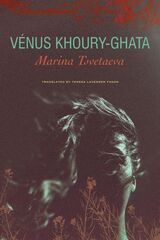 Marina Tsvetaeva: To Die in Yelabuga
Vénus Khoury-Ghata
Seagull Books, 2022 A biographic novel that captures the tempestuous and moving life of the poet Marina Tsvetaeva.
The life of Marina Tsvetaeva (1892–1941) coincided with turbulent years in Russian history. She was an eminent Russian poet and a passionate lover involved with several men at the same time, including Rilke, who chose Lou Andreas-Salomé over her, and Pasternak, who married someone else, but protected her until her death. Her life included many trials such as her poverty during the grueling Russian civil war, her young daughter’s death from hunger in an orphanage, and the death of her husband, who fought against the Communist regime and was executed by the Soviet state. Rejected by official poets, then by the wealthy Russian diaspora in France, she finally returned to her country to end her wandering life. She hanged herself from a rope in an attic from which she could see the field where she had dug with bare hands for potatoes abandoned by local farmers. A poet-martyr of the Stalinist era—buried in an unmarked plot in the cemetery of Yelabuga—Tsvetaeva is brought to life in this poetic biographical novel by celebrated Lebanese author Vénus Khoury-Ghata.
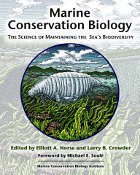 Marine Conservation Biology: The Science of Maintaining the Sea's Biodiversity
Edited by Elliott A. Norse and Larry B. Crowder; Foreword by Michael E. Soule ; Marine Conservation Biology Institute
Island Press, 2005 Humans are terrestrial animals, and our capacity to see and understand the importance and vulnerability of life in the sea has trailed our growing ability to harm it. While conservation biologists are working to address environmental problems humans have created on land, loss of marine biodiversity, including extinctions and habitat degradation, has received much less attention. At the same time, marine sciences such as oceanography and fisheries biology have largely ignored issues of conservation. Marine Conservation Biology brings together for the first time in a single volume, leading experts from around the world to apply the lessons and thinking of conservation biology to marine issues. Contributors including James M. Acheson, Louis W. Botsford, James T. Carlton, Kristina Gjerde, Selina S. Heppell, Ransom A. Myers, Julia K. Parrish, Stephen R. Palumbi, and Daniel Pauly offer penetrating insights on the nature of marine biodiversity, what threatens it, and what humans can and must do to recover the biological integrity of the world's estuaries, coastal seas, and oceans. Sections examine: distinctive aspects of marine populations and ecosystems; threats to marine biological diversity, singly and in combination; place-based management of marine ecosystems; the often-neglected human dimensions of marine conservation. Marine Conservation Biology breaks new ground by creating the conceptual framework for the new field of marine conservation biology -- the science of protecting, recovering, and sustainably using the living sea. It synthesizes the latest knowledge and ideas from leading thinkers in disciplines ranging from larval biology to sociology, making it a must-read for research and teaching faculty, postdoctoral fellows, and graduate and advanced undergraduate students (who share an interest in bringing conservation biology to marine issues). Likewise, its lucid scientific examinations illuminate key issues facing environmental managers, policymakers, advocates, and funders concerned with the health of our oceans.
A Marine Dive-bomber Pilot at Guadalcanal
John Howard McEniry
University of Alabama Press, 1987 Chronicles the World War II experiences of the author
This book chronicles the World War II experiences of the author, who served as a Marine Corps pilot in the South Pacific. Colonel McEniry describes the organization and deployment of a Marine dive-bombing squadron (VMSB-132) in the early days of the war and follows the squadron through its actions in November and December of 1942.
The participation by the squadron in the naval battle of Guadalcanal, November 12-15, 1942, is related in detail and includes the personal experiences of the author on several bombing missions. This battle, described by Admiral Ernest J. King, the Chief of Naval Operations, as “the fiercest naval battle ever fought,” resulted in the loss by the Japanese of two battleships, ten transport ships, and numerous cruisers and destroyers.
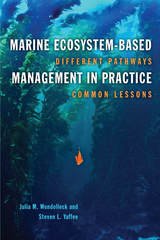 Marine Ecosystem-Based Management in Practice: Different Pathways, Common Lessons
Julia M. Wondolleck and Steven L. Yaffee
Island Press, 2017 Julia Wondolleck and Steven Yaffee are hopeful. Rather than lamenting the persistent conflicts in global marine ecosystems, they instead sought out examples where managers were doing things differently and making progress against great odds. They interviewed planners, managers, community members, fishermen, and environmentalists throughout the world to find the best lessons for others hoping to advance marine conservation. Their surprising discovery? Successful marine management requires not only the right mix of science, law, financing, and organizational structure, but also an atmosphere of collaboration—a comfortable place for participants to learn about issues, craft solutions, and develop the interpersonal relationships, trust, and understanding needed to put plans into action.
Marine Ecosystem-Based Management in Practice is the first practical guide for the marine conservation realm. In a unique collection of case studies, the authors showcase successful collaborative approaches to ecosystem-based management. The authors introduce the basic concepts of ecosystem-based management and five different pathways for making progress from community to multinational levels. They spotlight the characteristics that are evident in all successful cases —the governance structures and social motivations that make it work. Case analyses ranging from the Gulf of Maine to the Channel Islands in Southern California comprise the bulk of the book, augmented by text boxes showcasing examples of guiding documents important to the process. They devote several ending chapters to discussion of the interpersonal relationships critical to successful implementation of marine ecosystem-based management. The book concludes with a discussion of the implications for policy and on-the-ground practice.
This book offers a hopeful message to policy makers, managers, practitioners, and students who will find this an indispensable guide to field-tested, replicable marine conservation management practices that work.
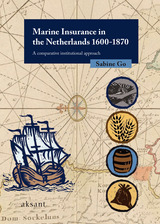 Marine Insurance in the Netherlands 1600-1870: A Comparative Institutional Approach
Sabine Go
Amsterdam University Press, 2009 Marine insurance has been of great importance to the expansion of long distance trade and economic growth in the early modern period, in particular for seafaring nations such as the Dutch Republic. The Amsterdam market became Europes leading insurance market and within the Republic other insurance systems also emerged. Little is known about the differing institutional frameworks governing these industries and the interaction between the institutions and the actors in the industry.
This study will examine the development of marine insurance in the Netherlands in Amsterdam, Rotterdam and the province of Groningen from c. 1600 to 1870 from an institutional point of view. It will examine how the behaviour of authorities, insurers, underwriters and brokers was affected by the formal and informal constraints of the industry and how in turn their conduct has influenced the institutional framework and induced institutional change.
A comparative institutional analysis will be made of three insurance systems in the Netherlands, each with its own distinctive characteristics. The interaction between institutions and actors will be studied in relation to the effects of technological innovations and international geo-political changes. By examining developments over a period of two and half centuries the path of long-term institutional change becomes discernable.
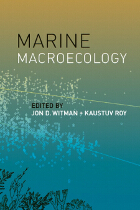 Marine Macroecology
Edited by Jon D. Witman and Kaustuv Roy
University of Chicago Press, 2009 Pioneered in the late 1980s, the concept of macroecology—a framework for studying ecological communities with a focus on patterns and processes—revolutionized the field. Although this approach has been applied mainly to terrestrial ecosystems, there is increasing interest in quantifying macroecological patterns in the sea and understanding the processes that generate them. Taking stock of the current work in the field and advocating a research agenda for the decades ahead, Marine Macroecology draws together insights and approaches from a diverse group of scientists to show how marine ecology can benefit from the adoption of macroecological approaches.
Divided into three parts, Marine Macroecology first provides an overview of marine diversity patterns and offers case studies of specific habitats and taxonomic groups. In the second part, contributors focus on process-based explanations for marine ecological patterns. The third part presents new approaches to understanding processes driving the macroecolgical patterns in the sea. Uniting unique insights from different perspectives with the common goal of identifying and understanding large-scale biodiversity patterns, Marine Macroecology will inspire the next wave of marine ecologists to approach their research from a macroecological perspective.
 Marine Reserves: A Guide to Science, Design, and Use
Jack Sobel and Craig Dahlgren; Center for Marine Conservation
Island Press, 2003 Conventional fishery management practices have failed to prevent the collapse of numerous fish stocks around the world. Amid growing concern about our ability to protect marine biodiversity and ecosystem integrity, scientists and managers alike are seeking alternative management tools. One of the most promising of those is no-take marine reserves -- areas of the sea where all consumptive use of natural resources is prohibited. Marine Reserves is the first guidebook on no-take marine reserves, providing a synthesis of information on the underlying science, as well as design and implementation issues. The book, by Jack Sobel and Craig Dahlgren, describes the need for marine reserves and their potential benefits, examines how reserves can be designed to achieve specific objectives, and considers gaps in our knowledge and the research needed to address those gaps. Chapters examine: marine biological and geophysical issues relevant to reserve design; potential economic and biological benefits of marine reserves, and the likelihood of achieving them; influence of social and economic factors on reserve design and implementation; lessons learned from past efforts to establish marine reserves. Also included are three case studies from California, Belize, and the Bahamas, as well as a review of experiences globally across a broad range of geographical locations, socioeconomic conditions, and marine environments. Case studies provide background on the history of marine reserves in each location, the process by which reserves were created, and the effect of the reserves on marine populations and communities as well as on human communities. Marine Reserves represents an invaluable guide for fishery managers and marine protected area managers in creating and implementing effective marine reserves, and an accessible reference for environmentalists and others concerned with the conservation of marine resources. It will also be useful in undergraduate and graduate courses in marine ecology, fisheries, marine policy, and related fields.
Marine Resource Economics, volume 38 number 1 (January 2023)
The University of Chicago Press
University of Chicago Press Journals, 2023 This is volume 38 issue 1 of Marine Resource Economics. Marine Resource Economics (MRE) publishes creative and scholarly economic analyses of a range of issues related to natural resource use in the global marine environment. The scope of the journal includes conceptual and empirical investigations aimed at addressing real-world ocean and coastal policy problems. MRE is an outlet for early results and imaginative new thinking on emerging topics in the marine environment, as well as rigorous theoretical and empirical analyses of questions that have long interested economists who study the oceans. A pluralistic forum for researchers and policy makers, MRE encourages challenges to conventional paradigms and perspectives. The journal is comprised of five sections: Articles, Perspectives, Case Studies, Systematic Reviews, and Book Reviews.
Marine Resource Economics, volume 38 number 2 (April 2023)
The University of Chicago Press
University of Chicago Press Journals, 2023 This is volume 38 issue 2 of Marine Resource Economics. Marine Resource Economics (MRE) publishes creative and scholarly economic analyses of a range of issues related to natural resource use in the global marine environment. The scope of the journal includes conceptual and empirical investigations aimed at addressing real-world ocean and coastal policy problems. MRE is an outlet for early results and imaginative new thinking on emerging topics in the marine environment, as well as rigorous theoretical and empirical analyses of questions that have long interested economists who study the oceans. A pluralistic forum for researchers and policy makers, MRE encourages challenges to conventional paradigms and perspectives. The journal is comprised of five sections: Articles, Perspectives, Case Studies, Systematic Reviews, and Book Reviews.
Marine Resource Economics, volume 38 number 3 (July 2023)
The University of Chicago Press
University of Chicago Press Journals, 2023 This is volume 38 issue 3 of Marine Resource Economics. Marine Resource Economics (MRE) publishes creative and scholarly economic analyses of a range of issues related to natural resource use in the global marine environment. The scope of the journal includes conceptual and empirical investigations aimed at addressing real-world ocean and coastal policy problems. MRE is an outlet for early results and imaginative new thinking on emerging topics in the marine environment, as well as rigorous theoretical and empirical analyses of questions that have long interested economists who study the oceans. A pluralistic forum for researchers and policy makers, MRE encourages challenges to conventional paradigms and perspectives. The journal is comprised of five sections: Articles, Perspectives, Case Studies, Systematic Reviews, and Book Reviews.
Marine Resource Economics, volume 38 number 4 (October 2023)
The University of Chicago Press
University of Chicago Press Journals, 2023 This is volume 38 issue 4 of Marine Resource Economics. Marine Resource Economics (MRE) publishes creative and scholarly economic analyses of a range of issues related to natural resource use in the global marine environment. The scope of the journal includes conceptual and empirical investigations aimed at addressing real-world ocean and coastal policy problems. MRE is an outlet for early results and imaginative new thinking on emerging topics in the marine environment, as well as rigorous theoretical and empirical analyses of questions that have long interested economists who study the oceans. A pluralistic forum for researchers and policy makers, MRE encourages challenges to conventional paradigms and perspectives. The journal is comprised of five sections: Articles, Perspectives, Case Studies, Systematic Reviews, and Book Reviews.
Marine Resource Economics, volume 39 number 1 (January 2024)
The University of Chicago Press
University of Chicago Press Journals, 2024 This is volume 39 issue 1 of Marine Resource Economics. Marine Resource Economics (MRE) publishes creative and scholarly economic analyses of a range of issues related to natural resource use in the global marine environment. The scope of the journal includes conceptual and empirical investigations aimed at addressing real-world ocean and coastal policy problems. MRE is an outlet for early results and imaginative new thinking on emerging topics in the marine environment, as well as rigorous theoretical and empirical analyses of questions that have long interested economists who study the oceans. A pluralistic forum for researchers and policy makers, MRE encourages challenges to conventional paradigms and perspectives. The journal is comprised of five sections: Articles, Perspectives, Case Studies, Systematic Reviews, and Book Reviews.
Marine Resource Economics, volume 39 number 2 (April 2024)
The University of Chicago Press
University of Chicago Press Journals, 2024 This is volume 39 issue 2 of Marine Resource Economics. Marine Resource Economics (MRE) publishes creative and scholarly economic analyses of a range of issues related to natural resource use in the global marine environment. The scope of the journal includes conceptual and empirical investigations aimed at addressing real-world ocean and coastal policy problems. MRE is an outlet for early results and imaginative new thinking on emerging topics in the marine environment, as well as rigorous theoretical and empirical analyses of questions that have long interested economists who study the oceans. A pluralistic forum for researchers and policy makers, MRE encourages challenges to conventional paradigms and perspectives. The journal is comprised of five sections: Articles, Perspectives, Case Studies, Systematic Reviews, and Book Reviews.
Marine Resource Economics, volume 39 number 3 (July 2024)
The University of Chicago Press
University of Chicago Press Journals, 2024 This is volume 39 issue 3 of Marine Resource Economics. Marine Resource Economics (MRE) publishes creative and scholarly economic analyses of a range of issues related to natural resource use in the global marine environment. The scope of the journal includes conceptual and empirical investigations aimed at addressing real-world ocean and coastal policy problems. MRE is an outlet for early results and imaginative new thinking on emerging topics in the marine environment, as well as rigorous theoretical and empirical analyses of questions that have long interested economists who study the oceans. A pluralistic forum for researchers and policy makers, MRE encourages challenges to conventional paradigms and perspectives. The journal is comprised of five sections: Articles, Perspectives, Case Studies, Systematic Reviews, and Book Reviews.
Marine Resource Economics, volume 39 number 4 (October 2024)
The University of Chicago Press
University of Chicago Press Journals, 2024 This is volume 39 issue 4 of Marine Resource Economics. Marine Resource Economics (MRE) publishes creative and scholarly economic analyses of a range of issues related to natural resource use in the global marine environment. The scope of the journal includes conceptual and empirical investigations aimed at addressing real-world ocean and coastal policy problems. MRE is an outlet for early results and imaginative new thinking on emerging topics in the marine environment, as well as rigorous theoretical and empirical analyses of questions that have long interested economists who study the oceans. A pluralistic forum for researchers and policy makers, MRE encourages challenges to conventional paradigms and perspectives. The journal is comprised of five sections: Articles, Perspectives, Case Studies, Systematic Reviews, and Book Reviews.
Marine Resource Economics, volume 40 number 1 (January 2025)
The University of Chicago Press
University of Chicago Press Journals, 2025 This is volume 40 issue 1 of Marine Resource Economics. Marine Resource Economics (MRE) publishes creative and scholarly economic analyses of a range of issues related to natural resource use in the global marine environment. The scope of the journal includes conceptual and empirical investigations aimed at addressing real-world ocean and coastal policy problems. MRE is an outlet for early results and imaginative new thinking on emerging topics in the marine environment, as well as rigorous theoretical and empirical analyses of questions that have long interested economists who study the oceans. A pluralistic forum for researchers and policy makers, MRE encourages challenges to conventional paradigms and perspectives. The journal is comprised of five sections: Articles, Perspectives, Case Studies, Systematic Reviews, and Book Reviews.
Marine Resource Economics, volume 40 number 2 (April 2025)
The University of Chicago Press
University of Chicago Press Journals, 2025 This is volume 40 issue 2 of Marine Resource Economics. Marine Resource Economics (MRE) publishes creative and scholarly economic analyses of a range of issues related to natural resource use in the global marine environment. The scope of the journal includes conceptual and empirical investigations aimed at addressing real-world ocean and coastal policy problems. MRE is an outlet for early results and imaginative new thinking on emerging topics in the marine environment, as well as rigorous theoretical and empirical analyses of questions that have long interested economists who study the oceans. A pluralistic forum for researchers and policy makers, MRE encourages challenges to conventional paradigms and perspectives. The journal is comprised of five sections: Articles, Perspectives, Case Studies, Systematic Reviews, and Book Reviews.
Marine Resource Economics, volume 40 number 3 (July 2025)
The University of Chicago Press
University of Chicago Press Journals, 2025 This is volume 40 issue 3 of Marine Resource Economics. Marine Resource Economics (MRE) publishes creative and scholarly economic analyses of a range of issues related to natural resource use in the global marine environment. The scope of the journal includes conceptual and empirical investigations aimed at addressing real-world ocean and coastal policy problems. MRE is an outlet for early results and imaginative new thinking on emerging topics in the marine environment, as well as rigorous theoretical and empirical analyses of questions that have long interested economists who study the oceans. A pluralistic forum for researchers and policy makers, MRE encourages challenges to conventional paradigms and perspectives. The journal is comprised of five sections: Articles, Perspectives, Case Studies, Systematic Reviews, and Book Reviews.
Marine Resource Economics, volume 40 number 4 (October 2025)
The University of Chicago Press
University of Chicago Press Journals, 2025 This is volume 40 issue 4 of Marine Resource Economics. Marine Resource Economics (MRE) publishes creative and scholarly economic analyses of a range of issues related to natural resource use in the global marine environment. The scope of the journal includes conceptual and empirical investigations aimed at addressing real-world ocean and coastal policy problems. MRE is an outlet for early results and imaginative new thinking on emerging topics in the marine environment, as well as rigorous theoretical and empirical analyses of questions that have long interested economists who study the oceans. A pluralistic forum for researchers and policy makers, MRE encourages challenges to conventional paradigms and perspectives. The journal is comprised of five sections: Articles, Perspectives, Case Studies, Systematic Reviews, and Book Reviews.
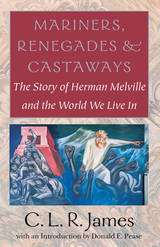 Mariners, Renegades and Castaways: The Story of Herman Melville and the World We Live In
C. L. R. James
Dartmouth College Press, 2001 Political theorist and cultural critic, novelist and cricket enthusiast, C. L. R. James (1901 - 1989) was a brilliant polymath who has been described by Edward Said as "a centrally important 20th-century figure." Through such landmark works as The Black Jacobins, Beyond a Boundary, and American Civilization, James's thought continues to influence and inspire scholars in a wide variety of fields. "There is little doubt," wrote novelist Caryl Phillips in The New Republic, "that James will come to be regarded as the outstanding Caribbean mind of the twentieth century." In his seminal work of literary and cultural criticism, Mariners, Renegades and Castaways, James anticipated many of the concerns and ideas that have shaped the contemporary fields of American and Postcolonial Studies, yet this widely influential book has been unavailable in its complete form since its original publication in 1953. A provocative study of Moby Dick in which James challenged the prevailing Americanist interpretation that opposed a "totalitarian" Ahab and a "democratic, American" Ishmael, he offered instead a vision of a factory-like Pequod whose "captain of industry" leads the "mariners, renegades and castaways" of its crew to their doom. In addition to demonstrating how such an interpretation supported the emerging US national security state, James also related the narrative of Moby Dick, and its resonance in American literary and political culture, to his own persecuted position at the height (or the depth) of the Truman/McCarthy era. It is precisely this personal, deeply original material that was excised from the only subsequent edition. With a new introduction by Donald E. Pease that places the work in its critical and cultural context, Mariners, Renegades and Castaways is once again available in its complete form.
 Mariners, Renegades and Castaways: The Story of Herman Melville and the World We Live In
C. L. R. James
Brandeis University Press, 2025 A new edition of a major work of literary and cultural criticism restores C. L. R. James’s reflections about Moby Dick and political persecution.
Political theorist and cultural critic, novelist, and cricket enthusiast, C. L. R. James (1901–89) was a brilliant polymath who was described by Edward Said as “a centrally important twentieth-century figure.” Through such landmark works as The Black Jacobins, Beyond a Boundary, and American Civilization, James’s thought continues to influence and inspire scholars in a variety of fields.
In this complete edition of his seminal work of literary and cultural criticism, Mariners, Renegades, and Castaways, James anticipated many of the concerns and ideas that have shaped the contemporary fields of American and postcolonial studies. In this provocative study of Moby Dick in which he challenged the prevailing Americanist interpretation that opposed a “totalitarian” Ahab and a “democratic, American” Ishmael, James offers instead a vision of a factory-like Pequod whose “captain of industry” leads the crew to their doom. In addition to demonstrating how such an interpretation supported the United States’ emerging national security state, he also related the narrative of Moby Dick to his own persecuted position at the height of McCarthyism. It is precisely this personal, deeply original material that was excised from the first edition of this book.
With a new foreword by Professor Chanda Prescod-Weinstein—theoretical physicist, advocate for a just science, and James’s granddaughter—and an introduction by Professor Donald E. Pease at Dartmouth College that places the work in its critical and cultural context, Mariners, Renegades, and Castaways is once again available in a new edition.
 The Marines, Counterinsurgency, and Strategic Culture: Lessons Learned and Lost in America's Wars
Jeannie L. Johnson. Foreword by Gen. Jim Mattis, US Marines (ret.)
Georgetown University Press The United States Marine Corps has a unique culture that ensures comradery, exacting standards, and readiness to be the first to every fight. Yet even in a group that is known for innovation, culture can push leaders to fall back on ingrained preferences. Jeannie L. Johnson takes a sympathetic but critical look at the Marine Corps's long experience with counterinsurgency warfare. Which counterinsurgency lessons have been learned and retained for next time and which have been abandoned to history is a story of battlefield trial and error—but also a story of cultural collisions. The book begins with a fascinating and penetrating look inside the culture of the Marine Corps through research in primary sources, including Marine oral histories, and interviews with Marines. Johnson explores what makes this branch of the military distinct: their identity, norms, values, and perceptual lens. She then traces the history of the Marines' counterinsurgency experience from the expeditionary missions of the early twentieth century, through the Vietnam War, and finally to the Iraq War. Her findings break new ground in strategic culture by introducing a methodology that was pioneered in the intelligence community to forecast behavior. Johnson shows that even a service as self-aware and dedicated to innovation as the Marine Corps is constrained in the lessons-learned process by its own internal predispositions, by the wider US military culture, and by national preferences. Her findings challenge the conclusions of previous counterinsurgency scholarship that ignores culture. This highly readable book reminds us of Sun Tzu's wisdom that to be successful in war, it is important to know thyself as well as the enemy. This is a must-read for anyone interested in the Marines Corps, counterinsurgency warfare, military innovation, or strategic culture.
 Mario Barradas and Son Jarocho: The Journey of a Mexican Regional Music
Yolanda Broyles-González, Rafael Figueroa Hernández, and Francisco González
University of Texas Press, 2022 Son Jarocho was born as the regional sound of Veracruz but over time became a Mexican national genre, even transnational, genre—a touchstone of Chicano identity in the United States. Mario Barradas and Son Jarocho traces a musical journey from the Gulf Coast to interior Mexico and across the border, describing the transformations of Son Jarocho along the way. This comprehensive cultural study pairs ethnographic and musicological insights with an oral history of the late Mario Barradas, one of Son Jarocho’s preeminent modern musicians. Chicano musician Francisco González offers an insider’s account of Barradas’s influence and Son Jarocho’s musical qualities, while Rafael Figueroa Hernández delves into Barradas’s recordings and films. Yolanda Broyles-González examines the interplay between Son Jarocho’s indigenous roots and contemporary role in Mexican and US society. The result is a nuanced portrait of a vital and evolving musical tradition.
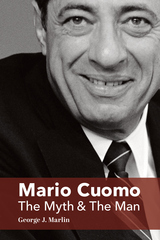 Mario Cuomo: The Myth and the Man
George J.
St. Augustine's Press, 2020 Among all the fifty-six men who have served as New York’s governor, none was more complicated, self-righteous, pugilistic, and exasperating than Mario Cuomo.
As governor, Mario Cuomo is remembered most for his advocacy of the “personally-opposed-but” position on abortion that led to confrontations with Catholic Church hierarchy, and for dithering about his presidential ambitions, that led the media to dub him the “Hamlet on the Hudson.” His political style reminded many of Machiavelli; Cuomo styled himself a successor to St. Thomas More.
In this political profile, George J. Marlin sets the record straight on Mario Cuomo.
Marlin traces Cuomo’s political rise and documents how and why he abandoned his public opposition to abortion to be elected New York’s chief executive.
In great detail, Marlin describes the protracted conflict between Cuomo and his church on abortion and refutes the governor’s claim that his “position on abortion is absolutely theologically sound.”
Marlin critiques Cuomo’s famous 1984 Democratic convention speech as nothing more than the usual high-toned partisan liberal bromides that offered little, if anything, that hadn’t been touted by his party for half a century.
The book also uncovers New York State’s fiscal, economic, and social decline during Cuomo’s 12 years as governor. It explains why voters repudiated Cuomo’s version of a welfare state when he sought a fourth term in 1994 and why, in the words of his son, Governor Andrew Cuomo, his father was “more accomplished as a speech-giver than as a governor.”
Marlin skillfully separates the Cuomo “Public Intellectual” myth from the political man.
Mario Cuomo, three times Governor of New York, an eloquent hard edged Catholic from Queens, dominated not only his home state but national liberal politics in the age of Reagan. Whether the subject was police or theology, Cuomo rhetorically overpowered the reporters who covered him. But he’s finally met his match in George Marlin’s Mario Cuomo The Myth and the Man. Marlin’s extraordinary equipment; a former candidate for Mayor of N.Y.C., former executive director of the New York and New Jersey Port Authority, author of books on Catholic voters and the Archbishops of New York, has made him the ideal author of what’s sure to be seen as the definitive political biography of Mario Cuomo. — Fred Siegel, Author, The Prince of the City: Giuliani, New York, and the Genius of American Life and The Future Once Happened Here: New York, D.C., L.A., and the Fate of America’s Big Cities.
“It’s easy to forget what an important and fascinating figure Mario Cuomo was during New York’s raucous political heyday of the 1970s, 80s and 90s, when the likes of Hugh Carey, Ed Koch, Al D’Amato, and Rudy Giuliani strode the political stage. Thankfully, George Marlin’s wonderful new Cuomo biography will help everyone remember both the good and bad of the remarkable man who served three terms as governor, turned down a seat on the Supreme Court and rejected the chance to run for President. Here are both Cuomo’s successes and failures — and of the latter there were many. An important work that helps restore our collective memory. — Fredric U. Dicker, the New York Post’s longtime state editor and a TV and radio commentator, covered six governors during 40 years at the state Capitol in Albany.
George Marlin is virtually peerless in blending high principle with knowledge of street-level politics and the nuts-and-bolts of otherwise mundane governance to produce readable, yet deeply insightful, social and political portraits. Mario Cuomo: The Myth and the Man, examines in fine detail one of one of New York state’s most consequential, if also deeply flawed, 20th-century gubernatorial incumbencies. Plus, readers get a bonus: Insight into what shaped the career of Mario Cuomo’s Democratic superstar son, Andrew. Marlin has been in the trenches himself and thus can separate blarney from beefsteak – which this fine volume once again demonstrates. —Bob McManus, Contributing Editor, The City Journal, was the New York Post’s Editorial Page Editor (2000-2013), and The Albany Times Union’s Executive City Editor (1975-1981).
“George Marlin not only captures the political life and journey of Mario Cuomo, but details his policy approach that led to the near demise of the Empire State. Fortunately, the Conservative Party of New York was there to carry the torch and provide the margin of victory for George Pataki ending the senior Cuomo’s reign.” —Michael Long, State Chairman, Conservative Party of New York (1988-2019)
“For both better and worse, Mario Cuomo was the quintessential American Catholic politician of an entire postwar generation: ambitious, brilliant, articulate, serious about his faith, and flexible in how and where he applied it. George Marlin is a writer of considerable skill, and he uses here it to produce a provocative, absorbing portrait of the man and his career. —Francis X. Maier, Senior Fellow in Catholic Studies at the Ethics and Public Policy Center
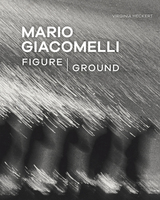 Mario Giacomelli: Figure/Ground
Virginia Heckert
J. Paul Getty Trust, The, 2021 A new look at the work of Mario Giacomelli, one of Italy’s foremost photographers of the twentieth century.
Mario Giacomelli (1925–2000) was born into poverty and lived his entire life in Senigallia, a seaside town along the Adriatic coast in Italy’s Marche region. He purchased his first camera in 1953 and quickly gained recognition for the raw expressiveness of his images. His preference for grainy, high-contrast film and paper produced bold, geometric compositions with glowing whites and deep blacks. Giacomelli most frequently focused his camera on the people, landscapes, and seascapes of the Marche, and he often spent several years expanding and reinterpreting a single body of work or repurposing an image made for one series for inclusion in another. By applying titles derived from poetry and literature to his photographs, he transformed ordinary subjects into meditations on time, memory, and existence.
Spanning the photographer’s earliest pictures to those made in the final years of his life, this publication celebrates the J. Paul Getty Museum’s extensive Giacomelli holdings, formed in large part through a significant gift from Daniel Greenberg and Susan Steinhauser.
This volume is published to accompany an exhibition on view at the J. Paul Getty Museum at the Getty Center from June 29 to October 10, 2021.
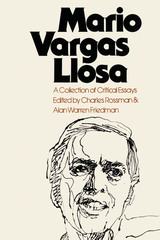 Mario Vargas Llosa: A Collection of Critical Essays
Edited by Charles Rossman and Alan Warren Friedman
University of Texas Press, 1978 The Peruvian Mario Vargas Llosa has been acclaimed throughout the literary world as one of Latin America's finest writers, yet until recently little has been written about his work in English. While his work has the subject of an increasing flow of critical commentary in Spanish and his major novels have been translated into English, this is the first full-scale critical treatment of Vargas Llosa published in the English language. These articles by a number of established writers and critics appraise Vargas Llosa's individual novels as well as the body of his work. The Time of the Hero, The Green House, Conversation in The Cathedral, and Pantaleón y las visitadoras are examined in order of publication, A second group of more general essays ranges across Vargas Llosa's work and explores pervasive themes and concerns. Two pieces by José Miguel Oviedo serve as a coda. In a bilingual interview, Oviedo and Vargas Llosa discuss Vargas Llosa's novel La tía Julia y el escribidor. Oviedo concludes with a critical discussion of that novel. A Vargas Llosa chronology compiled by the editors is also included. Most of these essays originally appeared in 1977 as a special issue of Texas Studies in Literature and Language. The concluding essay by Oviedo was prepared especially for this edition.
 Mario Vargas Llosa: A Life of Writing
By Raymond Leslie Williams
University of Texas Press, 2014 Awarded the Nobel Prize in 2010 at the age of seventy-four, Peruvian writer Mario Vargas Llosa has held pivotal roles in the evolution and revolutions of modern Latin American literature. Perhaps surprisingly, no complete history of Vargas Llosa’s works, placed in biographical and historical context, has been published—until now. A masterwork from one of America’s most revered scholars of Latin American fiction, Mario Vargas Llosa: A Life of Writing provides a critical overview of Vargas Llosa’s numerous novels while reinvigorating debates regarding conventional interpretations of the work. Weaving analysis with discussions of the writer’s political commentary, Raymond Leslie Williams traces the author’s youthful identity as a leftist student of the 1960s to a repudiation of some of his earlier ideas beginning in the 1980s. Providing a unique perspective on the complexity, nuance, and scope of Vargas Llosa’s lauded early novels and on his passionate support of indigenous populations in his homeland, Williams then turns his eye to the recent works, which serve as a bridge between the legacies of the Boom and the diverse array of contemporary Latin American fiction writers at work today. In addition, Williams provides a detailed description of Vargas Llosa’s traumatic childhood and its impact on him—seen particularly in his lifelong disdain for authority figures—as well as of the authors who influenced his approach, from Faulkner to Flaubert. Culminating in reflections drawn from Williams’s formal interviews and casual conversations with the author at key phases of both men’s careers, this is a landmark publication that will spark new lines of inquiry into an intricate body of work.
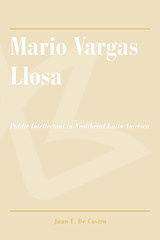 Mario Vargas Llosa: Public Intellectual in Neoliberal Latin America
Juan E. De Castro
University of Arizona Press, 2011 It would have been an ardent debate: Hugo Chávez, outspoken emblem of Latin American socialism, on one side and Mario Vargas Llosa, Peruvian novelist, polemical champion of the free market, and eventual winner of a Nobel Prize for literature, on the other. Unfortunately, it was not to be. For author Juan E. De Castro, what was most remarkable about the proposed debate was not only that it was going to happen in the first place but that Chávez called it off, a move that many chalked up to trepidation on the Venezuelan president’s part. Whatever the motivation, the cancellation served to affirm Vargas Llosa’s already substantial intellectual and political stature.
The idea of a sitting president debating a novelist may seem surprising to readers unfamiliar with Latin American politics, but Vargas Llosa has enjoyed considerable influence in the political arena, thanks in no small part to his run for the Peruvian presidency in 1990. Though he was awarded the Nobel Prize in 2010 for his literary achievements, he is as well known in the Spanish-speaking world for his political columns as he is for his novels. In his widely syndicated political pieces, Vargas Llosa asserts a position he calls “liberal” in the classical sense of affirming the importance of a free market and individual rights, though as De Castro argues, he has often aligned himself with groups that emphasize the former at the expense of the latter.
What makes Vargas Llosa’s rise to political prominence compelling is “not only that he is still a vibrantly active writer, but that he was at the time of the beginning of his rise to literary fame, and throughout the 1960s, a staunch defender of the Cuban Revolution.” While his early literary output seemed to proclaim an allegiance with the Left, Vargas Llosa was soon to take a right turn that De Castro argues was anticipatory and representative of the Latin American embrace of the free market in the 1990s. Understanding Vargas Llosa’s political thought is thus of more than biographical interest. It is a key to understanding the social and cultural shifts that have taken place not only in Peru but throughout Latin America.
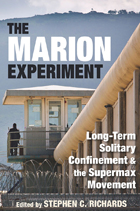 The Marion Experiment: Long-Term Solitary Confinement and the Supermax Movement
Edited by Stephen C. Richards
Southern Illinois University Press, 2015 Taking readers into the darkness of solitary confinement, this searing collection of convict experiences, academic research, and policy recommendations shines a light on the proliferation of supermax (super-maximum-security) prisons and the detrimental effects of long-term high-security confinement on prisoners and their families. Stephen C. Richards, an ex-convict who served time in nine federal prisons before earning his PhD in criminology, argues the supermax prison era began in 1983 at USP Marion in southern Illinois, where the first “control units” were built by the Federal Bureau of Prisons. The Marion Experiment, written from a convict criminology perspective, offers an introduction to long-term solitary confinement and supermax prisons, followed by a series of first-person accounts by prisoners—some of whom are scholars—previously or currently incarcerated in high-security facilities, including some of the roughest prisons in the western world. Scholars also address the widespread “Marionization” of solitary confinement; its impact on female, adolescent, and mentally ill prisoners and families; and international perspectives on imprisonment. As a bold step toward rethinking supermax prisons, Richards presents the most comprehensive view of the topic to date to raise awareness of the negative aspects of long-term solitary confinement and the need to reevaluate how prisoners are housed and treated.
 Marion Greenwood: Portrait and Self-Portrait—A Biography
Joanne B. Mulcahy
University of Alabama Press, 2025 This new biography reveals Marion Greenwood's central place in the pantheon of history’s remarkable women artists. Marion Greenwood: Portrait and Self-Portrait—A Biography brings to life a woman who blazed through the twentieth-century art world. Born in Brooklyn in 1909, Greenwood thrived at storied institutions and arts centers such as the Art Students League, the studio of German modernist Winold Reiss, the Woodstock Colony, and Yaddo. In 1933, she catapulted to international fame as the first woman to paint a public mural in Mexico. Diego Rivera celebrated Greenwood as one of “the world’s greatest living women mural painters.” She traveled the globe to create award-winning portraits of people from diverse backgrounds, crossing racial, cultural, and class lines to reflect her vision for a more just world. This biography, the first about Greenwood, is based on a decade of research and interviews. Author Joanne B. Mulcahy integrates the artist’s adventuresome personal life with her journey to artistic glory. Greenwood comes alive as a notable and spirited part of the heady art scenes of 1920s and 1930s Mexico, New York City, and Paris, and as one of two women artist-correspondents during World War II. After social realism and portraiture fell from favor, Greenwood doggedly stuck with what she called “the human thing” in art. Her freewheeling romantic life and independent spirit defied expectations for women, and she dismissed sexist critics who mixed acclaim for her work with commentary on her stunning beauty. A feminist pioneer, Greenwood made a living as an artist in a time when few women could. In following Greenwood’s maverick path and artistic achievements, this book reveals her central place in the pantheon of history’s remarkable women artists.
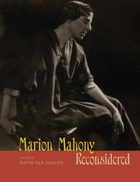 Marion Mahony Reconsidered
Edited by David Van Zanten
University of Chicago Press, 2011 Marion Mahony Griffin (1871–1961) was an American architect and artist, one of the first licensed female architects in the world, designer for Frank Lloyd Wright’s Chicago studio, and an original member of the Prairie School of architecture. Largely heralded for her exquisite presentation drawings for both Wright and her husband, Walter Burley Griffin, Mahony was an adventurous designer in her own right, whose independent and highly original work attracted attention at a moment when architectural drawing and graphic illustration were becoming integral to the design process. This book examines new research into Mahony’s life and paints a vivid portrait of a woman’s place among the lives and productions of some of our most noted American architects. The essays included take us on an ambitious journey from Mahony’s origins in the Chicago suburbs, through her years as Wright’s right-hand woman and her bohemian life with her husband in Australia—whose new capital city, Canberra, she helped to plan—up until her golden years in the middle of the twentieth century. Filled with richly detailed analyses of Mahony’s works and including and populated by an international cast of characters, Marion Mahony Reconsidered greatly expands our knowledge of this talented, complex, and enigmatic modern architect.
Marion Richardson: Her Life and Her Contribution to Handwriting
Rosemary Sassoon
Intellect Books, 2012 In Marion Richardson: Her Life and Contribution to Handwriting, Rosemary Sassoon looks at Richardson’s life and work through the artist and educator’s own writings as well as letters and personal recollections from those who knew and worked with her. The driving force behind a momentous shift in the way art is taught to children, Richardson is perhaps best known for her groundbreaking contribution to penmanship, devising two schemes based on her observations of the natural movements of young children’s hands. The result of extensive original archival research, this book includes many illustrations that depict Richardson’s inventive approach.
The Marion Thompson Wright Reader: Edited and with a Biographical Introduction by Graham Russell Gao Hodges
Graham Russell Gao Hodges
Rutgers University Press, 2022 In The Marion Thompson Wright Reader, acclaimed historian Graham Russell Hodges provides a scholarly, accessible introduction to a modern edition of Marion Thompson Wright’s classic book, The Education of Negroes in New Jersey and to her full body of scholarly work. First published in 1941 by Teachers College Press, Thompson’s landmark study has been out of print for decades. Such rarity understates the book’s importance. Thompson’s major book and her life are significant for the histories of New Jersey, African Americans, local and national, women’s and education history. Drawing upon Wright's work, existing scholarship, and new archival research, this new landmark scholarly edition, which includes an all-new biography of this pioneering scholar, underscores the continued relevance of Marion Thompson Wright.
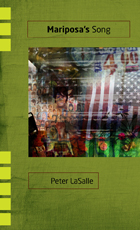 Mariposa's Song: A Novel
Peter LaSalle
Texas Tech University Press, 2012 Pretty, twenty-year-old Mariposa has entered the U.S. from Honduras by way of Nuevo Laredo, without documentation. She now serves drinks and woos customers as a B-girl—sort of a dime-a-dance arrangement—in a shabby nightclub on the east side of Austin, Texas. Rough work, it's at least giving her a start in America.Between the norteño and cumbia songs the DJ plays, a smooth-talking Anglo out-of-towner who calls himself Bill shows up at the club one Saturday night to sit and casually chat with Mariposa. He smiles and sympathizes; his flattery leads her to reveal the secret pain she has kept hidden so long. But Mariposa has no way of knowing that he's being hunted by police throughout the Southwest.Even in Austin, far from the border, there are dangers more sinister than narcotraficantes or la migra.LaSalle’s intense, haunting novel beckons readers into the shadowy lives of undocumented workers in the U.S. and the difficult choices they must face. Written as a single book-length sentence, Mariposa's Song is also a truly innovative achievement in the novel form itself, as it continually startles and satisfies with stylistic daring and sheer lyrical radiance.
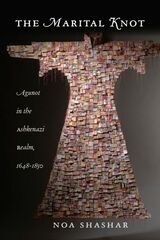 The Marital Knot: Agunot in the Ashkenazi Realm, 1648–1850
Noa Shashar
Brandeis University Press, 2024 A long overdue study of agunot based on exhaustive research in rabbinic sources, memoirs, and communal records.
Noa Shashar sheds light on Jewish family life in the early modern era and on the activity of rabbis whose Jewish legal rulings determined the fate of agunot, literally “chained women,” who were often considered a marginal group. Who were these men and women? How did Jewish society deal with the danger of a woman’s becoming an agunah? What kind of reality was imposed on women who found themselves agunot, and what could they do to extricate themselves from their plight? How did rabbinic decisors discharge their task during this period, and what were the outcomes given the fact that the agunot were dependent on the male rabbinic establishment?
This study describes the lives of agunot, and by reexamining the halakhic activity concerning agunot in this period, proposes a new assessment of the attitude that decisors displayed toward the freeing of agunot.
Maritime Autonomous Vehicles: Methods and measurements
Frank Ehlers
The Institution of Engineering and Technology, 2025 The maritime domain is of an enormous interest to our society, from the economy to health, and security. Operating in the maritime domain, on the other hand, is dangerous, expensive, and most of the time at low execution speed. Unmanned systems are in many ways suited to such environments, but the successful realisation of maritime autonomous vehicles requires an overarching design and development cycle, starting from design and modelling of unmanned systems, to control and implementation exhibiting a reliable and explainable level of autonomy and self-organization amidst the sudden and possibly extreme disturbances occurring in the uncertain and dynamic maritime environment.
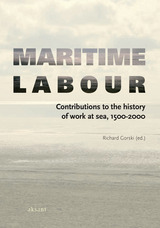 Maritime Labour: Contributions to the History of Work at Sea, 1500-2000
Edited by Richard Gorski
Amsterdam University Press, 2007 This is a collection of soundings into various aspects of the history of maritime labor from the close of the Middle Ages to the present. The spatial emphasis of the essays is north European and Atlantic since they deal with the countries around the North Sea and Baltic with some coverage of North America. The phrase work at sea naturally makes one think of merchant seafaring and its ancillary trades but, again, several authors in this book deal with navies and naval personnel as important constituents of the seagoing workforce. Indeed, from time to time the authors leave the sea behind in order to examine broader issues such as labor markets, the regulation and institutions of seafaring, and industrial relations on the waterfront. But at all points there is a common theme of sea-related labor, and a common objective of better understanding what have often been perceived as difficult and elusive groups of people. Marcus Rediker was surely correct in a recent essay to stress the challenge of producing more inclusive maritime historical research: We need to get back to basics, to careful empirical reconstructions of the lifeways of peoples long rendered silent in the writing of history.
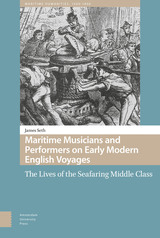 Maritime Musicians and Performers on Early Modern English Voyages: The Lives of the Seafaring Middle Class
James Seth
Amsterdam University Press, 2022 Maritime Musicians and Performers on Early Modern English Voyages aims to tell the full story of early English shipboard performers, who have been historically absent from conversations about English navigation, maritime culture, and economic expansion. Often described reductively in voyaging accounts as having one function, in fact maritime performers served many communicative tasks. Their lives were not only complex, but often contradictory. Though not high-ranking officers, neither were they lower-ranking mariners or sailors. They were influenced by a range of competing cultural practices, having spent time playing on both land and sea, and their roles required them to mediate parties using music, dance, and theatre as powerful forms of nonverbal communication. Their performances transcended and breached boundaries of language, rank, race, religion, and nationality, thereby upsetting conventional practices, improving shipboard and international relations, and ensuring the success of their voyages.
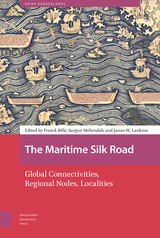 The Maritime Silk Road: Global Connectivities, Regional Nodes, Localities
Franck Billé
Amsterdam University Press, 2022 The Maritime Silk Road foregrounds the numerous networks that have been woven across oceanic geographies, tying world regions together often far more extensively than land-based routes. On the strength of the new data which has emerged in the last two decades in the form of archaeological findings, as well as new techniques such as GIS modelling, the authors collectively demonstrate the existence of a very early global maritime trade. From architecture to cuisine, and language to clothing, evidence points to early connections both within Asia and between Asia and other continents—well before European explorations of the Global South. The human stories presented here offer insights into both the extent and limits of this global exchange, showing how goods and people travelled vast distances, how they were embedded in regional networks, and how local cultures were shaped as a result.
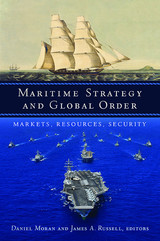 Maritime Strategy and Global Order: Markets, Resources, Security
Daniel Moran and James A. Russell, Editors
Georgetown University Press Taken for granted as the natural order of things, peace at sea is in fact an immense and recent achievement—but also an enormous strategic challenge if it is to be maintained in the future. In Maritime Strategy and Global Order, an international roster of top scholars offers historical perspectives and contemporary analysis to explore the role of naval power and maritime trade in creating the international system. The book begins in the early days of the industrial revolution with the foundational role of maritime strategy in building the British Empire. It continues into the era of naval disorder surrounding the two world wars, through the passing of the Pax Britannica and the rise of the Pax Americana, and then examines present-day regional security in hot spots like the South China Sea and Arctic Ocean. Additional chapters engage with important related topics such as maritime law, resource competition, warship evolution since the end of the Cold War, and naval intelligence. A first-of-its-kind collection, Maritime Strategy and Global Order offers scholars, practitioners, students, and others with an interest in maritime history and strategic issues an absorbing long view of the role of the sea in creating the world we know.
Maritime Surveillance with Synthetic Aperture Radar
Gerardo Di Martino
The Institution of Engineering and Technology, 2021 This book covers the use of SAR for maritime surveillance applications. It provides a comprehensive source of material on the subject, divided into two parts. The first part deals with models and techniques, while the second part is devoted to maritime surveillance applications. Each chapter covers the basic principles, a critical review of the current technology, techniques and applications, and the latest developments in the field.
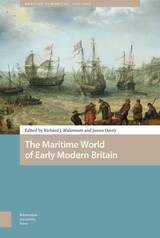 The Maritime World of Early Modern Britain
Richard Blakemore
Amsterdam University Press, 2020 Britain's emergence as one of Europe's major maritime powers has all too frequently been subsumed by nationalistic narratives that focus on operations and technology. This volume, by contrast, offers a daring new take on Britain's maritime past. It brings together scholars from a range of disciplines to explore the manifold ways in which the sea shaped British history, demonstrating the number of approaches that now have a stake in defining the discipline of maritime history. The chapters analyse the economic, social, and cultural contexts in which English maritime endeavour existed, as well as discussing representations of the sea. The contributors show how people from across the British Isles increasingly engaged with the maritime world, whether through their own lived experiences or through material culture. The volume also includes essays that investigate encounters between English voyagers and indigenous peoples in Africa, and the intellectual foundations of imperial ambition.
The Maritime World of the Anglo-Saxons
Stacy S. Klein
Arizona Center for Medieval and Renaissance Studies, 2014 The twenty-first century has been marked by an “oceanic turn” and by groundbreaking new research on the previously hidden depths of maritime life, literature, and culture. The Maritime World of the Anglo-Saxons builds upon these new areas of research as the first major volume of essays to explore Anglo-Saxon England’s complex relationship to its maritime history, economy, and sensibilities. Individual essays focus on maritime travel, Viking invasions by sea, littoral culture, the archeology of the whale, and literary mythologies of monstrous sea creatures, bringing together insights from a range of disciplines: archeology, history, literature, paleography, linguistics, art history, critical theory, geography, and cultural studies.
 Mariupol 2013-2022: Stories of Mobilization and Resistance
Hana Josticova
Central European University Press, 2024 The chapters in this book represent successive phases of one story – that of Mariupol, formerly Ukraine’s tenth largest city, and the second largest in the Donbas region. The author, a young Slovak academic, conducted her ethnographic fieldwork in this coastal town between November 2018 and August 2021. She was one of the last academics to do research in Mariupol before its invasion and eventual occupation by Russia. During these years, Hana Jošticová was overwhelmed by acts of mobilization and resistance that went in opposite directions: support for a Western direction of Ukraine’s future, and support for the status quo that the victory of the Euromaidan seemed to threaten. She noted the sequence of events presented in the media and through the lens of individual frames and narratives. Her book is a collection and interpretation of memories and testimonies from both sides: those who actively resisted Russian influence; and those who sparked their own revolution, the ‘Russian Spring.’ Her focus is on self-mobilized individuals who resorted to action outside of established organizational structures spontaneously, autonomously, without resources and guarantees of safety. Her evidence indicates that popular support for the Russian Spring had less to do with Russia than with the social, economic, or cultural characteristics of the Donetsk region. Years of immersive research convinced the author that individuals are as important as masses, ideas are as powerful as material resources, and beliefs and emotions are as critical as weapons.
Mark, Mutuality, and Mental Health: Encounters with Jesus
Simon Mainwaring
SBL Press, 2014 An incitement to re-assess how society relates to persons with poor mental health
Mainwaring explores the societal contexts of those who suffer poor mental health, and in particular the relational dynamics of how identity, agency, and dialogue are negotiated in personal encounters. This work seeks to serve as an experiment, such that interested readers might better understand the dynamics of relational power that pervade encounters with persons with poor mental health.
Features:
- Foucauldian analysis of the relational dynamics of poor mental health used to re-imagine hegemonic relational dynamics
- Close readings of encounters between individual characters to evaluate how mutuality operates in those encounters
- Study of mutuality as it has emerged in mental health literature, feminist theologies, and theologies of disability
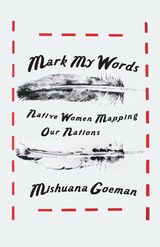 Mark My Words: Native Women Mapping Our Nations
Mishuana Goeman
University of Minnesota Press, 2013
Dominant history would have us believe that colonialism belongs to a previous era that has long come to an end. But as Native people become mobile, reservation lands become overcrowded and the state seeks to enforce means of containment, closing its borders to incoming, often indigenous, immigrants.
In Mark My Words, Mishuana Goeman traces settler colonialism as an enduring form of gendered spatial violence, demonstrating how it persists in the contemporary context of neoliberal globalization. The book argues that it is vital to refocus the efforts of Native nations beyond replicating settler models of territory, jurisdiction, and race. Through an examination of twentieth-century Native women’s poetry and prose, Goeman illuminates how these works can serve to remap settler geographies and center Native knowledges. She positions Native women as pivotal to how our nations, both tribal and nontribal, have been imagined and mapped, and how these women play an ongoing role in decolonization. In a strong and lucid voice, Goeman provides close readings of literary texts, including those of E. Pauline Johnson, Esther Belin, Joy Harjo, Leslie Marmon Silko, and Heid Erdrich. In addition, she places these works in the framework of U.S. and Canadian Indian law and policy. Her charting of women’s struggles to define themselves and their communities reveals the significant power in all of our stories.
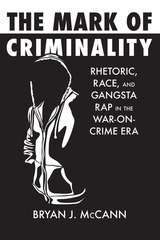 The Mark of Criminality: Rhetoric, Race, and Gangsta Rap in the War-on-Crime Era
Bryan J. McCann
University of Alabama Press, 2017 Illustrates the ways that the “war on crime” became conjoined—aesthetically, politically, and rhetorically—with the emergence of gangsta rap as a lucrative and deeply controversial subgenre of hip-hop
In The Mark of Criminality: Rhetoric, Race, and Gangsta Rap in the War-on-Crime Era, Bryan J. McCann argues that gangsta rap should be viewed as more than a damaging reinforcement of an era’s worst racial stereotypes. Rather, he positions the works of key gangsta rap artists, as well as the controversies their work produced, squarely within the law-and-order politics and popular culture of the 1980s and 1990s to reveal a profoundly complex period in American history when the meanings of crime and criminality were incredibly unstable.
At the center of this era—when politicians sought to prove their “tough-on-crime” credentials—was the mark of criminality, a set of discourses that labeled members of predominantly poor, urban, and minority communities as threats to the social order. Through their use of the mark of criminality, public figures implemented extremely harsh penal polices that have helped make the United States the world’s leading jailer of its adult population.
At the same time when politicians like Ronald Reagan, George H. W. Bush, and Bill Clinton and television shows such as COPS and America’s Most Wanted perpetuated images of gang and drug-filled ghettos, gangsta rap burst out of the hip-hop nation, emanating mainly from the predominantly black neighborhoods of South Central Los Angeles. Groups like NWA and solo artists (including Dr. Dre, Snoop Dogg, and Tupac Shakur) became millionaires by marketing the very discourses political and cultural leaders used to justify their war on crime. For these artists, the mark of criminality was a source of power, credibility, and revenue. By understanding gangsta rap as a potent, if deeply imperfect, enactment of the mark of criminality, we can better understand how crime is always a site of struggle over meaning. Furthermore, by underscoring the nimble rhetorical character of criminality, we can learn lessons that may inform efforts to challenge our nation’s failed policies of mass incarceration.
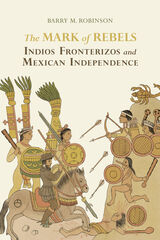 The Mark of Rebels: Indios Fronterizos and Mexican Independence
Barry M. Robinson
University of Alabama Press, 2016 Explores social and cultural transformations among the indigenous communities of western Mexico, especially the indios fronterizos (Frontier Indians), preceding and during the struggle for independence
In The Mark of Rebels Barry Robinson offers a new look at Mexican Independence from the perspective of an indigenous population caught in the heart of the struggle. During the conquest and settlement of Mexico’s Western Sierra Madre, Spain’s indigenous allies constructed an indio fronterizo identity for their ethnically diverse descendants. These communities used their special status to maintain a measure of autonomy during the colonial era, but the cultural shifts of the late colonial period radically transformed the relationship between these indios fronterizos and their neighbors.
Marshalling an extensive array of archival material from Mexico, the United States, and Spain, Robinson shows that indio fronterizo participation in the Mexican wars of independence grafted into the larger Hidalgo Revolt through alignment with creole commanders. Still, a considerable gulf existed between the aims of indigenous rebels and the creole leadership. Consequently, the privileges that the indios fronterizos sought to preserve continued to diminish, unable to survive either the late colonial reforms of the Spanish regime or creole conceptions of race and property in the formation of the new nation-state.
This story suggests that Mexico’s transition from colony to nation can only be understood by revisiting the origins of the colonial system and by recognizing the role of Spain’s indigenous allies in both its construction and demolition. The study relates events in the region to broader patterns of identity, loyalty, and subversion throughout the Americas, providing insight into the process of mestizaje that is commonly understood to have shaped Latin America. It also foreshadows the popular conservatism of the nineteenth century and identifies the roots of post-colonial social unrest.
This book provides new context for scholars, historians, ethnographers, anthropologists, and anyone interested in the history of Mexico, colonization, Native Americans, and the Age of Revolutions.
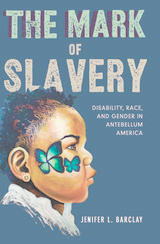 The Mark of Slavery: Disability, Race, and Gender in Antebellum America
Jenifer L. Barclay
University of Illinois Press, 2021 Exploring the disability history of slavery Time and again, antebellum Americans justified slavery and white supremacy by linking blackness to disability, defectiveness, and dependency. Jenifer L. Barclay examines the ubiquitous narratives that depicted black people with disabilities as pitiable, monstrous, or comical, narratives used not only to defend slavery but argue against it. As she shows, this relationship between ableism and racism impacted racial identities during the antebellum period and played an overlooked role in shaping American history afterward. Barclay also illuminates the everyday lives of the ten percent of enslaved people who lived with disabilities. Devalued by slaveholders as unsound and therefore worthless, these individuals nonetheless carved out an unusual autonomy. Their roles as caregivers, healers, and keepers of memory made them esteemed within their own communities and celebrated figures in song and folklore. Prescient in its analysis and rich in detail, The Mark of Slavery is a powerful addition to the intertwined histories of disability, slavery, and race.
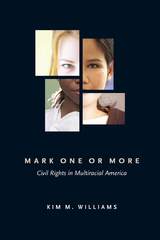 Mark One or More: Civil Rights in Multiracial America
Kim M. Williams
University of Michigan Press, 2010 Mark One or More tells the little-known story of the struggle to include a multiracial category on the U.S. census, and the profound changes it wrought in the American political landscape.
The movement to add a multiracial category to the 2000 U.S. Census provoked unprecedented debates about race. The effort made for strange bedfellows. Republicans like House Speaker Newt Gingrich and affirmative action opponent Ward Connerly took up the multiracial cause. Civil rights leaders opposed the movement on the premise that it had the potential to dilute the census count of traditional minority groups. The activists themselves—a loose confederation of organizations, many led by the white mothers of interracial children—wanted recognition. What they got was the transformation of racial politics in America.
Mark One or More is the compelling account of how this small movement sparked a big change, and a moving call to reassess the meaning of racial identity in American life.
Kim M. Williams is Associate Professor of Public Policy in Harvard's Kennedy School of Government, and an expert in racial and ethnic politics and political movements.
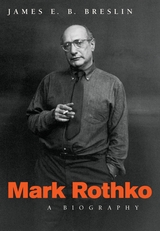 Mark Rothko: A Biography
James E. B. Breslin
University of Chicago Press, 2012 The definitive biography of one of the most-loved artists of the twentieth century, a book the New York Times called "the best life of an American painter yet written"
A book of heroic dimensions, this is the first full-length biography of one of the greatest artists of the twentieth century—a man as fascinating, difficult, and compelling as the paintings he produced. Drawing on exclusive access to Mark Rothko's personal papers and over one hundred interviews with artists, patrons, and dealers, James Breslin tells the story of a life in art—the personal costs and professional triumphs, the convergence of genius and ego, the clash of culture and commerce. Breslin offers us not only an enticing look at Rothko as a person, but delivers a lush, in-depth portrait of the New York art scene of the 1930s, ’40s, and ’50s—the world of Abstract Expressionism, of Pollock, Rothko, de Kooning, and Klein, which would influence artists for generations to come.
Mark Twain & France: The Making of a New American Identity
Paula Harrington and Ronald Jenn
University of Missouri Press, 2017 Blending cultural history, biography, and literary criticism, this book explores how one of America's greatest icons used the French to help build a new sense of what it is to be “American” in the second half of the nineteenth century.
While critics have generally dismissed Mark Twain’s relationship with France as hostile, Harrington and Jenn see Twain’s use of the French as a foil to help construct his identity as “the representative American.” Examining new materials that detail his Montmatre study, the carte de visite album, and a chronology of his visits to France, the book offers close readings of writings that have been largely ignored, such as The Innocents Adrift manuscript and the unpublished chapters of A Tramp Abroad, combining literary analysis, socio-historical context and biographical research.
Mark Twain, American Humorist
Tracy Wuster
University of Missouri Press, 2019 Mark Twain, American Humorist examines the ways that Mark Twain’s reputation developed at home and abroad in the period between 1865 and 1882, years in which he went from a regional humorist to national and international fame. In the late 1860s, Mark Twain became the exemplar of a school of humor that was thought to be uniquely American. As he moved into more respectable venues in the 1870s, especially through the promotion of William Dean Howells in the Atlantic Monthly, Mark Twain muddied the hierarchical distinctions between class-appropriate leisure and burgeoning forms of mass entertainment, between uplifting humor and debased laughter, and between the literature of high culture and the passing whim of the merely popular.
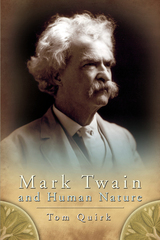 Mark Twain and Human Nature
Tom Quirk
University of Missouri Press, 2007 Mark Twain once claimed that he could read human character as well as he could read the Mississippi River, and he studied his fellow humans with the same devoted attention. In both his fiction and his nonfiction, he was disposed to dramatize how the human creature acts in a given environment—and to understand why. Now one of America’s preeminent Twain scholars takes a closer look at this icon’s abiding interest in his fellow creatures. In seeking to account for how Twain might have reasonably believed the things he said he believed, Tom Quirk has interwoven the author’s inner life with his writings to produce a meditation on how Twain’s understanding of human nature evolved and deepened, and to show that this was one of the central preoccupations of his life. Quirk charts the ways in which this humorist and occasional philosopher contemplated the subject of human nature from early adulthood until the end of his life, revealing how his outlook changed over the years. His travels, his readings in history and science, his political and social commitments, and his own pragmatic testing of human nature in his writing contributed to Twain’s mature view of his kind. Quirk establishes the social and scientific contexts that clarify Twain’s thinking, and he considers not only Twain’s stated intentions about his purposes in his published works but also his ad hoc remarks about the human condition. Viewing both major and minor works through the lens of Twain’s shifting attitude, Quirk provides refreshing new perspectives on the master’s oeuvre. He offers a detailed look at the travel writings, including The Innocents Abroad and Following the Equator, and the novels, including The Adventures of Tom Sawyer, Adventures of Huckleberry Finn, and Pudd’nhead Wilson, as well as an important review of works from Twain’s last decade, including fantasies centering on man’s insignificance in Creation, works preoccupied with isolation—notably No. 44,The Mysterious Stranger and “Eve’s Diary”—and polemical writings such as What Is Man? Comprising the well-seasoned reflections of a mature scholar, this persuasive and eminently readable study comes to terms with the life-shaping ideas and attitudes of one of America’s best-loved writers. Mark Twain and Human Nature offers readers a better understanding of Twain’s intellect as it enriches our understanding of his craft and his ineluctable humor.
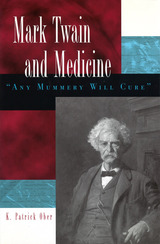 Mark Twain and Medicine: "Any Mummery Will Cure"
K. Patrick Ober
University of Missouri Press, 2003 Mark Twain has always been America’s spokesman, and his comments on a wide range of topics continue to be accurate, valid, and frequently amusing. His opinions on the medical field are no exception. While Twain’s works, including his popular novels about Tom Sawyer and Huckleberry Finn, are rich in medical imagery and medical themes derived from his personal experiences, his interactions with the medical profession and his comments about health, illness, and physicians have largely been overlooked. In Mark Twain and Medicine, K. Patrick Ober remedies this omission. The nineteenth century was a critical time in the development of American medicine, with much competition among the different systems of health care, both traditional and alternative. Not surprisingly, Mark Twain was right in the middle of it all. He experimented with many of the alternative care systems that were available in his day—in part because of his frustration with traditional medicine and in part because he hoped to find the “perfect” system that would bring health to his family. Twain’s commentary provides a unique perspective on American medicine and the revolution in medical systems that he experienced firsthand. Ober explores Twain’s personal perspective in this area, as he expressed it in fiction, speeches, and letters. As a medical educator, Ober explains in sufficient detail and with clarity all medical and scientific terms, making this volume accessible to the general reader. Ober demonstrates that many of Twain’s observations are still relevant to today’s health care issues, including the use of alternative or complementary medicine in dealing with illness, the utility of placebo therapies, and the role of hope in the healing process. Twain’s evaluation of the medical practices of his era provides a fresh, humanistic, and personalized view of the dramatic changes that occurred in medicine through the nineteenth century and into the first decade of the twentieth. Twain scholars, general readers, and medical professionals will all find this unique look at his work appealing.
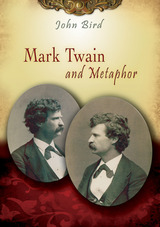 Mark Twain and Metaphor
John Bird
University of Missouri Press, 2007 Metaphor theory, observes John Bird, is like Mark Twain: both seem simple upon first introduction. Now, in the most complete study to date of Twain’s use of figurative language, a veteran Twain scholar tackles the core of his writing and explores it with theoretical approaches that have rarely been applied to Twain, providing new insights into how he imagined his world—and the singular ways in which he expressed himself. From “The Jumping Frog” to the late dream narratives, Bird considers Twain’s metaphoric construction over his complete career and especially sheds new light on his central texts: Roughing It; The Adventures of Tom Sawyer; Adventures of Huckleberry Finn; A Connecticut Yankee in King Arthur’s Court; Pudd’nhead Wilson; and No. 44,The Mysterious Stranger. He reconsiders “Old Times on the Mississippi” as the most purely metaphorical of Twain’s writings, goes on to look at how Twain used metaphor and talked about it in a variety of works and genres, and even argues that Clemens’s pseudonym is not so much an alter ego as a metaphorized self. By offering insight into how Twain handled figurative language during the composing process, Bird reveals not only hidden facets of his artistry but also new aspects of works that we think we know well—including some entirely new ideas regarding Huck Finn that draw on the recent discovery of the first half of the manuscript. In addition to dealing with issues currently central to Twain studies, such as race and gender, he also links metaphor to humor and dream theory to further illuminate topics central to his work. More than a study of Twain’s language, the book delves into the psychological aspects of metaphor to reveal the writer’s attitudes and thoughts, showing how using metaphor as a guide to Twain reveals much about his composition process. Applying the insights of metaphor theorists such as Roman Jakobson and Colin M. Turbayne, Bird offers readers not only new insights into Twain but also an introduction to this interdisciplinary field. In lively prose, Mark Twain and Metaphor provides a vital way to read Twain’s entire corpus, allowing readers to better appreciate his style, humor, and obsession with dreams. It opens new ground and makes old ground fresh again, offering ways to see and resee this essential American writer.
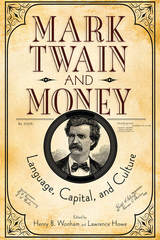 Mark Twain and Money: Language, Capital, and Culture
Edited by Henry B. Wonham and Lawrence Howe
University of Alabama Press, 2017 This groundbreaking volume explores the importance of economics and prosperity throughout Samuel Clemens’s writing and personal life.
Mark Twain and Money: Language, Capital, and Culture focuses on an overlooked feature of the story of one of America’s most celebrated writers. Investigating Samuel Clemens’s often conflicting but insightful views on the roles of money in American culture and identity, this collection of essays shows how his fascination with the complexity of nineteenth-century economics informs much of Mark Twain’s writing.
While most readers are familiar with Mark Twain the worldly wise writer, fewer are acquainted with Samuel Clemens the avid businessman. Throughout his life, he sought to strike it rich, whether mining for silver in Nevada, founding his own publishing company, or staking out ownership in the Paige typesetting machine. He was ever on the lookout for investment schemes and was intrigued by inventions, his own and those of others, that he imagined would net a windfall. Conventional wisdom has held that Clemens’s obsession with business and material wealth hindered his ability to write more and better books. However, this perspective fails to recognize how his interest in economics served as a rich source of inspiration for his literary creativity and is inseparable from his achievements as a writer. In fact, without this preoccupation with monetary success, Henry B. Wonham and Lawrence Howe argue, Twain’s writing would lack an important connection to a cornerstone of American culture.
The contributors to this volume examine a variety of topics, such as a Clemens family myth of vast landholdings, Clemens’s strategies for protecting the Mark Twain brand, his insights into rapidly evolving nineteenth-century financial practices, the persistence of patronage in the literary marketplace, the association of manhood and monetary success, Clemens’s attitude and actions toward poverty, his response to the pains of bankruptcy through writing, and the intersection of racial identity and economics in American culture. These illuminating essays show how pecuniary matters invigorate a wide range of Twain’s writing from The Gilded Age, Roughing It,The Adventures of Tom Sawyer, The Prince and the Pauper, and A Connecticut Yankee in King Arthur’s Court, to later stories like “The £1,000,000 Banknote” and the Autobiography.
 Mark Twain and Orion Clemens: Brothers, Partners, Strangers
Philip Ashley Fanning
University of Alabama Press, 2003 One became America’s greatest writer. The other died in obscurity and failure. As brothers, they shaped each other's lives and work
In a compelling way, Philip Fanning traces the fraternal relationship of Orion and Samuel Clemens from its beginning in Hannibal, Missouri, in the 1830s to Orion's death in Iowa in 1897. He demonstrates that Orion’s influence on the writer known as Mark Twain was profound, pervasive, and prolonged.
In some respects, Samuel defined himself against Orion’s formidable background. It was Orion who became the chief financial and spiritual support of the Clemens family following the father's controversial death in 1847. It was Orion who led the way for his brother into printing, journalism, and mine speculation. And it was Orion who served as Sam’s first real editor and literary mentor, recognizing and encouraging his younger brother’s talents as a writer.
The two siblings had much in common, and they often appeared to be codependent, so much so that their attitudes veered sharply from mutual admiration to mutual disdain and rivalry. Whereas Orion was self-effacing, easygoing, humble, and adventurous in his politics and progressive in his views, Twain was often ill-tempered and antagonistic toward those around him and conservative in his outlook. He frequently portrayed his older brother in autobiographical writings and letters as a buffoon and a laughingstock.
Fanning—who drew upon extensive archival sources, unpublished letters between the two brothers, and the Mark Twain Papers at the University of California, Berkeley—charts these divergences in their characters and in their fortunes. As Twain rose to become a national celebrity and a financial success, Orion's finances and self-esteem disintegrated, and Twain’s treatment of his brother became evermore harsh and mocking. Fanning’s study stands as both a biography of a fractious fraternal relationship and a work of scholarship that highlights for the first time how significantly Orion Clemens influenced Twain’s psychic and artistic economy.
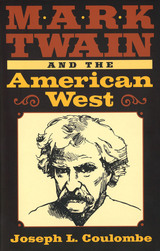 Mark Twain and the American West
Joseph L. Coulombe
University of Missouri Press, 2003 In Mark Twain and the American West, Joseph Coulombe explores how Mark Twain deliberately manipulated contemporary conceptions of the American West to create and then modify a public image that eventually won worldwide fame. He establishes the central role of the western region in the development of a persona that not only helped redefine American manhood and literary celebrity in the late nineteenth century, but also produced some of the most complex and challenging writings in the American canon. Coulombe sheds new light on previously underappreciated components of Twain’s distinctly western persona. Gathering evidence from contemporary newspapers, letters, literature, and advice manuals, Coulombe shows how Twain’s persona in the early 1860s as a hard-drinking, low-living straight-talker was an implicit response to western conventions of manhood. He then traces the author’s movement toward a more sophisticated public image, arguing that Twain characterized language and authorship in the same manner that he described western men: direct, bold, physical, even violent. In this way, Twain capitalized upon common images of the West to create himself as a new sort of western outlaw—one who wrote. Coulombe outlines Twain’s struggle to find the proper balance between changing cultural attitudes toward male respectability and rebellion and his own shifting perceptions of the East and the West. Focusing on the tension between these goals, Coulombe explores Twain’s emergence as the moneyed and masculine man-of-letters, his treatment of American Indians in its relation to his depiction of Jim in Adventures of Huckleberry Finn, the enigmatic connection of Huck Finn to the natural world, and Twain’s profound influence on Willa Cather’s western novels. Mark Twain and the American West is sure to generate new interest and discussion about Mark Twain and his influence. By understanding how conventions of the region, conceptions of money and class, and constructions of manhood intersect with the creation of Twain’s persona, Coulombe helps us better appreciate the writer’s lasting effect on American thought and literature through the twentieth century and into the twenty-first.
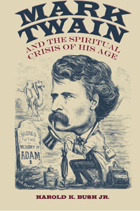 Mark Twain and the Spiritual Crisis of His Age
Harold K. Bush
University of Alabama Press, 2007 The writer’s fascination with America’s spiritual and religious evolution in the 19th century. Mark Twain is often pictured as a severe critic of religious piety, shaking his fist at God and mocking the devout. Such a view, however, is only partly correct. It ignores the social realities of Twain’s major period as a writer and his own spiritual interests: his participation in church activities, his socially progressive agenda, his reliance on religious themes in his major works, and his friendships with clergymen, especially his pastor and best friend, Joe Twichell. It also betrays a conception of religion that is more contemporary than that of the period in which he lived. Harold K. Bush Jr. highlights Twain’s attractions to and engagements with the wide variety of religious phenomena of America in his lifetime, and how these matters affected his writings. Though Twain lived in an era of tremendous religious vigor, it was also a time of spiritual upheaval and crisis. The rise of biological and psychological sciences, the criticism of biblical texts as literary documents, the influx of world religions and immigrant communities, and the trauma of the Civil War all had dramatic effects on America’s religious life. At the same time mass urban revivalism, the ecumenical movement, Social Christianity, and occultic phenomena, like spiritualism and mind sciences, all rushed in to fill the voids. The rapid growth of agnosticism in the 1870s and 1880s is also clearly reflected in Twain’s life and writings. Thus Twain’s career reflects in an unusually resonant way the vast changes in American belief during his lifetime. Bush’s study offers both a new and more complicated understanding of Twain and his literary output and serves as the cultural biography of an era.
|
|


